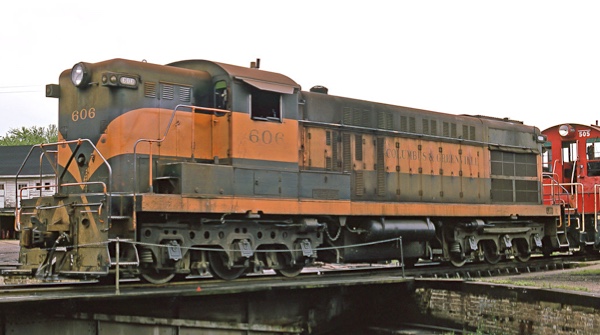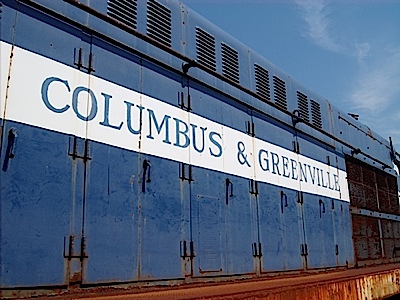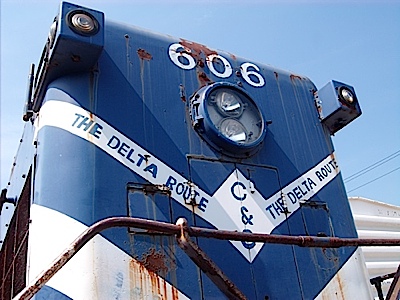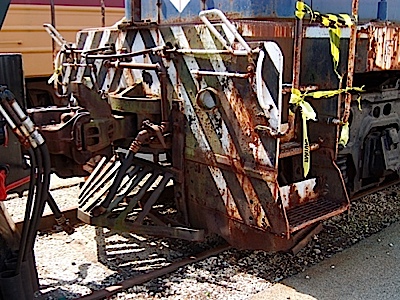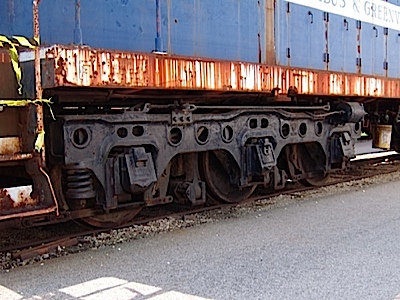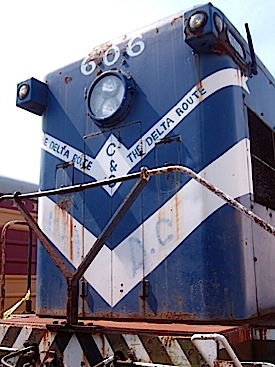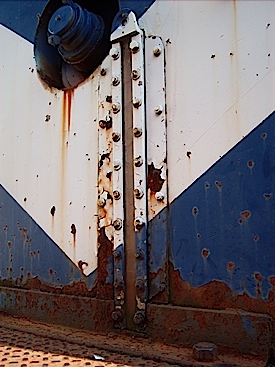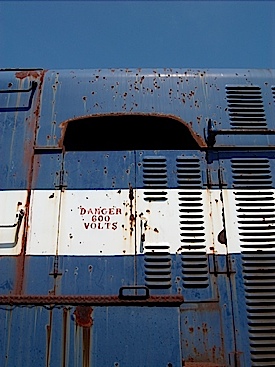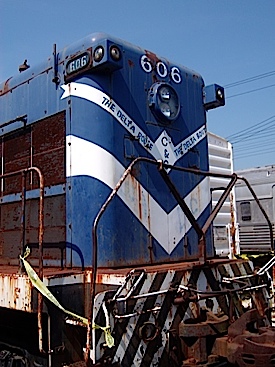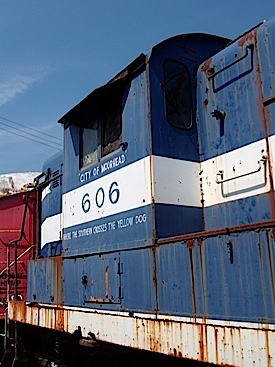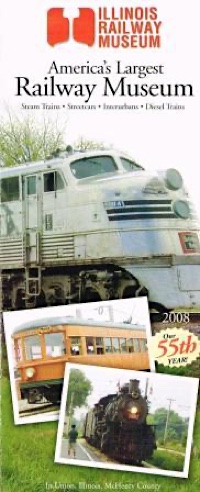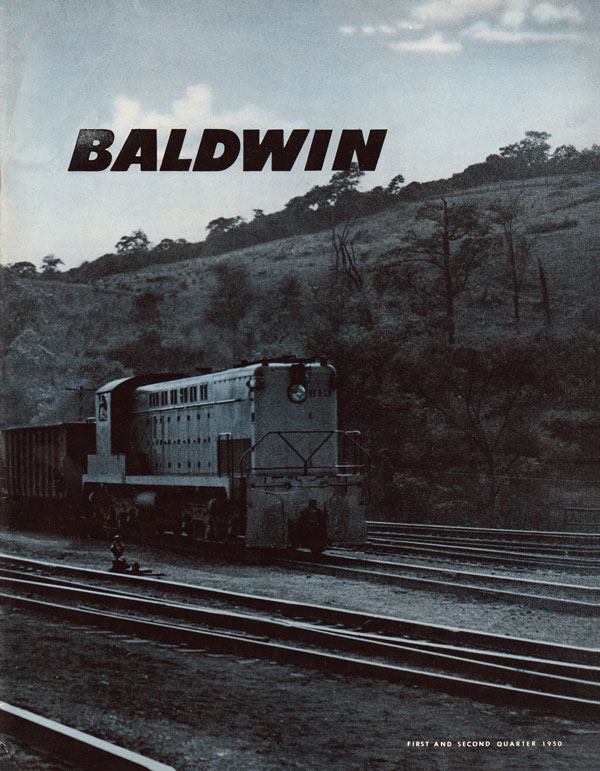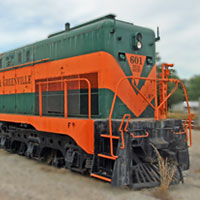 |
Columbus & Greenville Railway Baldwin Road Switchers |

Because of the age of the [steam] locomotive fleet, conversion to diesel power had been discussed as early as 1938. The success of the Brill gas-electric cars had been encouraging, and clearly new locomotives would soon be required as the current roster required an increasing amount of maintenance. The acquisition of good used [steam] locomotives from 1938 to 1940 eased the immediate problems and then the war put all further acquisitions out of the question. But when the war was over, Master Mechanic W. A. Trayler again began to consider new locomotives.
Louis R. Saillard — Delta Route: A History of the Columbus & Greenville Railway, 1981
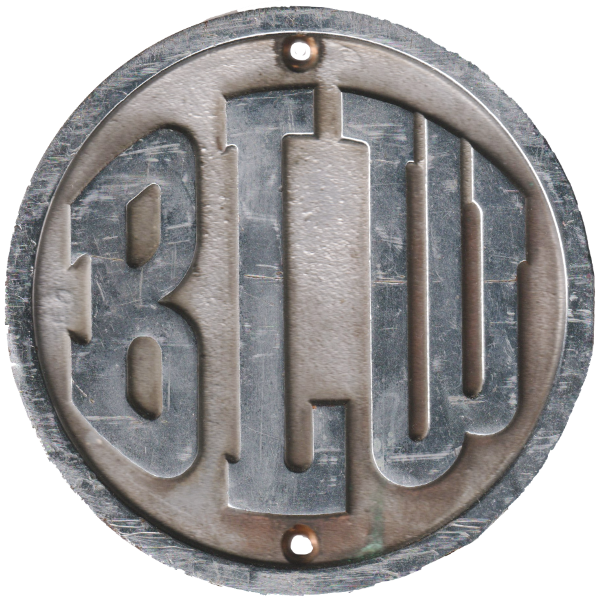 The unflappable Columbus & Greenville survived the steam era on a large stable of second and third-hand locomotives. As such, the transition to diesel-electric motive power begun in 1945 represented the first time the Mississippi shortline was able to acquire first-hand propulsion. Limited in production on the heels of the war, no Alco or General Motors designs suited the railroad at the time the Delta Route went shopping. The railroad turned instead to Baldwin Locomotive Works for a road switcher of appropriate weight and power. By the end of 1946, a total of five Baldwin "DRS" models were in service on the shortline: each one rather at 1500 horsepower, carrying 4 traction motors, and equipped with 6 axles for easing the strain on the shortline's feeble track and bridges. These A1A-A1A movers quickly sidelined the remaining steamers, used alone or in lashups—thanks to Baldwin's proprietary pneumatic MU system. Five years later, an additional Baldwin of nearly identical design and power was purchased to round out the stable. Though not perfect products, the Baldwins nevertheless brought a level of dependability and service previously unknown on the long east-west Magnolia mainline. Except for #602 — wrecked in a 1961 derailment — the Baldwin roster stayed in service on the Delta Route well into the 1970s, with the first and last units remaining active into the 1980s. Those two, Nos. 601 and 606, are the only survivors. The former remains on display outside the Columbus roundhouse; the latter is living out retirement at the Illinois Railway Museum.
The unflappable Columbus & Greenville survived the steam era on a large stable of second and third-hand locomotives. As such, the transition to diesel-electric motive power begun in 1945 represented the first time the Mississippi shortline was able to acquire first-hand propulsion. Limited in production on the heels of the war, no Alco or General Motors designs suited the railroad at the time the Delta Route went shopping. The railroad turned instead to Baldwin Locomotive Works for a road switcher of appropriate weight and power. By the end of 1946, a total of five Baldwin "DRS" models were in service on the shortline: each one rather at 1500 horsepower, carrying 4 traction motors, and equipped with 6 axles for easing the strain on the shortline's feeble track and bridges. These A1A-A1A movers quickly sidelined the remaining steamers, used alone or in lashups—thanks to Baldwin's proprietary pneumatic MU system. Five years later, an additional Baldwin of nearly identical design and power was purchased to round out the stable. Though not perfect products, the Baldwins nevertheless brought a level of dependability and service previously unknown on the long east-west Magnolia mainline. Except for #602 — wrecked in a 1961 derailment — the Baldwin roster stayed in service on the Delta Route well into the 1970s, with the first and last units remaining active into the 1980s. Those two, Nos. 601 and 606, are the only survivors. The former remains on display outside the Columbus roundhouse; the latter is living out retirement at the Illinois Railway Museum.
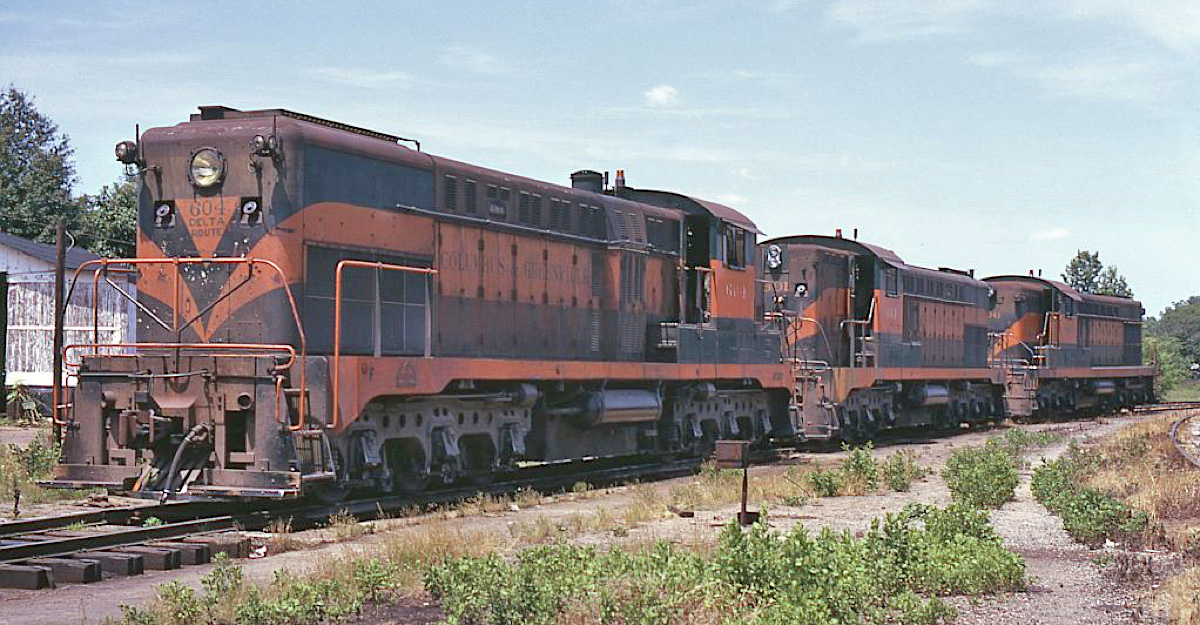
Columbus, Ms / Jun 1974 / Doug Leffler
 Philadelphia Firsts
Philadelphia Firsts
The Columbus & Greenville's order of five units from the Baldwin Locomotive Works, based in Philadelphia, turned out to be historic in the world of diesel-electric locomotion. Nos. 601 to 605 were the first batch of Baldwin road switchers produced for any stateside customer, and #601 itself was one of the first diesel-electric locomotive of the road switcher configuration by any builder to be placed in domestic operation. #601 was shipped to the Delta first, unpainted and unlettered, followed by factory-decorated sisters #602 and #603 two months later. Shown first below is a rare view of #601, unlettered and in factory green, shown during break-in runs out of Columbus. Next are official builder's photos for #601 taken in Columbus, after painting and lettering onsite. A Baldwin publicity photo follows, featuring #601 in action on a local freight out of Columbus. By contrast, builder's photos for #603 (bottom) and sisters were made in Philadelphia before shipment south.
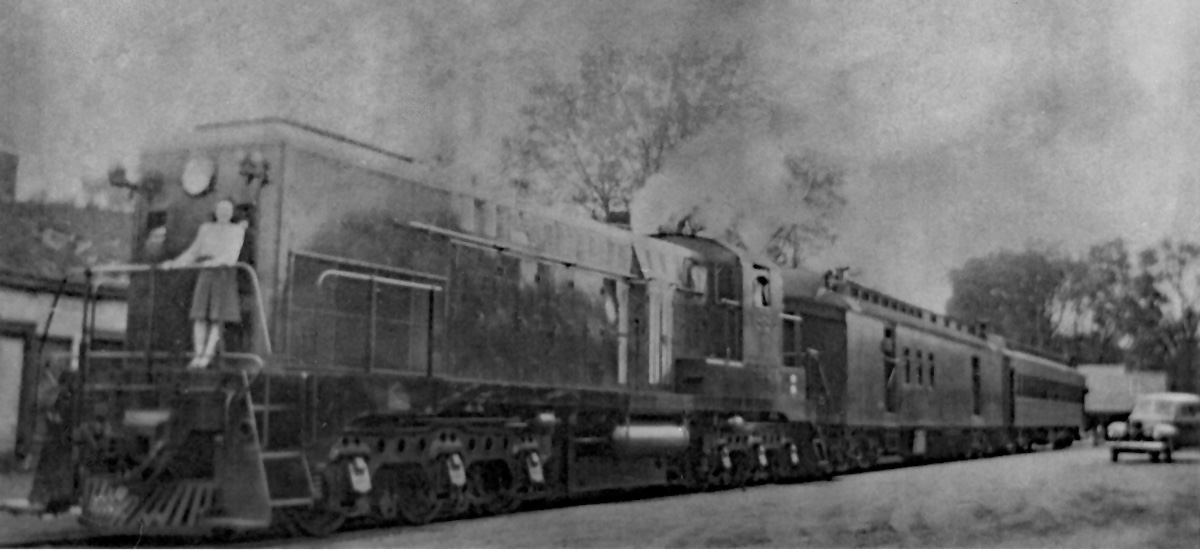
Columbus & Greenville #601
early break-in run / Columbus, Ms / fall 1946 / collection

Baldwin Heavy Road Switchers
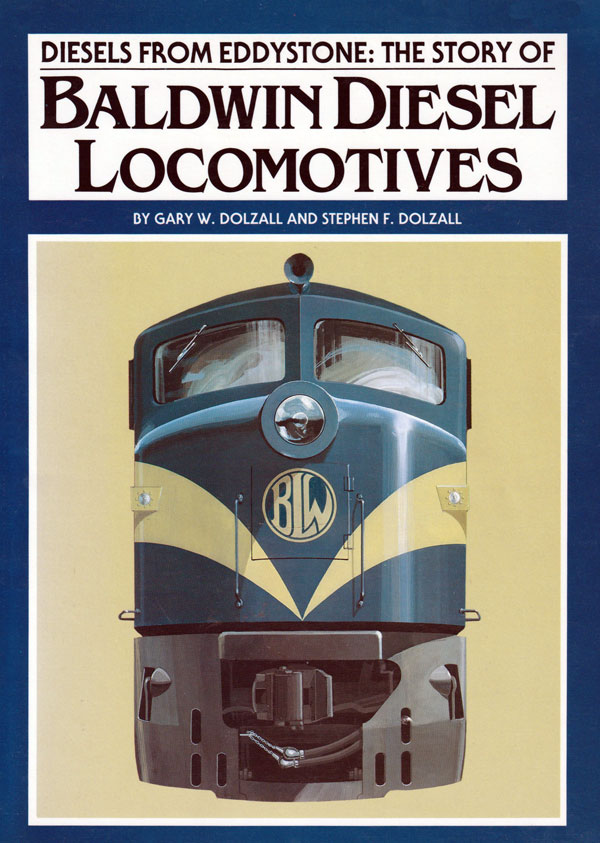 Following the 1941 debut of Alco-GE's RS1, the railroad industry began to take notice of the advantages of road-switchers. These utilitarian diesels eliminated the need to turn locomotives at the ends of runs (or to have cab- equipped units at each end of a multiple-unit set), and could work main lines, branches, and even yards. The only real limit to the RS1 was that it was actually a light road-switcher with but modest power (1000 h.p.). After the interruption of World War Two both Alco-GE and Baldwin stood ready to up the ante in the road-switcher race by introducing heavy-duty, 1500-h.p. units.
Following the 1941 debut of Alco-GE's RS1, the railroad industry began to take notice of the advantages of road-switchers. These utilitarian diesels eliminated the need to turn locomotives at the ends of runs (or to have cab- equipped units at each end of a multiple-unit set), and could work main lines, branches, and even yards. The only real limit to the RS1 was that it was actually a light road-switcher with but modest power (1000 h.p.). After the interruption of World War Two both Alco-GE and Baldwin stood ready to up the ante in the road-switcher race by introducing heavy-duty, 1500-h.p. units.
Baldwin's introduction of heavy road-switchers had its roots in design work conducted in 1944. With the end of the war and development of the 1500-h.p. 608SC engine, those plans were ready to bear fruit. In 1945 W. A. Trayler, master mechanic of the 168-mile Columbus & Greenville Railway in Mississippi, had decided to dieselize, and he believed the best unit for the C&G would be a 1500-h.p. model with six axles to distribute weight, four of which would be powered (the line included spindly trestles and light, 60- pound rail). Because the units would serve as switchers as well as road engines, a bidirectional road-switcher design was called for.
Gary Dolzall and Stephen Dolzall — Diesels from Eddystone: The Story of Baldwin Diesel Locomotives
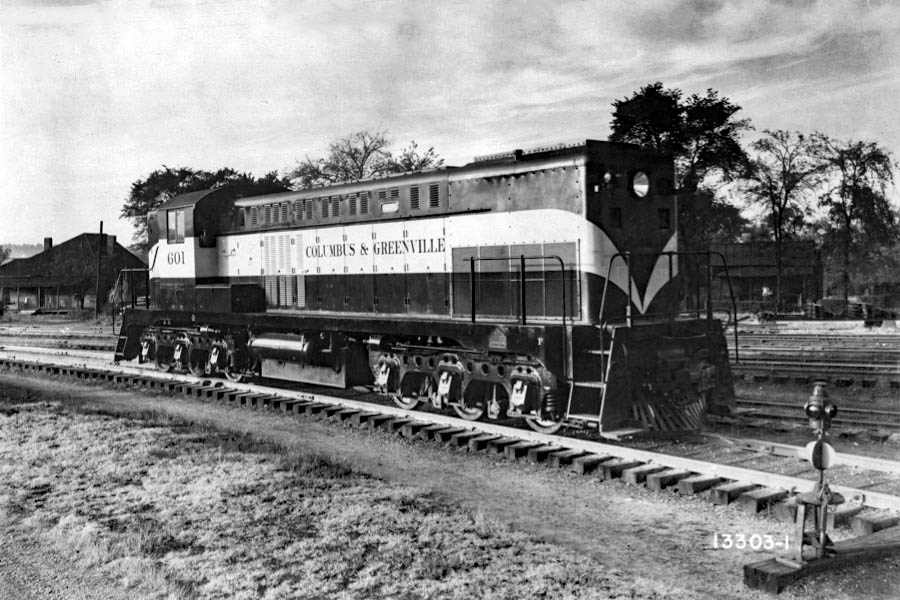
Baldwin builder's photo / Columbus, Ms / 1946 collection
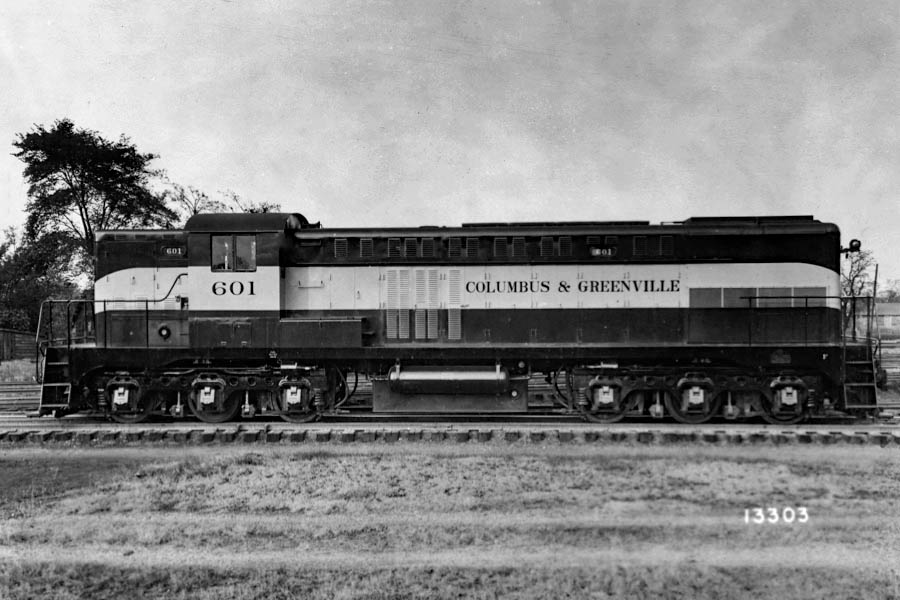
Baldwin builder's photo / Columbus, Ms / 1946 collection
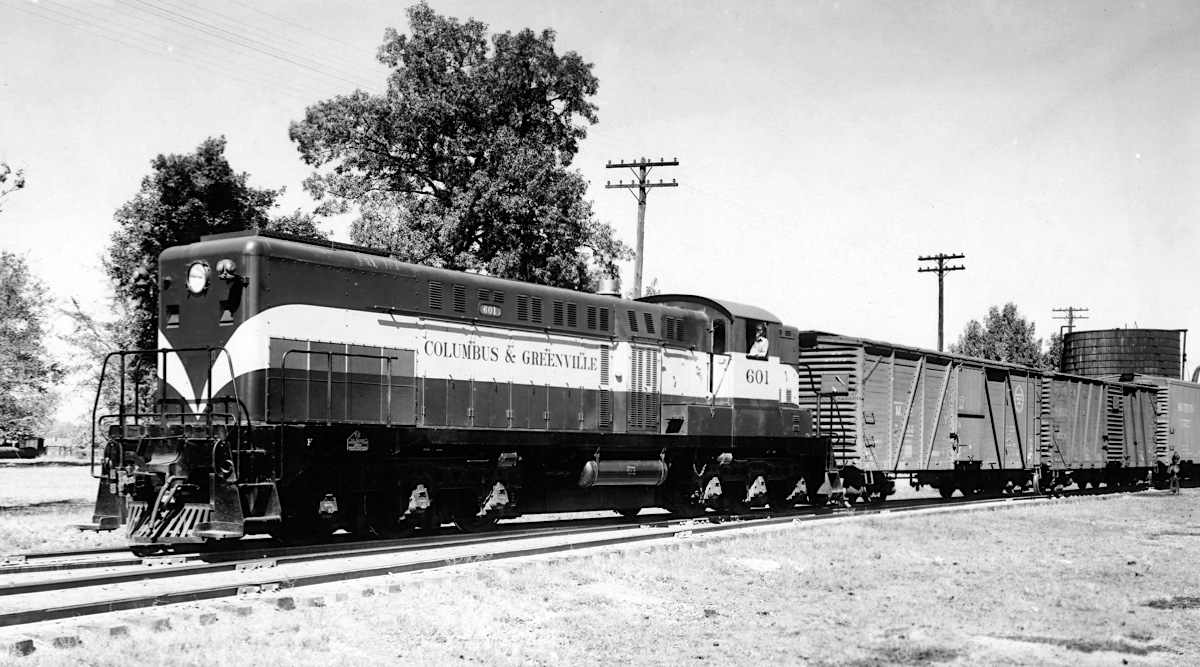
Baldwin publicity photo / Columbus, Ms / c. 1947 / collection

Baldwin's answer to Trayler and the C&G was the DRS-6-4-1500 (A1A-A1A) road-switcher. Trayler was sold (he had also contacted EMD and Alco-GE, but received no firm bid from either), and on September 19, 1945, the C&G ordered five units. The locomotives would be plain-vanilla diesels — no m.u., steam generators, or dynamic brakes. Each would cost $117,500, and Eddystone promised the first 80 for testing in January 1946 (delays would postpone delivery until late 1946).
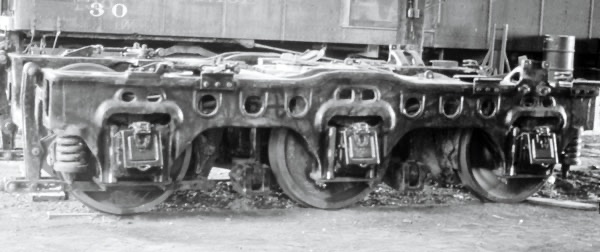 Baldwin's new DRS-6-4-1500 called for the 608SC engine to be mated to a Westinghouse main generator, which in turn would drive four Westinghouse 370-series traction motors in General Steel Castings' Commonwealth AlA trucks. GSC also supplied the frame, a cast design, with fabricated side members welded in place by Baldwin. The side members were blended into the steps at each end of the locomotive, and the steps and pilots were fabricated assemblies, bolted on.
Baldwin's new DRS-6-4-1500 called for the 608SC engine to be mated to a Westinghouse main generator, which in turn would drive four Westinghouse 370-series traction motors in General Steel Castings' Commonwealth AlA trucks. GSC also supplied the frame, a cast design, with fabricated side members welded in place by Baldwin. The side members were blended into the steps at each end of the locomotive, and the steps and pilots were fabricated assemblies, bolted on.
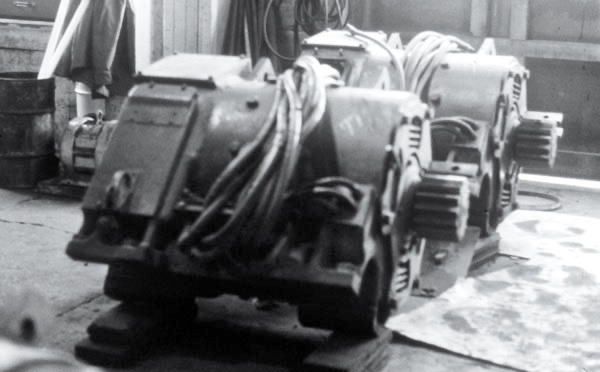 The cab was over the rear truck (the long hood was considered to be "front"), and the electrical cabinet was between the cab and power plant, which had its generator end toward the cab. On the front of the frame stood a 300-gallon cooling system. Air intakes for the cooling system and traction motor blowers were side-mounted at the front of the long hood, just above frame level. A pair of electrically driven fans on top of the hood exhausted engine cooling air, and automatic shutters controlled cooling system temperature. The short rear hood had several possible uses. One was to house an 800-gallon fuel tank to supplement or replace a 1000-gallon underbelly tank (actually, the 800-gallon tank became standard equipment and the 1000-gallon tank optional). Another was to house dynamic braking equipment, with side-mounted resistor grids and top-mounted air exhaust. Yet another short-hood option was a steam generator. In units equipped for steam heating, both the 1000-gallon un- derbelly tank and the 800-gallon hood tank would be used, one for diesel fuel, the other for water; the customer would choose. The unit could not be equipped with both dynamic brakes and a steam generator.
The cab was over the rear truck (the long hood was considered to be "front"), and the electrical cabinet was between the cab and power plant, which had its generator end toward the cab. On the front of the frame stood a 300-gallon cooling system. Air intakes for the cooling system and traction motor blowers were side-mounted at the front of the long hood, just above frame level. A pair of electrically driven fans on top of the hood exhausted engine cooling air, and automatic shutters controlled cooling system temperature. The short rear hood had several possible uses. One was to house an 800-gallon fuel tank to supplement or replace a 1000-gallon underbelly tank (actually, the 800-gallon tank became standard equipment and the 1000-gallon tank optional). Another was to house dynamic braking equipment, with side-mounted resistor grids and top-mounted air exhaust. Yet another short-hood option was a steam generator. In units equipped for steam heating, both the 1000-gallon un- derbelly tank and the 800-gallon hood tank would be used, one for diesel fuel, the other for water; the customer would choose. The unit could not be equipped with both dynamic brakes and a steam generator.
Gary Dolzall and Stephen Dolzall — Diesels from Eddystone: The Story of Baldwin Diesel Locomotives
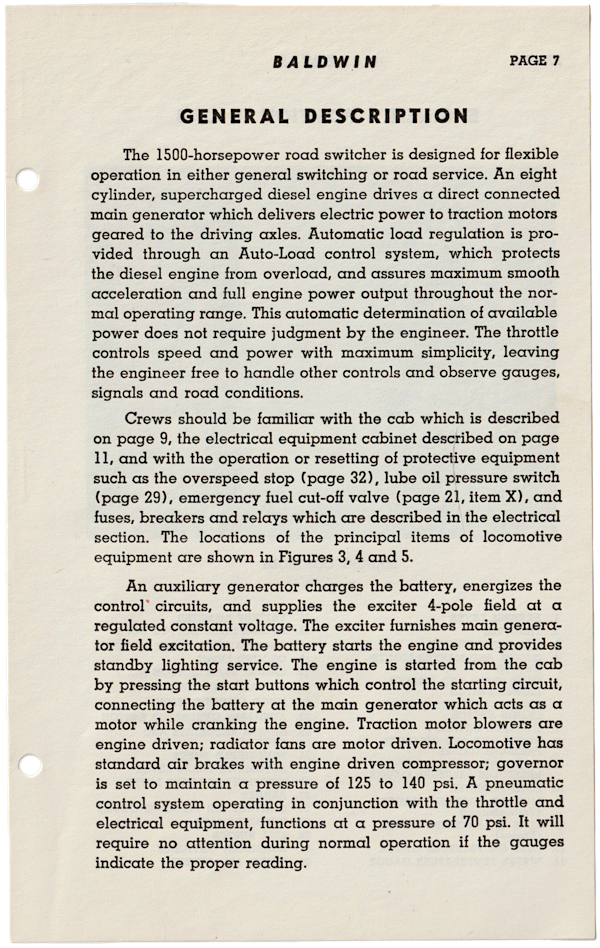
Baldwin Operator's Manual / collection
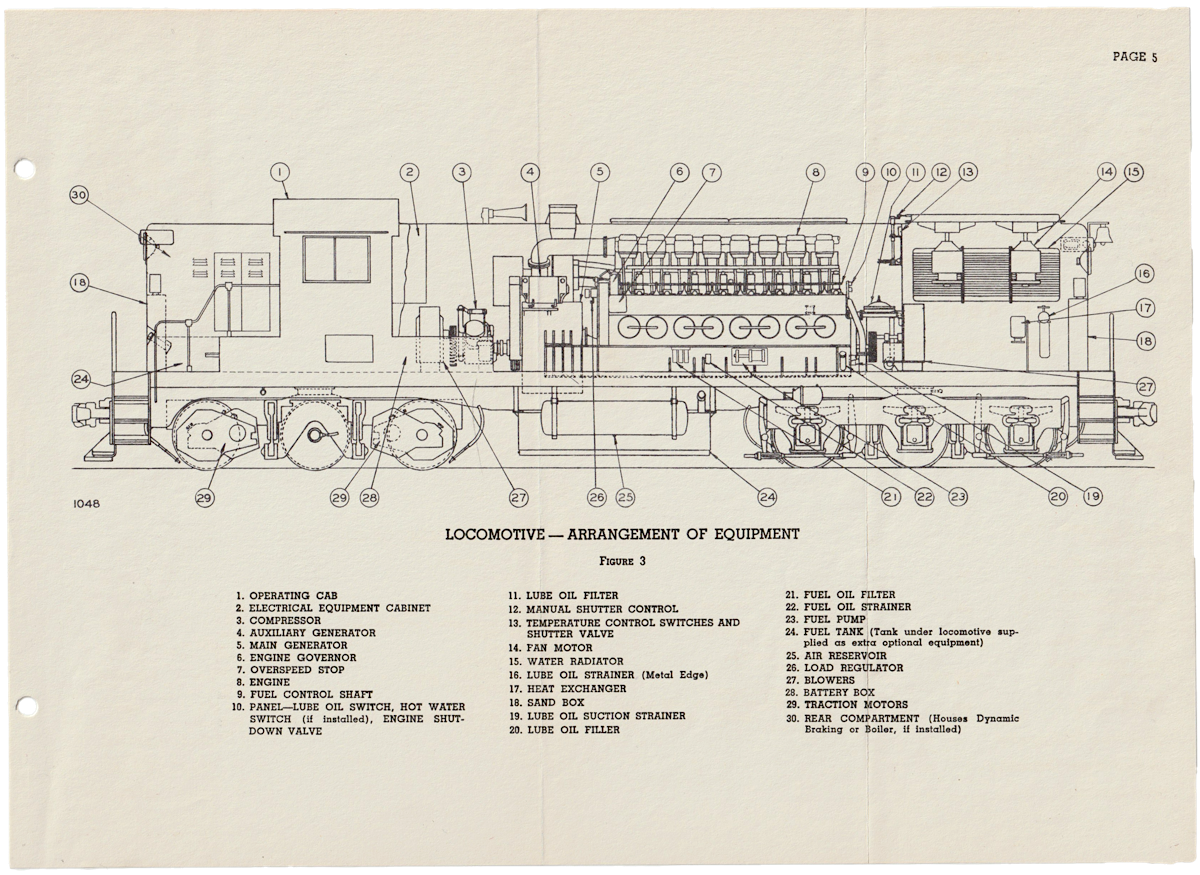
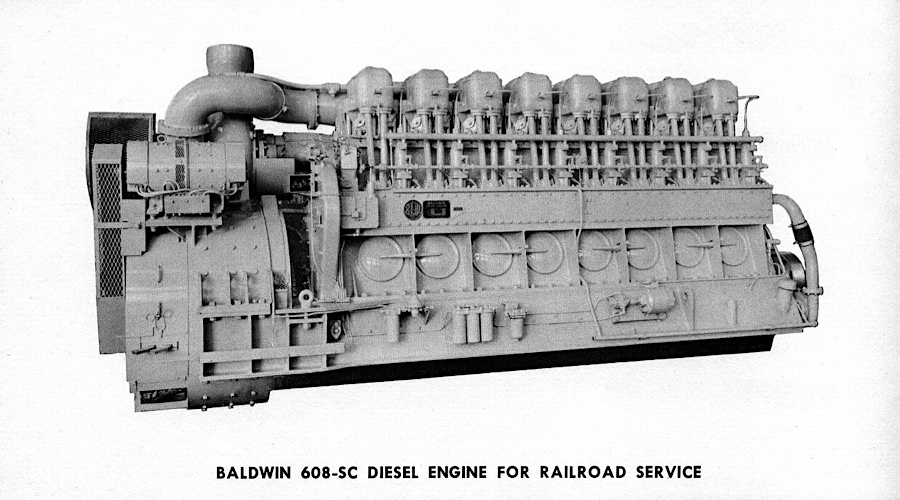

Eddystone built the first Columbus & Greenville unit — No. 601 — and the first DRS-6-4-1500 for French North Africa — No. 040-DA-1 — together in mid-1946. When completed, C&G 601 weighed 280,000 pounds, with 187,000 pounds on drivers. The locomotive measured 58' long inside coupler knuckles, stood 14' tall, and was 10' wide. It was capable of exerting 42,800 pounds of continuous tractive effort (at 10.5 mph), and with its 15:63 gearing could sprint to 65 mph. Only minor modifications made for foreign conditions — low-clearance cab, left-hand drive, pilot-mounted headlamps, and coupling buffers — set the first export DRS-6-4-1500 apart from its American sister.
C&G 601 departed Eddystone in September 1946, eight months after its promised delivery date. At that, because of labor problems the landmark locomotive was rushed out of the shops painted solid green. C&G 601 arrived at Columbus, Mississippi, and was placed in service on October 8, 1946. The purchase contract specified that the first locomotive would have to be accepted by the road before further deliveries were made, and as a result the next unit — No. 602 — did not depart Eddystone until December 10, 1946. C&G 603 followed two days later and all five locomotives were in service by January 22, 1947.
Gary Dolzall and Stephen Dolzall — Diesels from Eddystone: The Story of Baldwin Diesel Locomotives
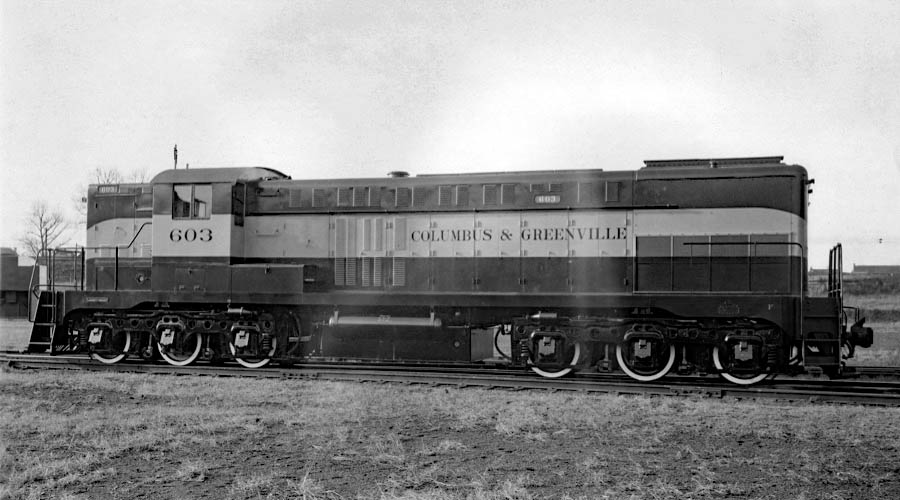
Columbus & Greenville #603
Baldwin builder's photo / Philadelphia, Pa / Nov 1946 / collection
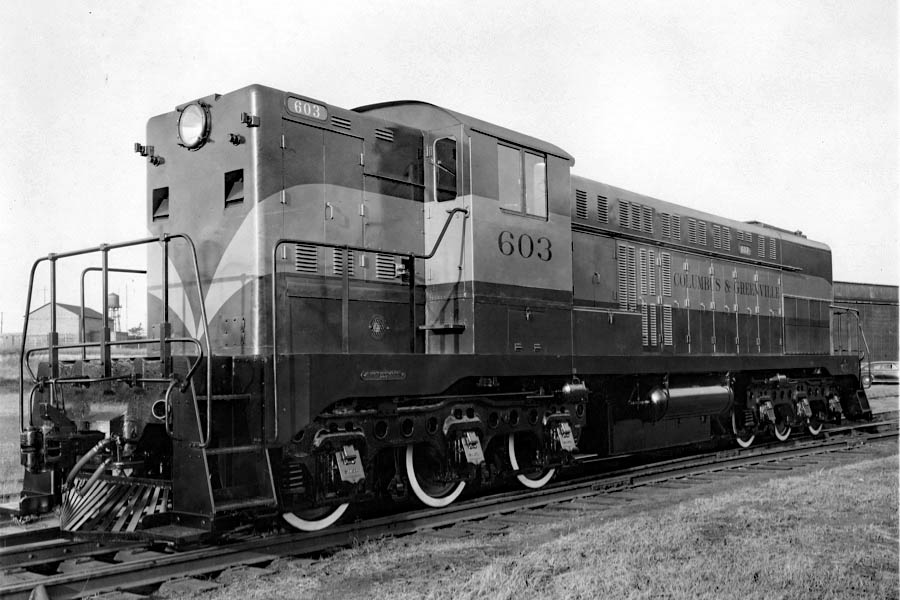
Baldwin builder's photo / Philadelphia, Pa / Nov 1946 / collection

RWH

Baldwin Operator's Manual / collection
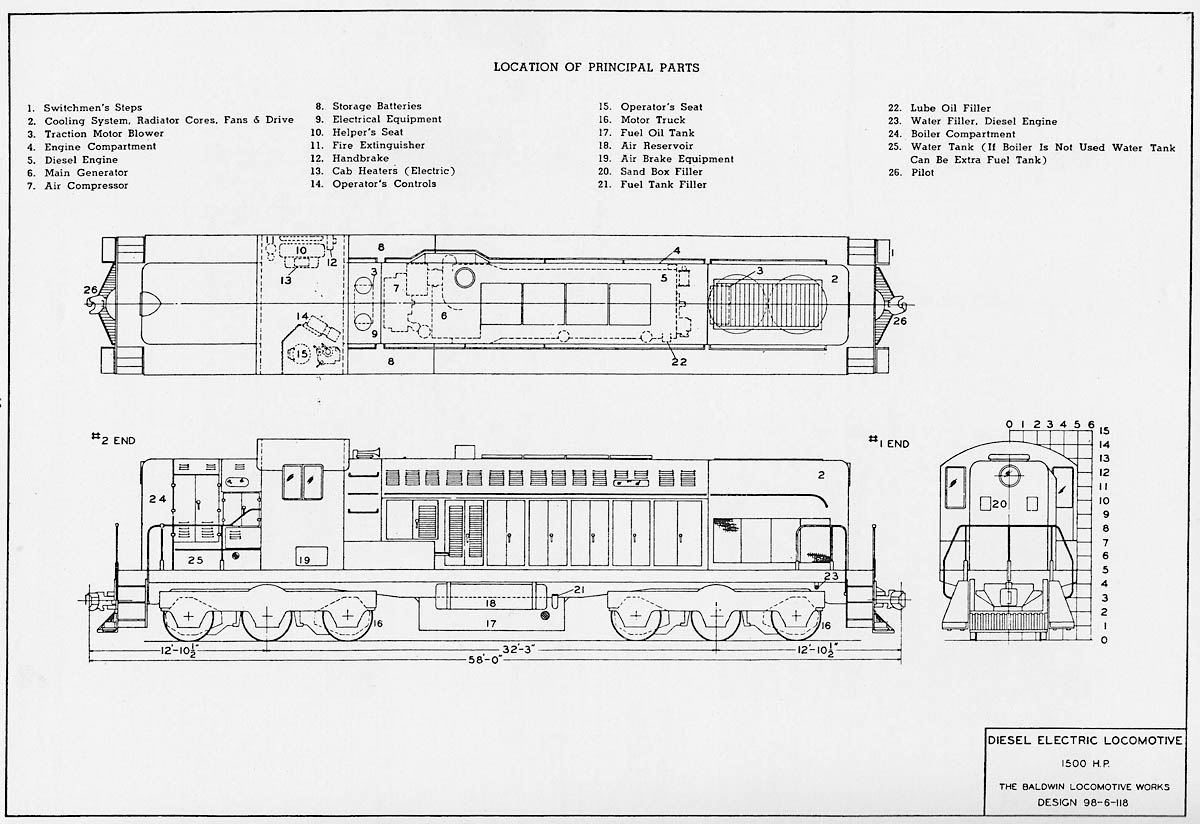
Baldwin construction drawing / collection
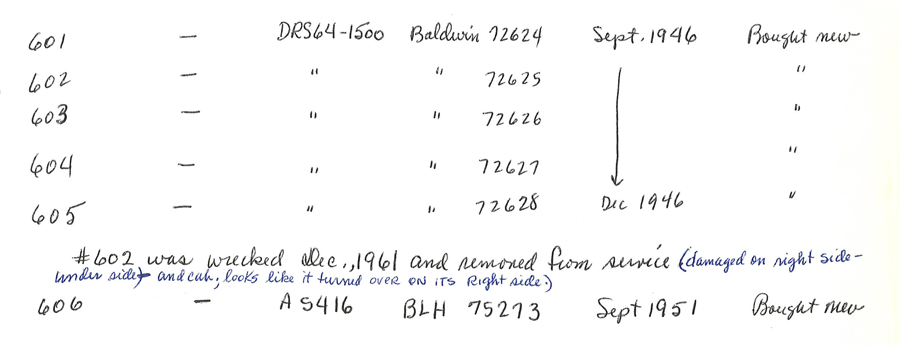
Baldwin roster notes / JCH
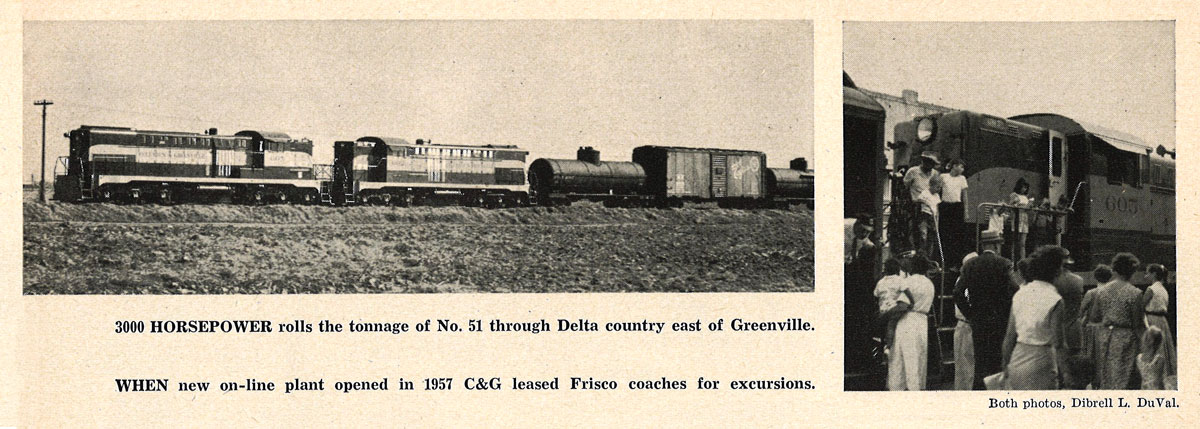
from TRAINS Magazine
- Sep 1958 / collection
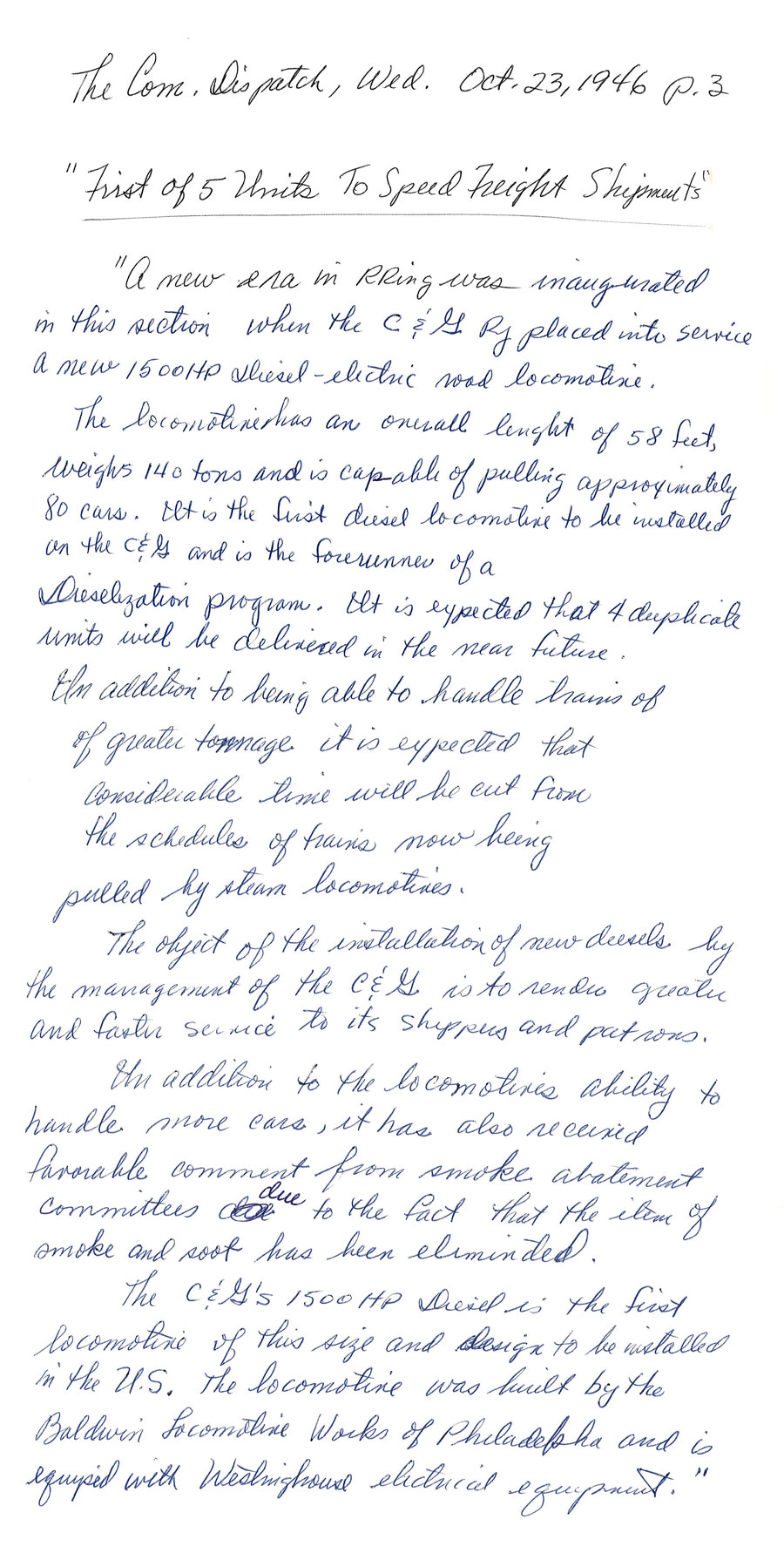
transcription of Columbus Commercial-Dispatch newspaper article - Oct 1946 / JCH
HawkinsRails thanks Delta Route friends Gerhard Anderson, Doug Leffler, Michael Palmieri, David Powell, and Louis Saillard for use of their Baldwin photographs on this page

#601
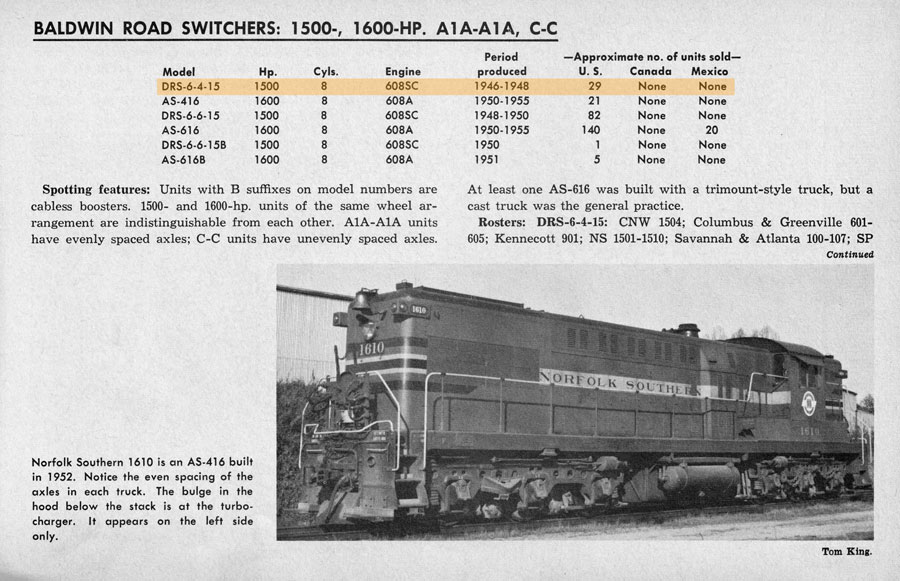
from Diesel Spotter's Guide
- Jerry Pinkepank - 1967 / collection
Although the Columbus & Greenville led the way in purchasing Baldwin's first domestic road switcher, other lines followed. DRS 6-4-1500 customers included the original Norfolk Southern, the Savannah & Atlanta, Chicago & North Western, Kennecott Copper, Southern Pacific, and Union Pacific (who purchased Baldwin's DRS demonstrator).

 UNCOMMON or UNUSUAL locomotive
UNCOMMON or UNUSUAL locomotive

Columbus & Greenville #601
Columbus, Ms / c. 1947 / collection


Columbus & Greenville #601
on display, Columbus MS
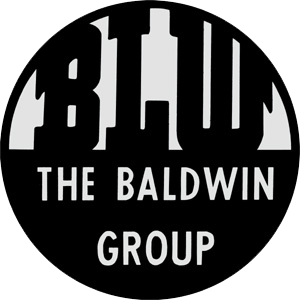

Columbus, Ms / Jun 1972 / JCH
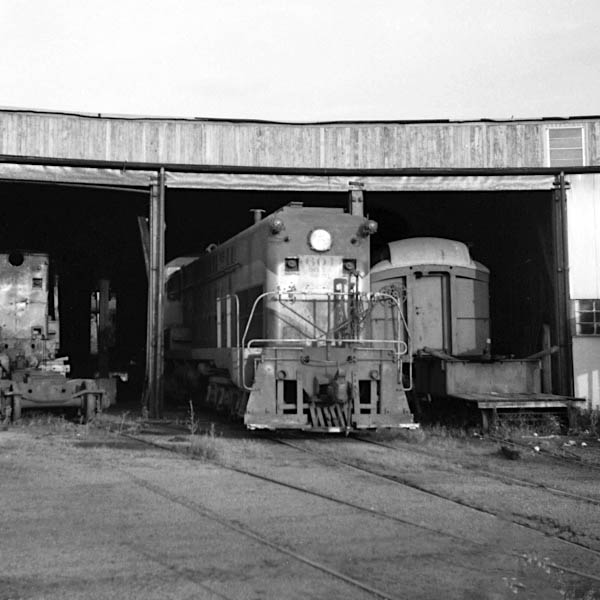
Columbus, Ms / Jun 1972 / JCH
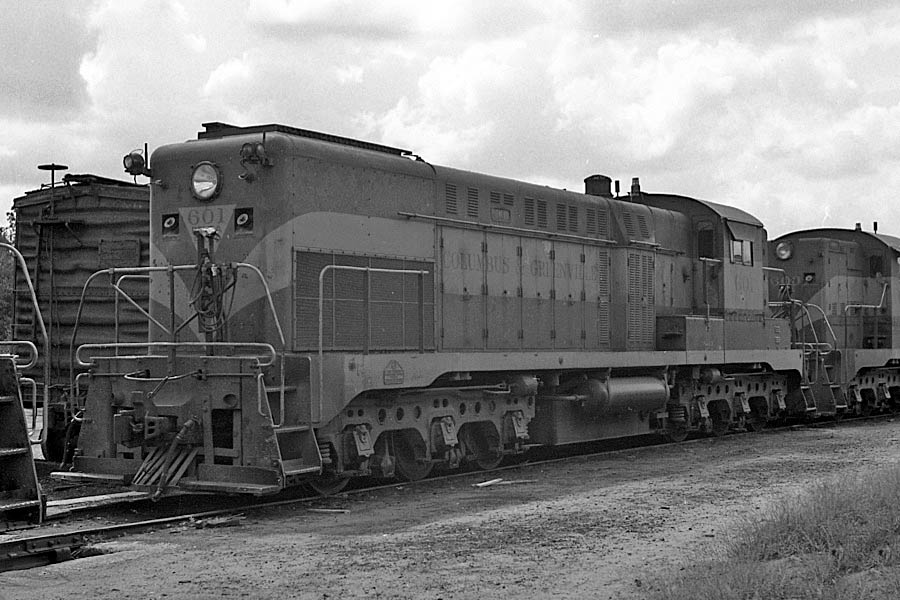
Columbus, Ms / Sep 1969 / JCH
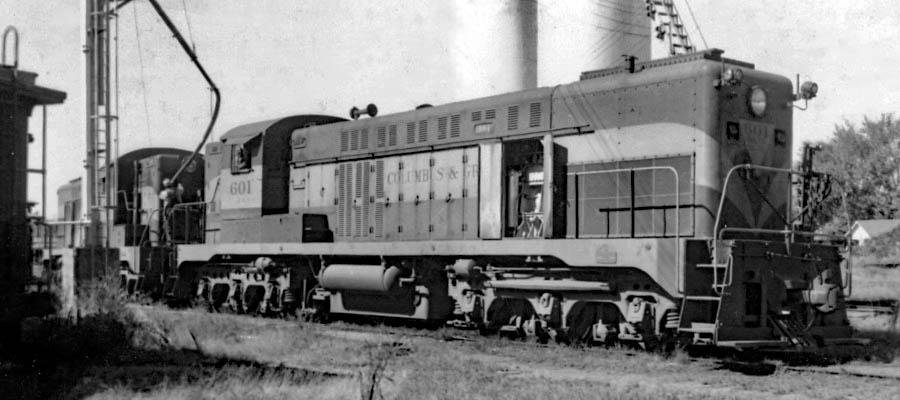
Columbus, Ms / Feb 1963 / collection

Columbus, Ms / collection
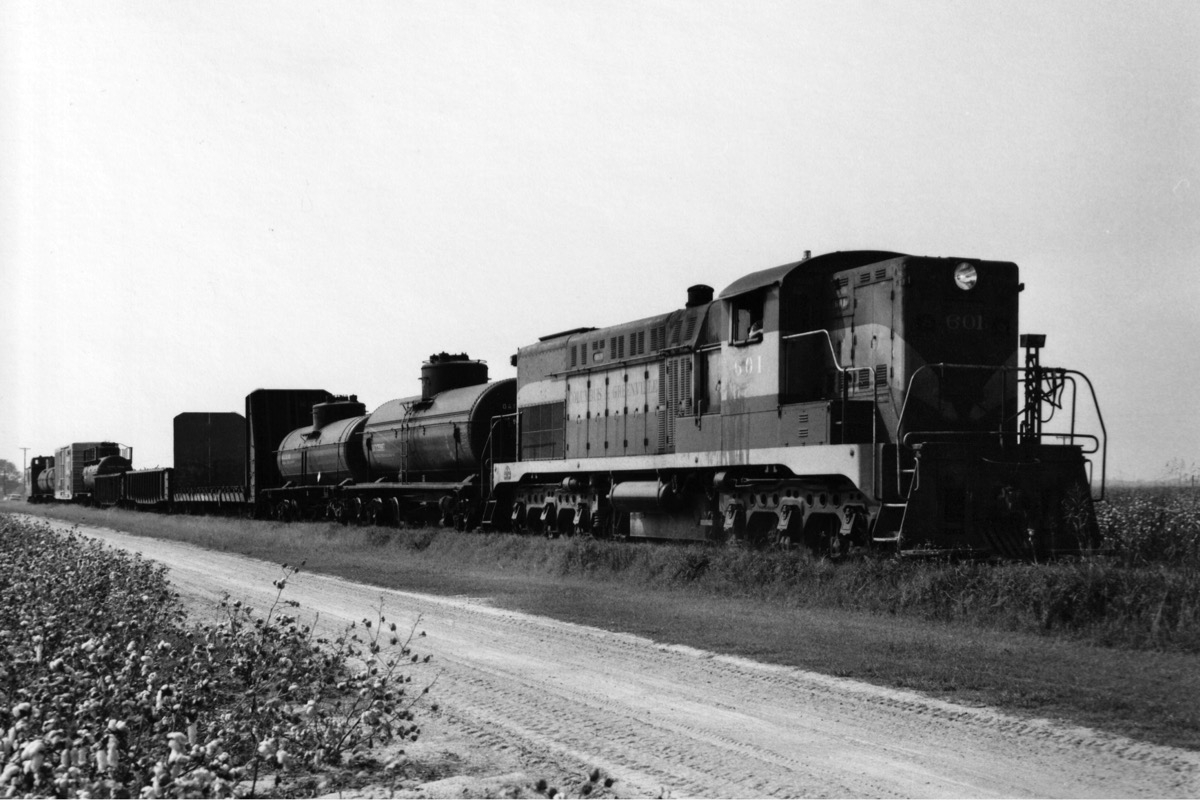
Greenwood, Ms / Sep 1972 / collection

THE SLACK rolled out on No. 51; the train was taut for a pause of seconds, then it slowly began to move. From the caboose Conductor W. F. Ussery gave the official highball and a blast from the air horn answered. McDaniel hauled back on the throttle. The engine rpm seemed to gain only a little, but the whine of the supercharger and the heavy, hoarse chugging at the exhaust stack indicated that the power was really on. Nobody can say that a Baldwin diesel "revs up." From an idling speed of 365 rpm the engine climbs to only 625 at full horsepower. But it moves trains just the same, and the sound contains elements of a Model A Ford under load, with the supercharger adding a quality of outer space.
Dibrell L. Du Val - 1958

Heathman, Ms / Sep 1972 / collection

Columbus, Ms / 1973 / collection
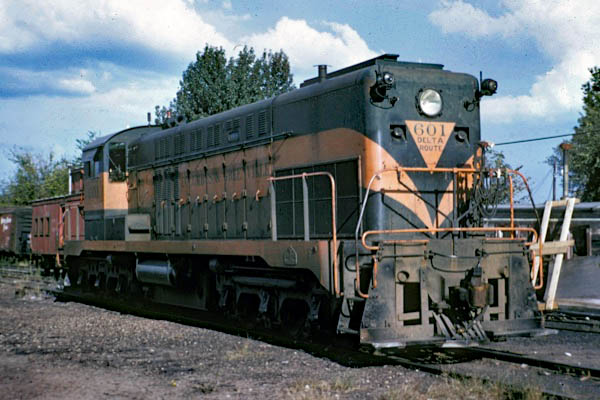
Columbus, Ms / 1974 / collection

Columbus, Ms / Jun 1974 / Doug Leffler
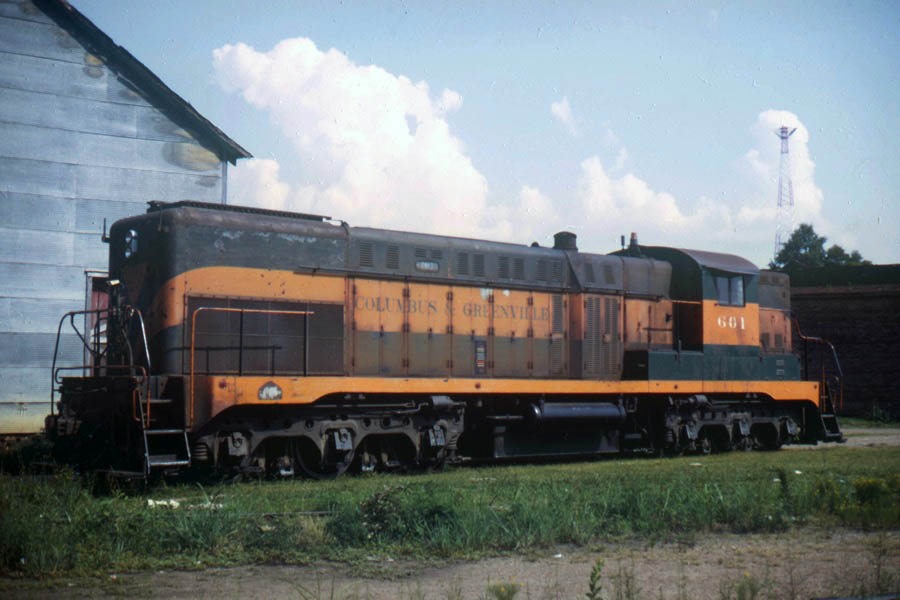
West Point, Ms / Jul 1975 / collection

Columbus, Ms / 1977 / collection

Columbus, Ms / Oct 1980 / Michael Palmieri
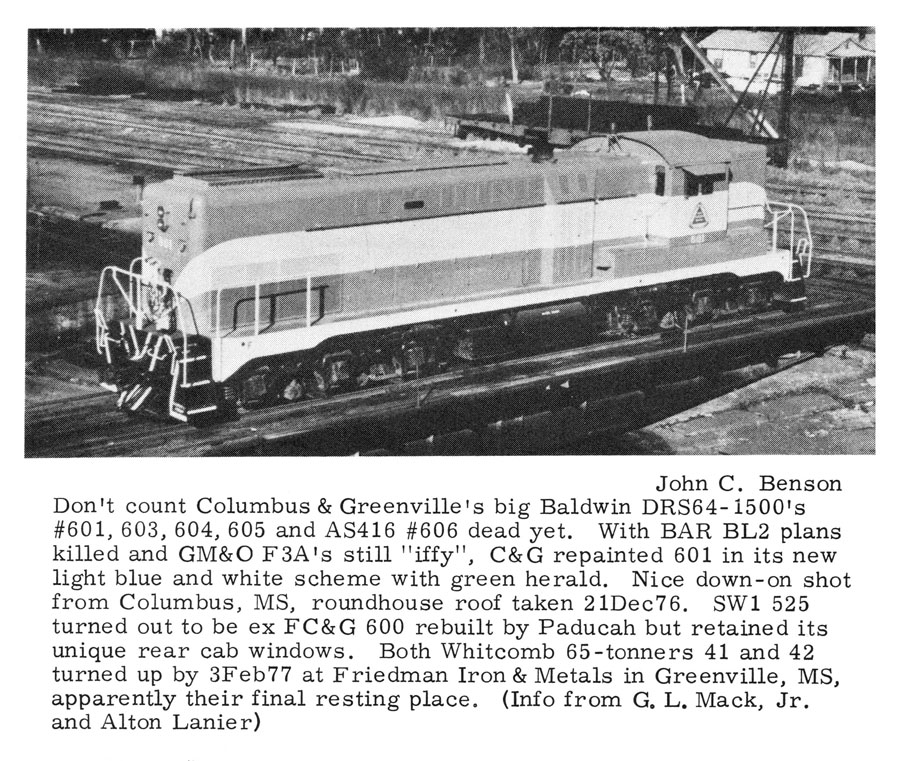
from Extra 2200 South
#59 - Jan 1977 / collection
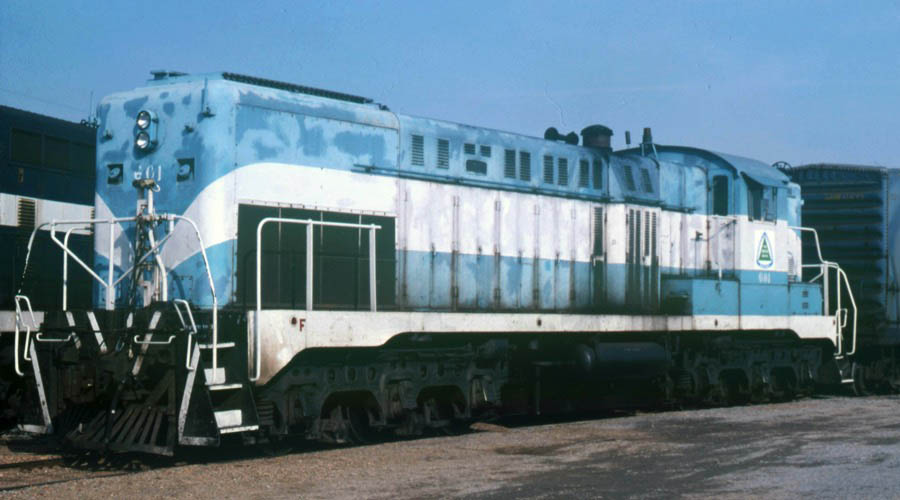
Columbus, Ms / Feb 1982 / collection
 Baldwin #601 on Display
Baldwin #601 on Display

Jun 2020 / RWH

Columbus, Ms / Jul 1986 / JCH
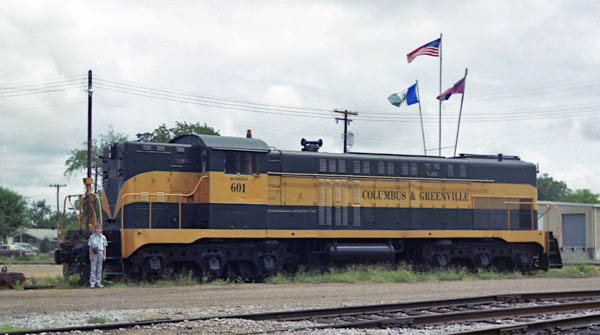
Columbus, Ms / Jul 1986 / JCH

Columbus, Ms / Jul 1986 / JCH
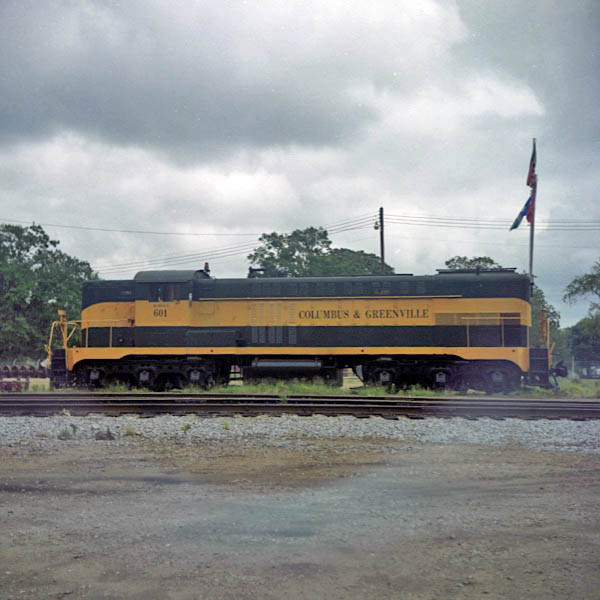
Columbus, Ms / Jul 1986 / JCH
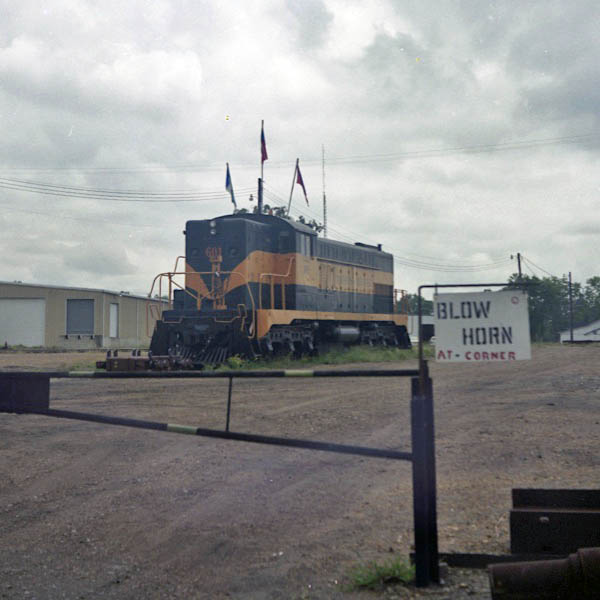
Columbus, Ms / Jul 1986 / JCH
 Marker Dedication
Marker Dedication
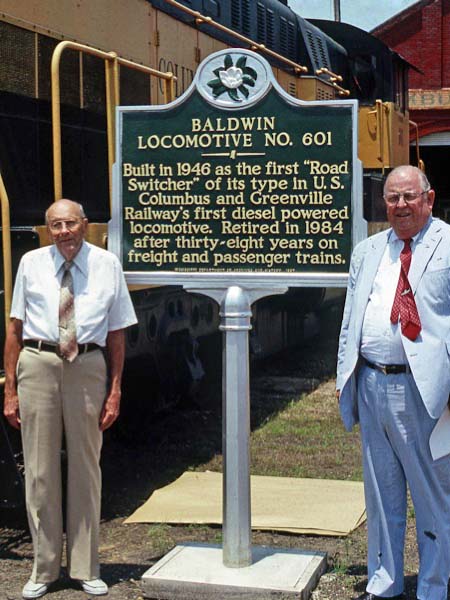
Jun 1987 / David Hurt

In the summer of 1987, the Columbus & Greenville dedicated the Baldwin #601 display outside the Columbus shops with the placement of a Mississippi Department of Archives and History historial marker, noting the locomotive's important place in diesel-electric history. Pictured below is the moment of unveiling the new marker; to the right, a close-up of Mr. W. A. Traylor Jr. (then retired C&G Master Mechanic) and Mr. Sam Y. Wilhite (then president of the CAGY). HawkinsRails thanks railfan friend David Hurt for use of his wonderful photos capturing this important event.

Columbus, Ms / Jun 1987 / David Hurt
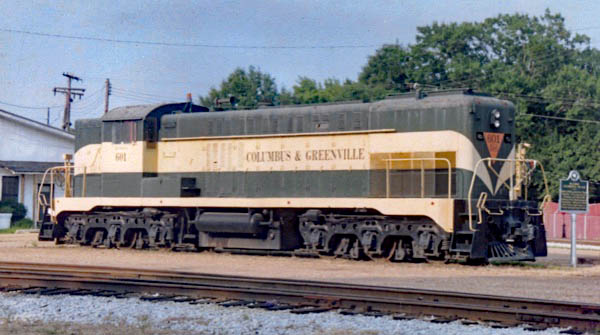
Columbus, Ms / Jul 1989 / RWH
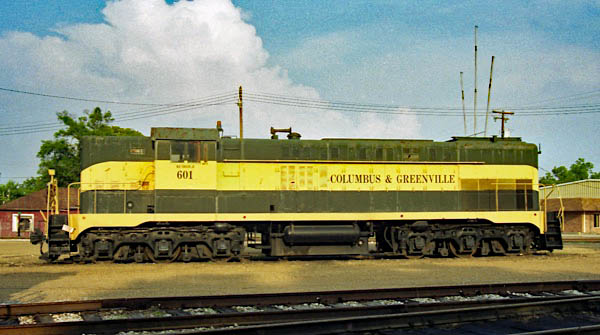
Columbus, Ms / Jul 1989 / JCH
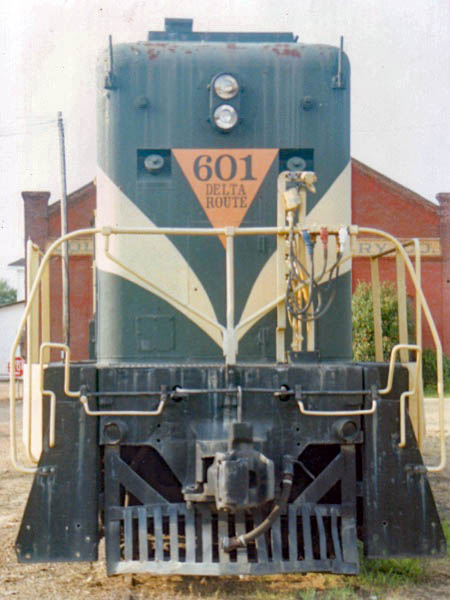
Jul 1989 / RWH
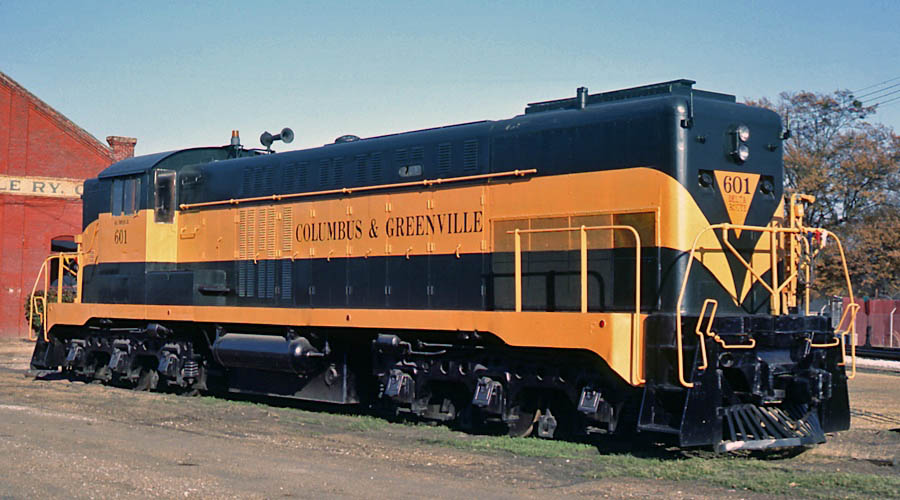
Columbus, Ms / Dec 1985 / collection
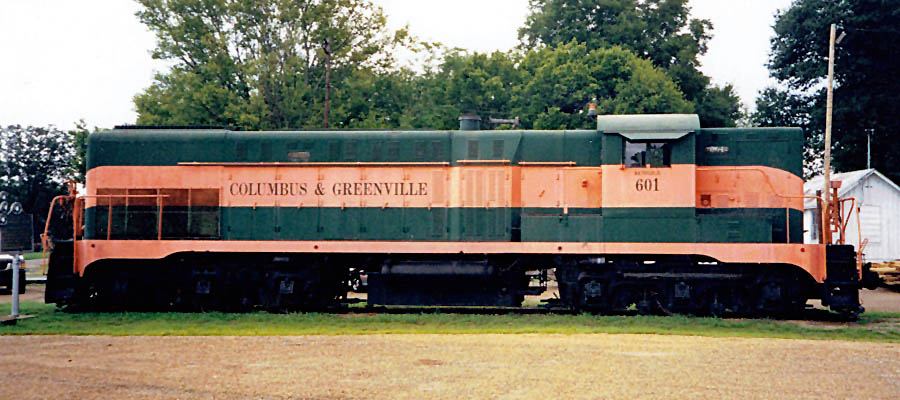
Columbus, Ms / May 2000 / JCH
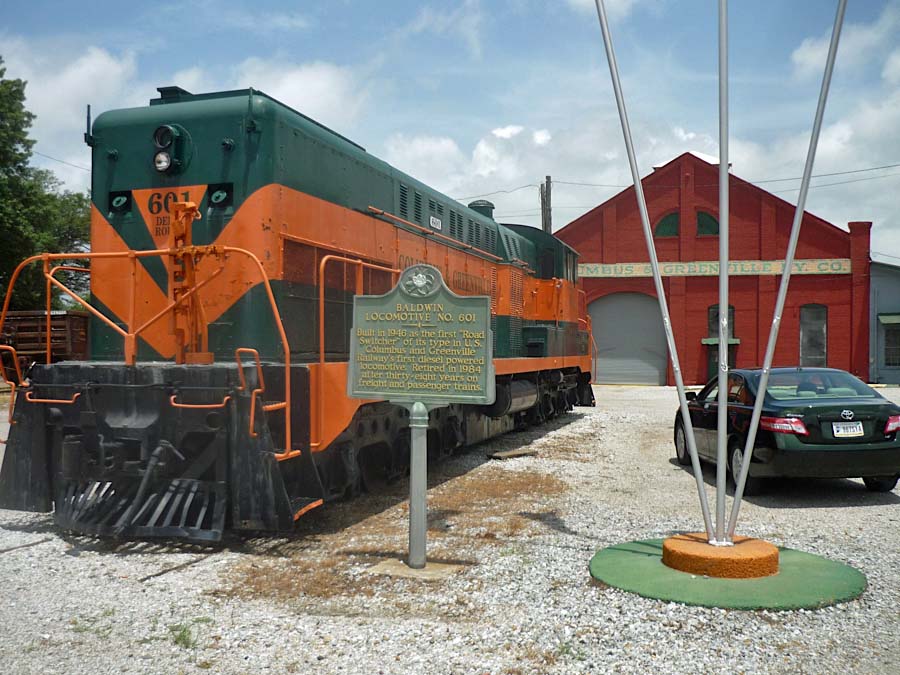
Columbus, Ms / Jun 2015 / David Powell
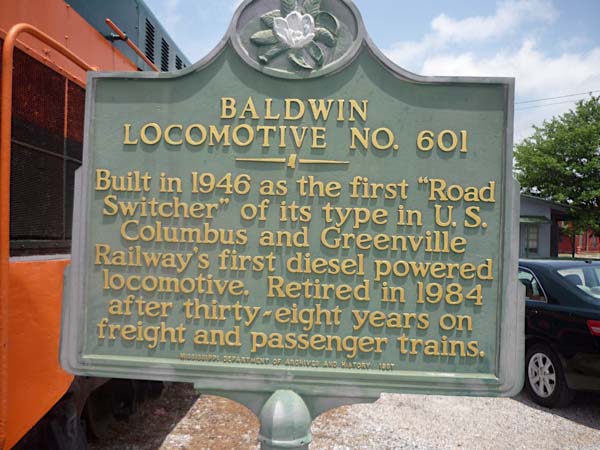
Columbus, Ms / Jun 2015 / David Powell
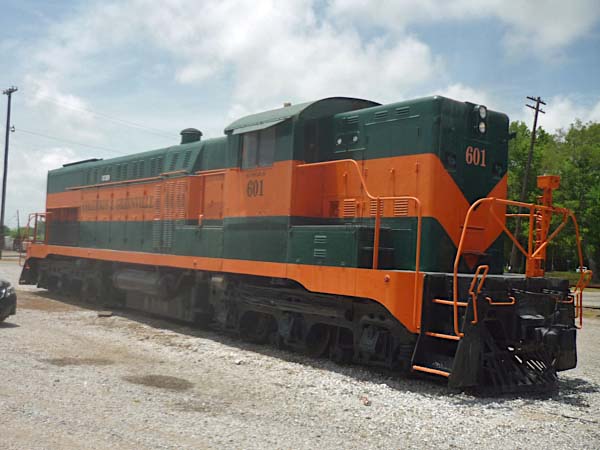
Columbus, Ms / Jun 2015 / David Powell
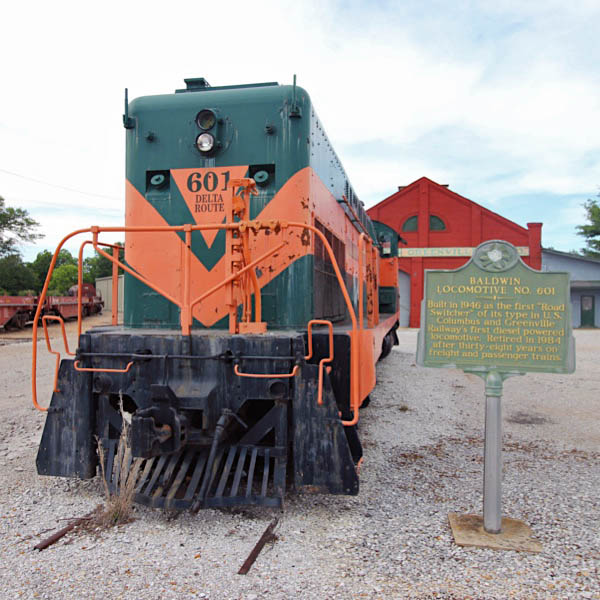
Columbus, Ms / Jun 2020 / RWH
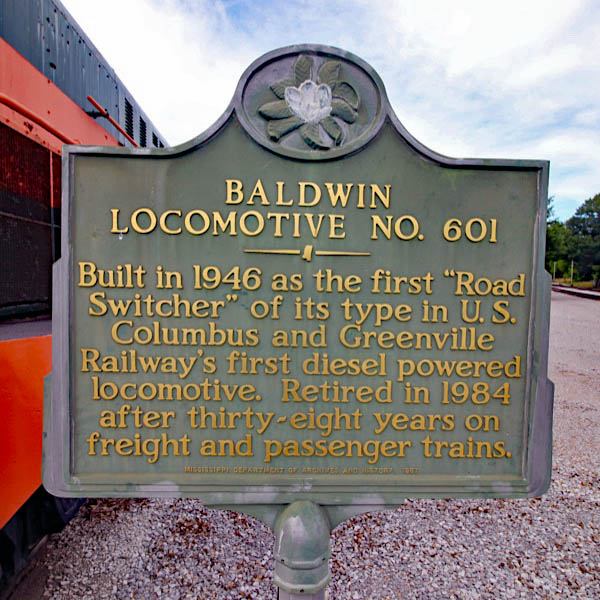
Jun 2020 / RWH

Click to see the Baldwin #601 display plotted on a Google Maps page

Columbus, Ms / Jun 2020 / RWH

Jun 2020 / RWH

Columbus, Ms / Jun 2020 / RWH
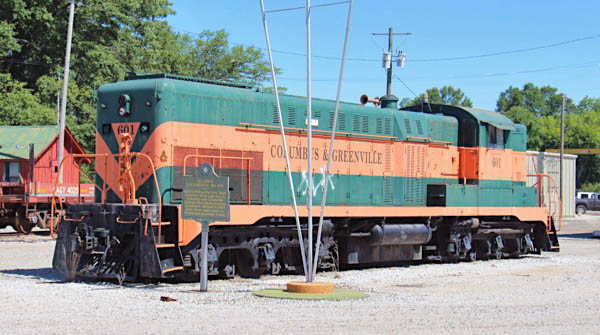
Columbus, Ms / Jun 2020 / RWH
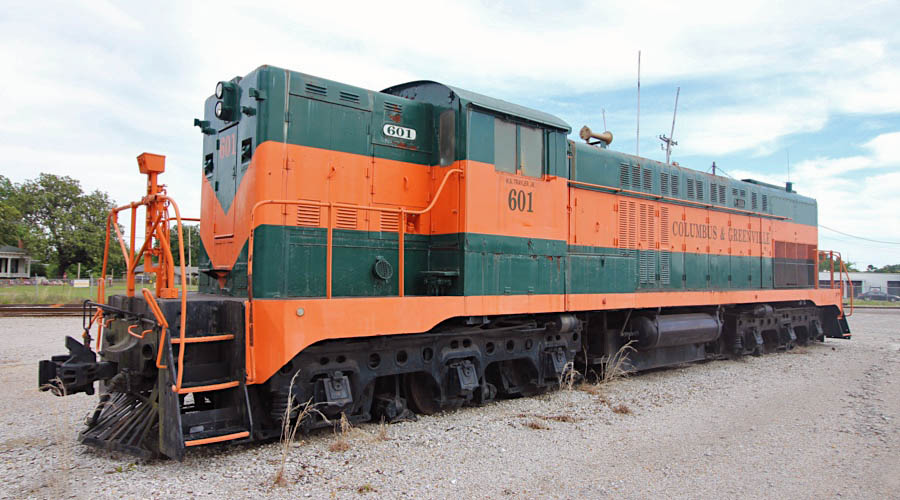
Columbus, Ms / Jun 2020 / RWH
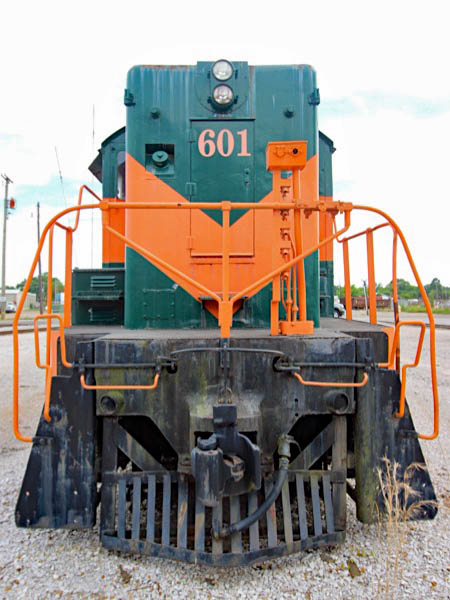
Jun 2020 / RWH
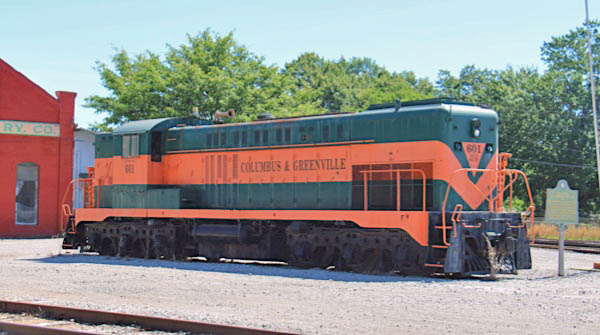
Columbus, Ms / Jun 2020 / RWH
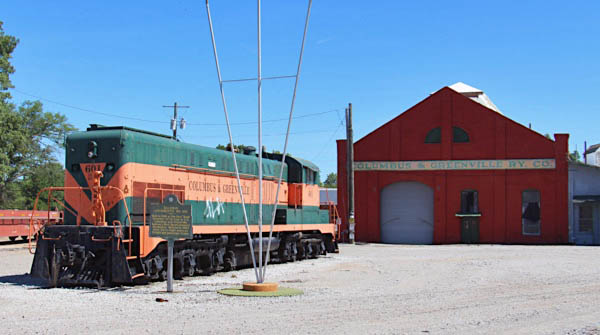
Columbus, Ms / Jun 2020 / RWH
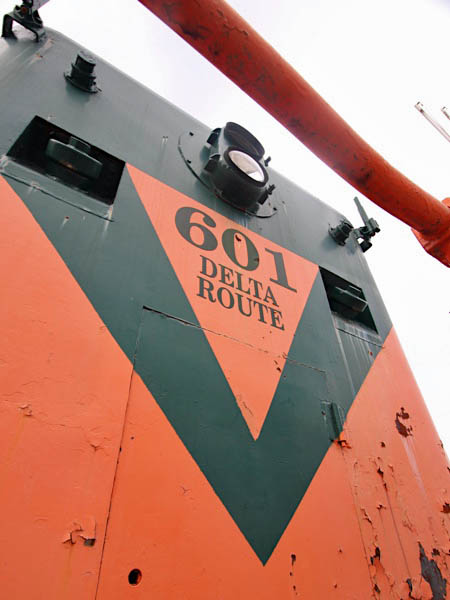
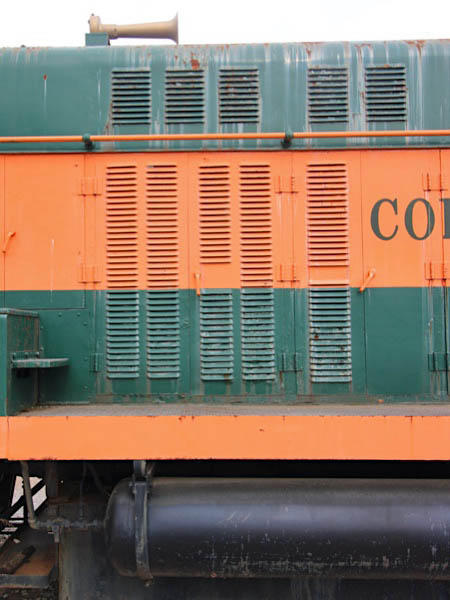
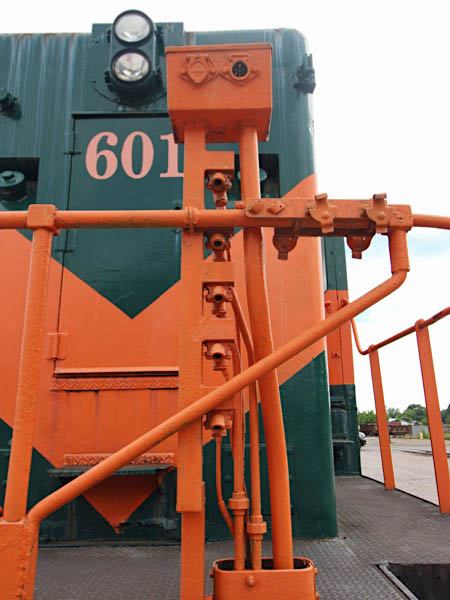
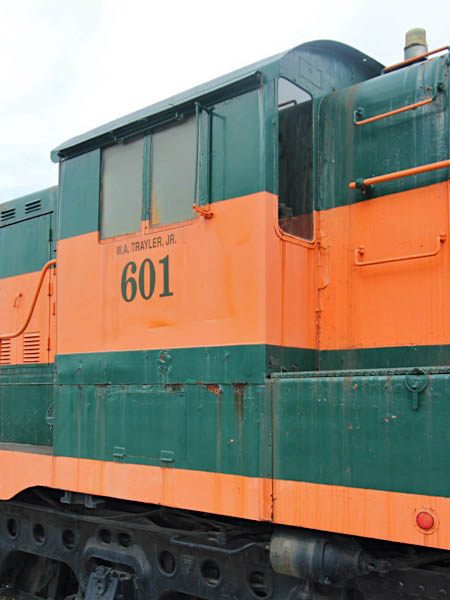
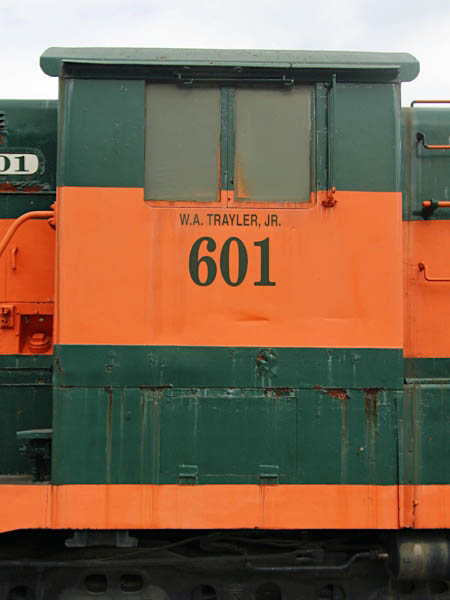
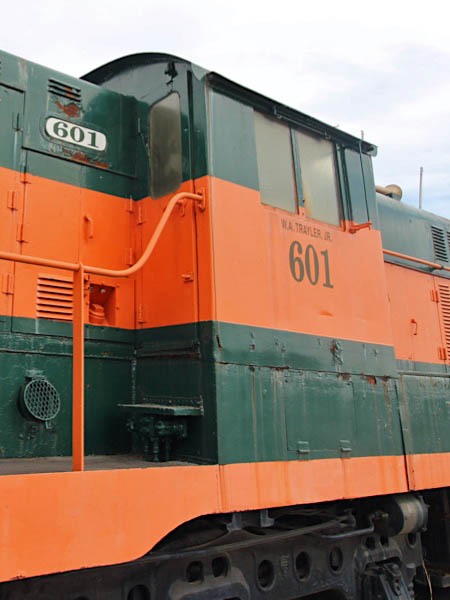
Jun 2020 / RWH

Jun 2020 / RWH

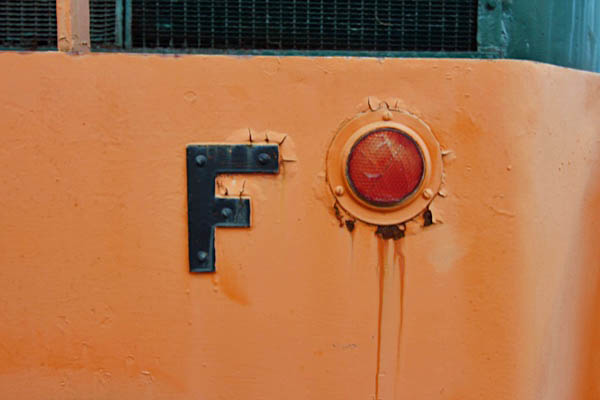
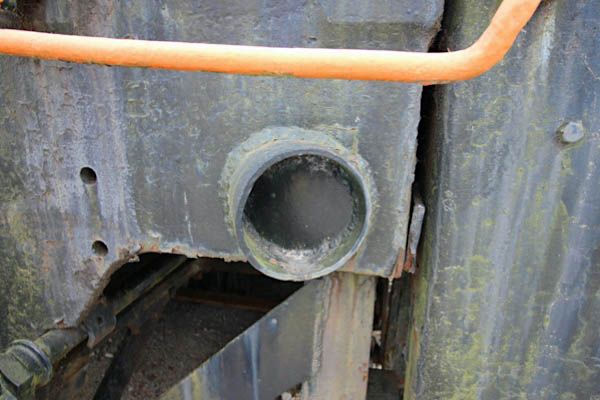



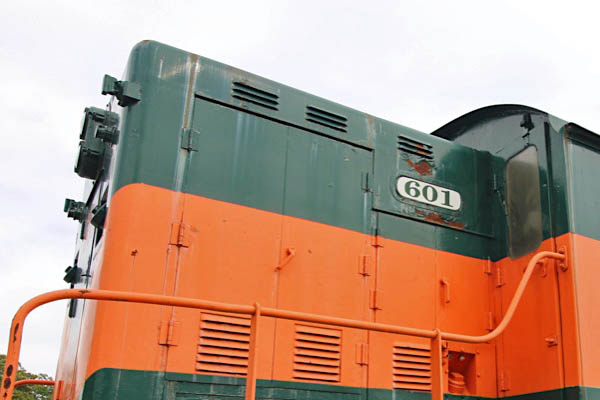
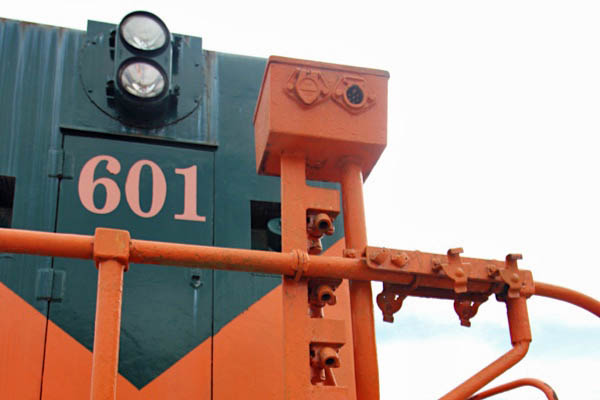
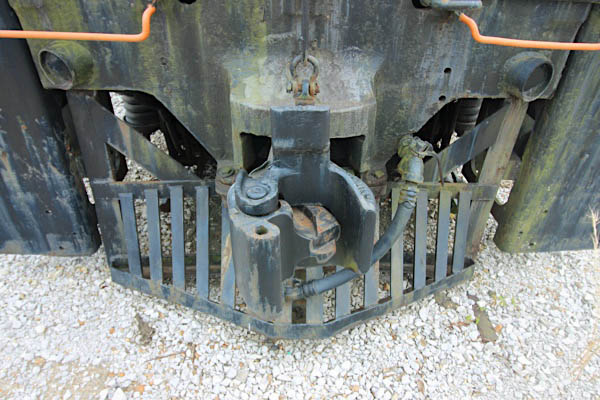
Jun 2020 / RWH
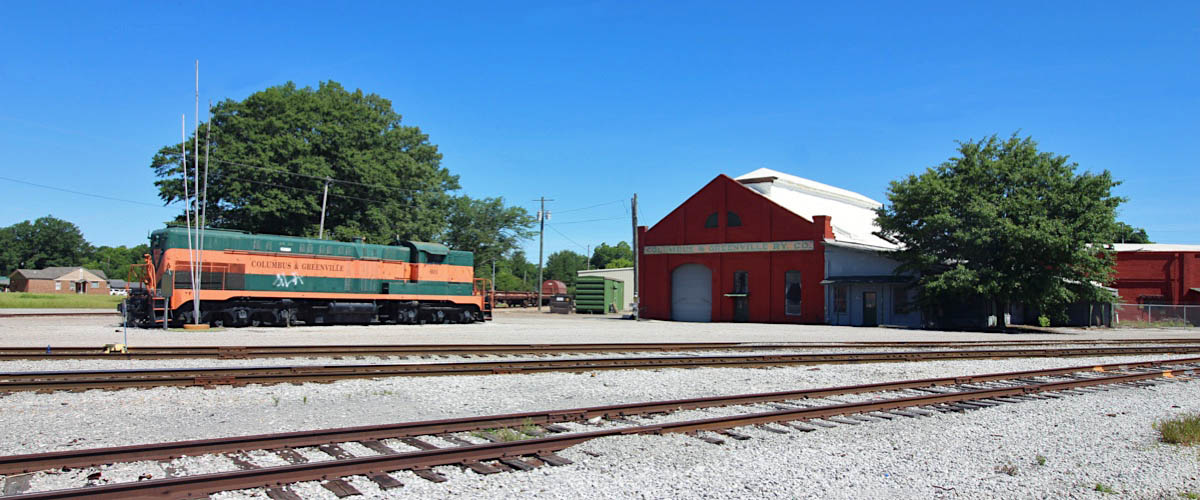
Columbus, Ms / Jun 2020 / RWH
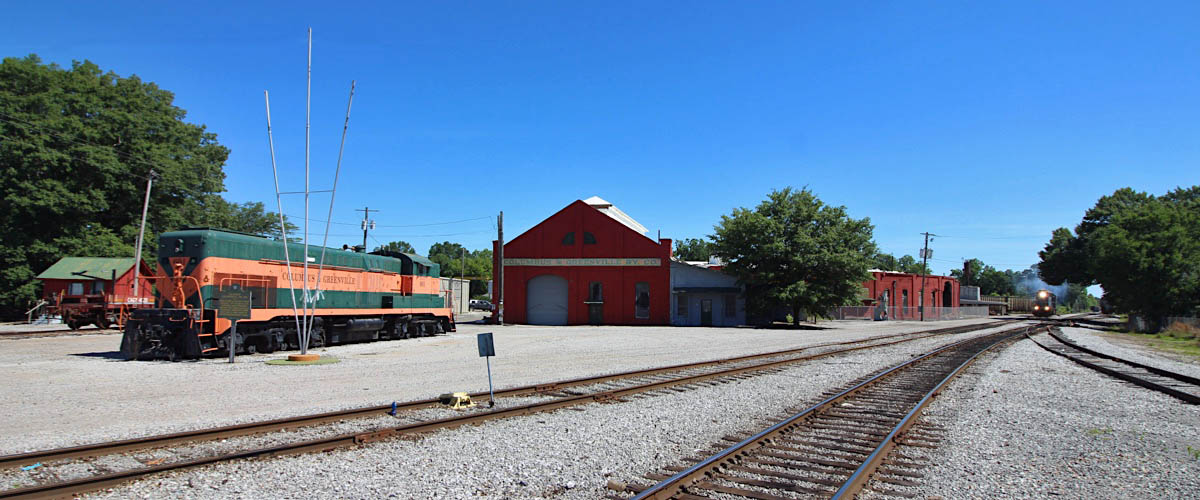
Columbus, Ms / Jun 2020 / RWH
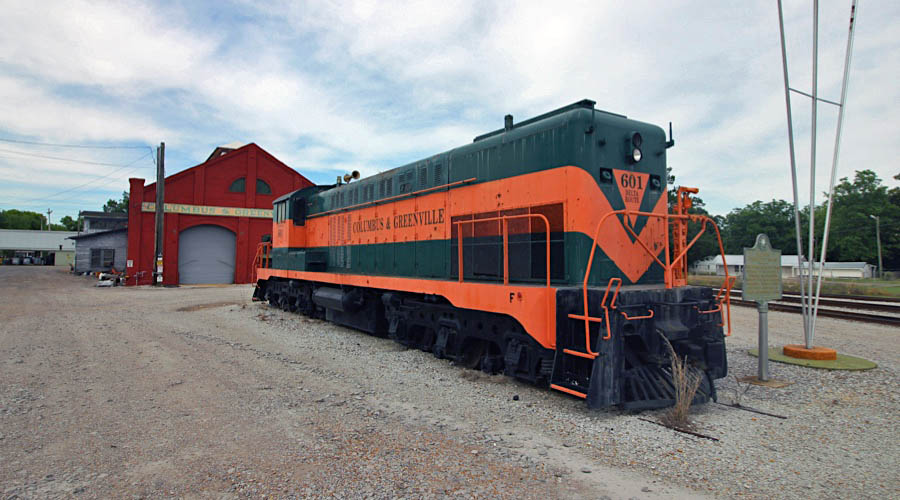
Columbus, Ms / Jun 2020 / RWH
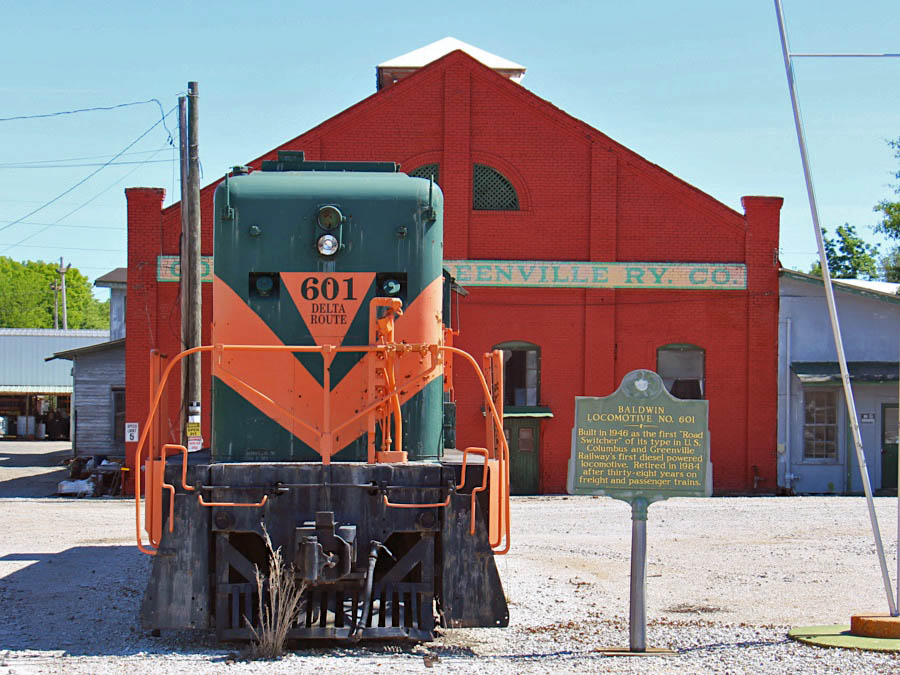
Columbus, Ms / Jun 2020 / RWH
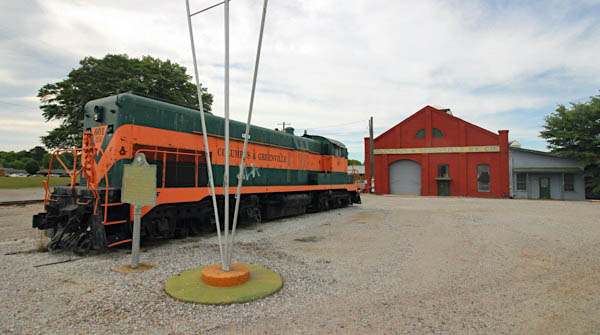
Columbus, Ms / Jun 2020 / RWH
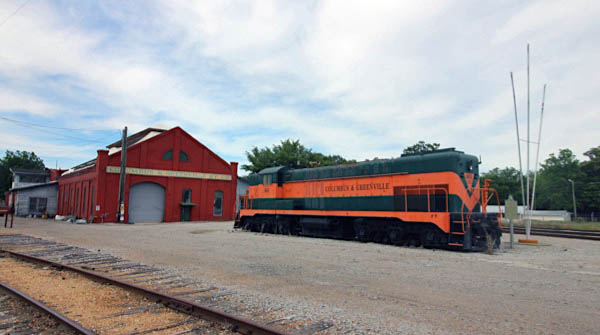
Columbus, Ms / Jun 2020 / RWH
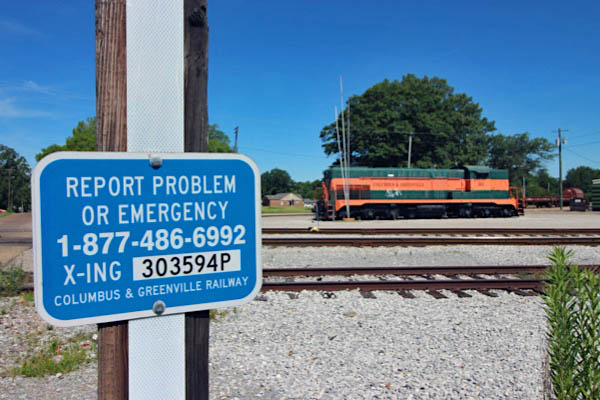
Jun 2020 / RWH
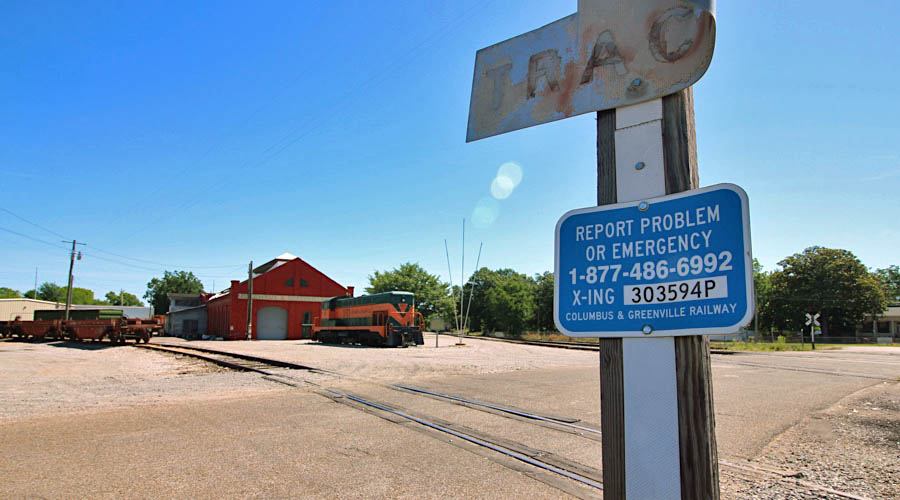
Columbus, Ms / Jun 2020 / RWH
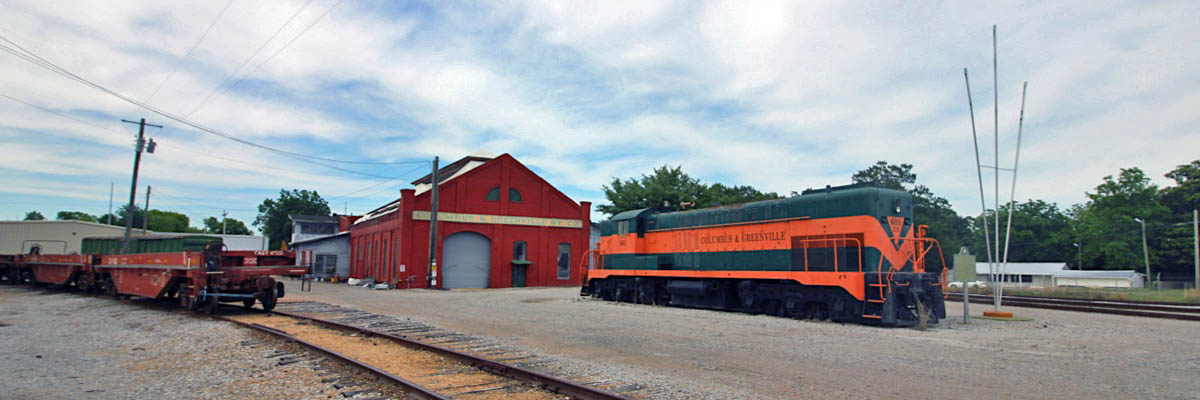
Columbus, Ms / Jun 2020 / RWH

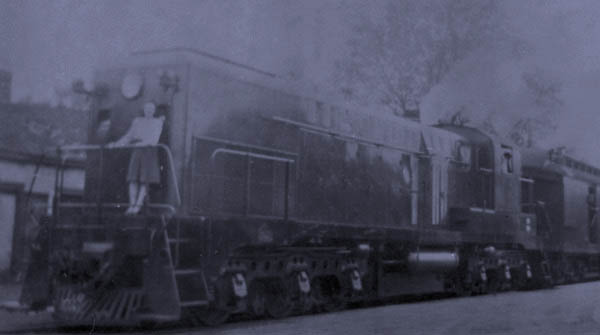 There are no photos of the C&G 601 painted and lettered at Baldwin because the loco wasn't painted and lettered there. It was so late and so badly needed at the C&G that she came down painted only dark green (I think) and with little or no lettering. You may recall the line in Delta Route which said she was delivered "drably painted and unlettered" or something like that (I haven't read the book in awhile). The painting was completed in Columbus and Baldwin send down a photographer to shoot the finished loco. As proof of this, I enclose a print of the drab 601 on a C&G passenger train at Columbus depot. I guess it wasn't until the 603 was completed that Baldwin took the time to shoot one of the series at the plant. I don't know if the 602 also came down unpainted, but I rather doubt it.
There are no photos of the C&G 601 painted and lettered at Baldwin because the loco wasn't painted and lettered there. It was so late and so badly needed at the C&G that she came down painted only dark green (I think) and with little or no lettering. You may recall the line in Delta Route which said she was delivered "drably painted and unlettered" or something like that (I haven't read the book in awhile). The painting was completed in Columbus and Baldwin send down a photographer to shoot the finished loco. As proof of this, I enclose a print of the drab 601 on a C&G passenger train at Columbus depot. I guess it wasn't until the 603 was completed that Baldwin took the time to shoot one of the series at the plant. I don't know if the 602 also came down unpainted, but I rather doubt it.
Louis Saillard
#602
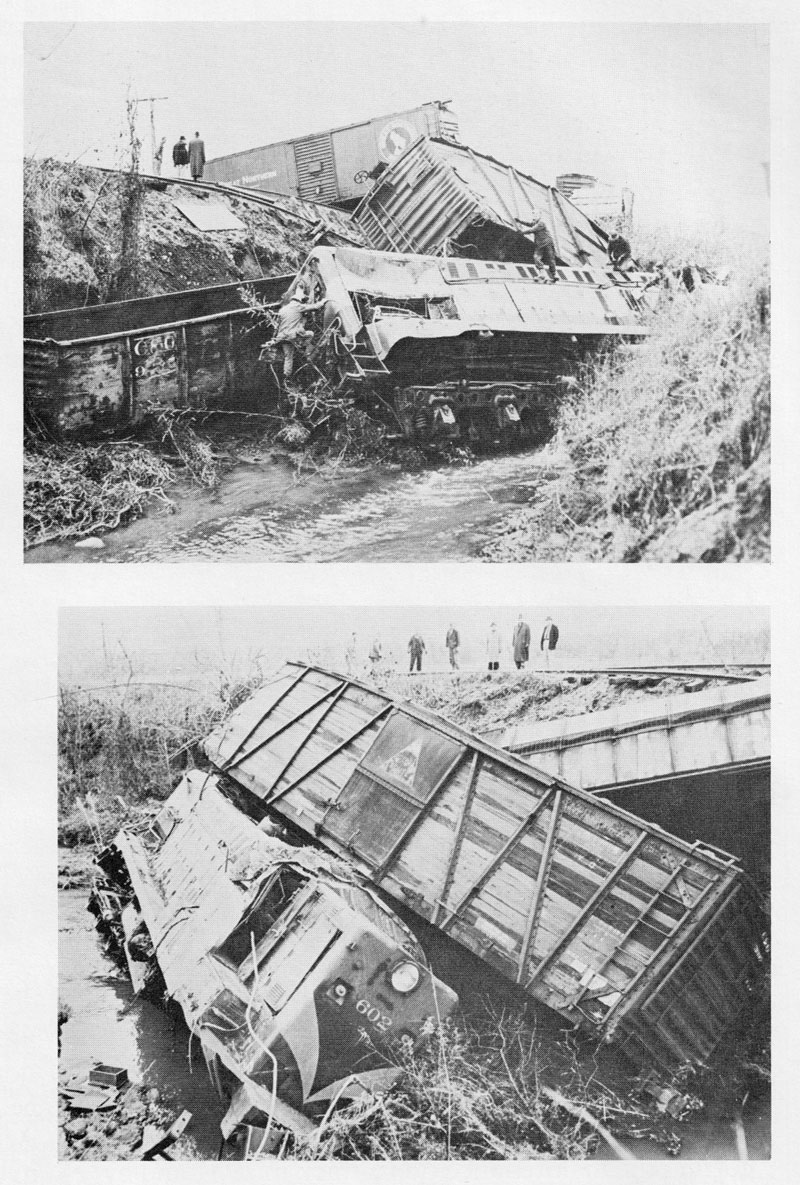
from Delta Route: A History of the C&G
— Louis Saillard / collection


Columbus & Greenville #602
wrecked Dec 1961 at Maben MS

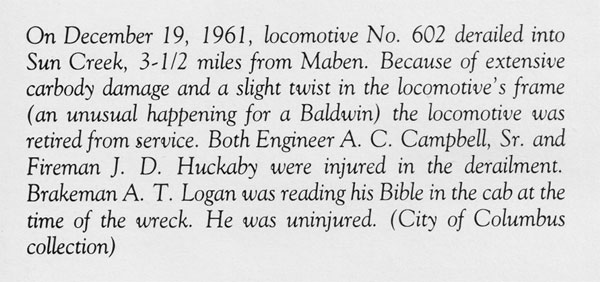
from Delta Route: A History of the C&G
/ collection

#603
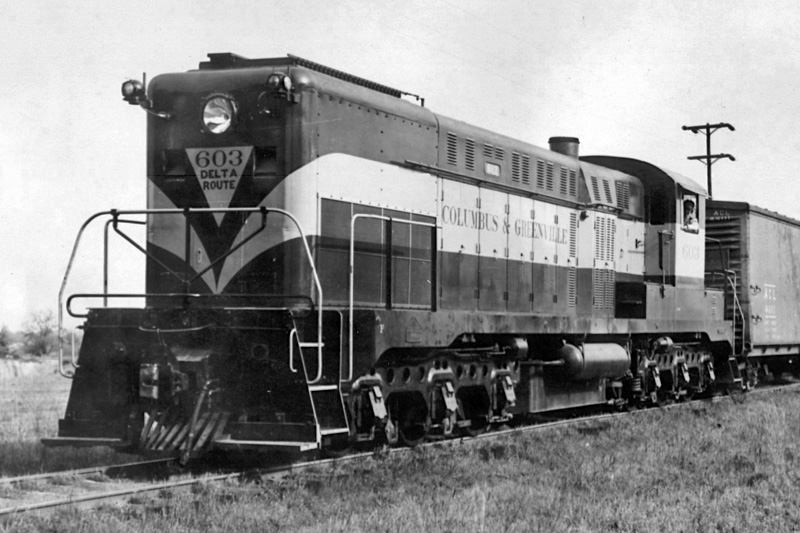
Columbus & Greenville #603
Columbus, Ms / collection


Columbus & Greenville #603
retired by 1980, later scrapped

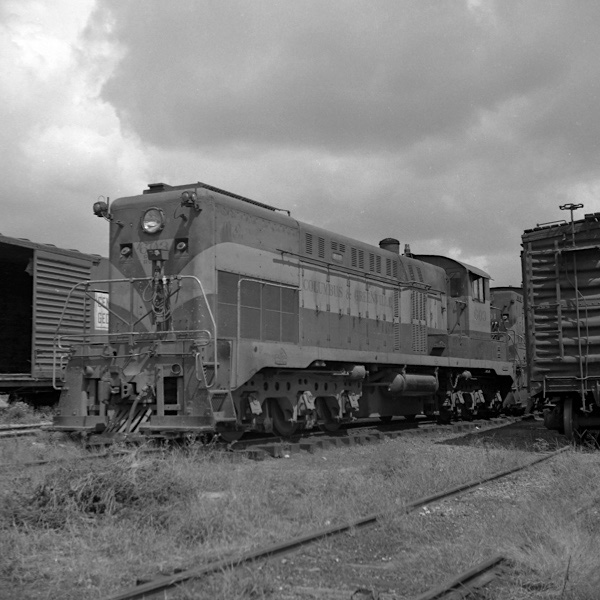
Columbus, Ms / Sep 1969 / JCH
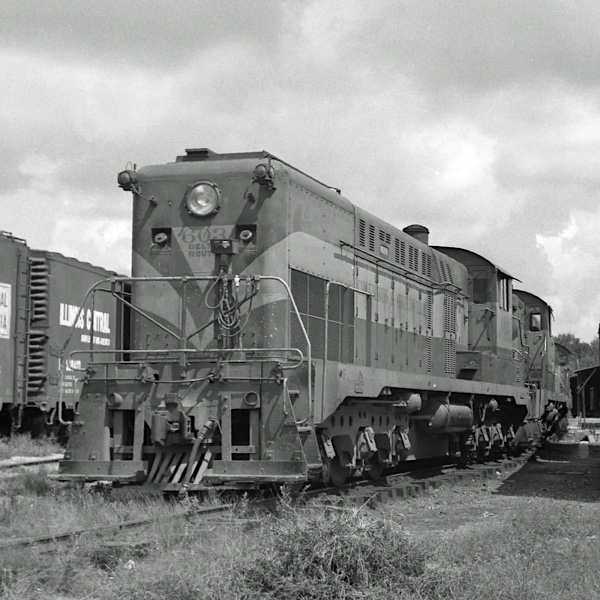
Columbus, Ms / Sep 1969 / JCH
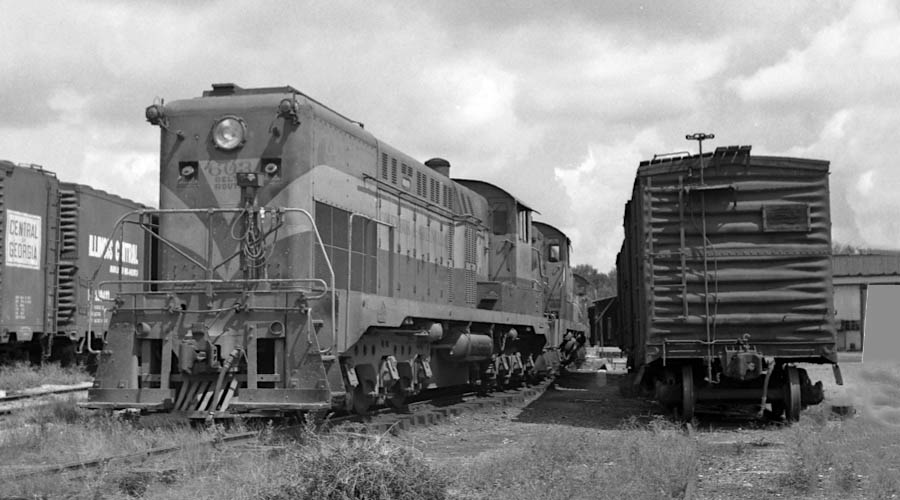
Columbus, Ms / Sep 1969 / JCH

Columbus, Ms / collection

Columbus, Ms / collection
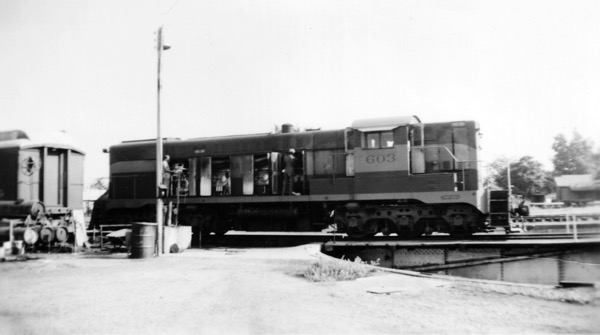
Columbus, Ms / collection
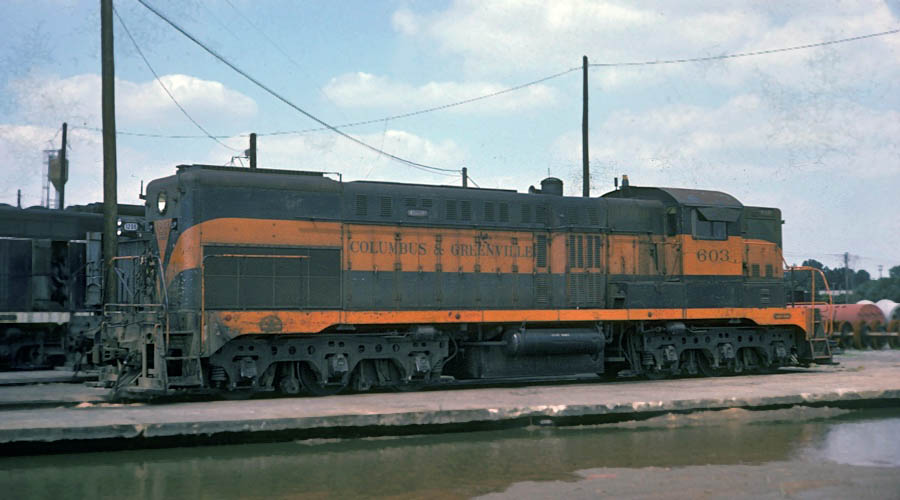
Columbus, Ms / 1974 / collection
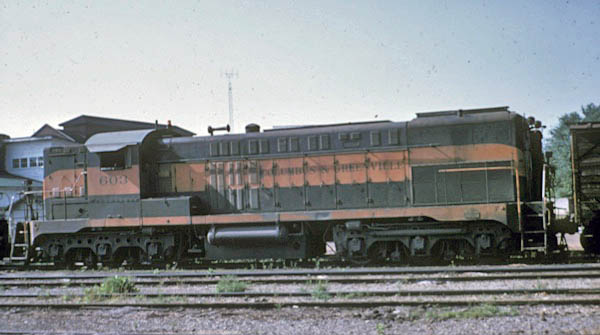
Columbus, Ms / 1975 / collection
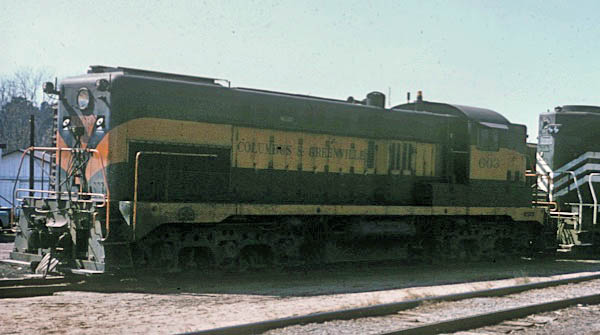
Columbus, Ms / 1970 / collection

Columbus, Ms / 1977 / collection
 Baldwin Poster Child
Baldwin Poster Child

Baldwin publicity photo / collection
For more than 20 years, the Columbus & Greenville used the Baldwin publicity photo above featuring #603 as a basis for its advertising, including its timetable publications and entries in the annual Official Guide of the Railways.
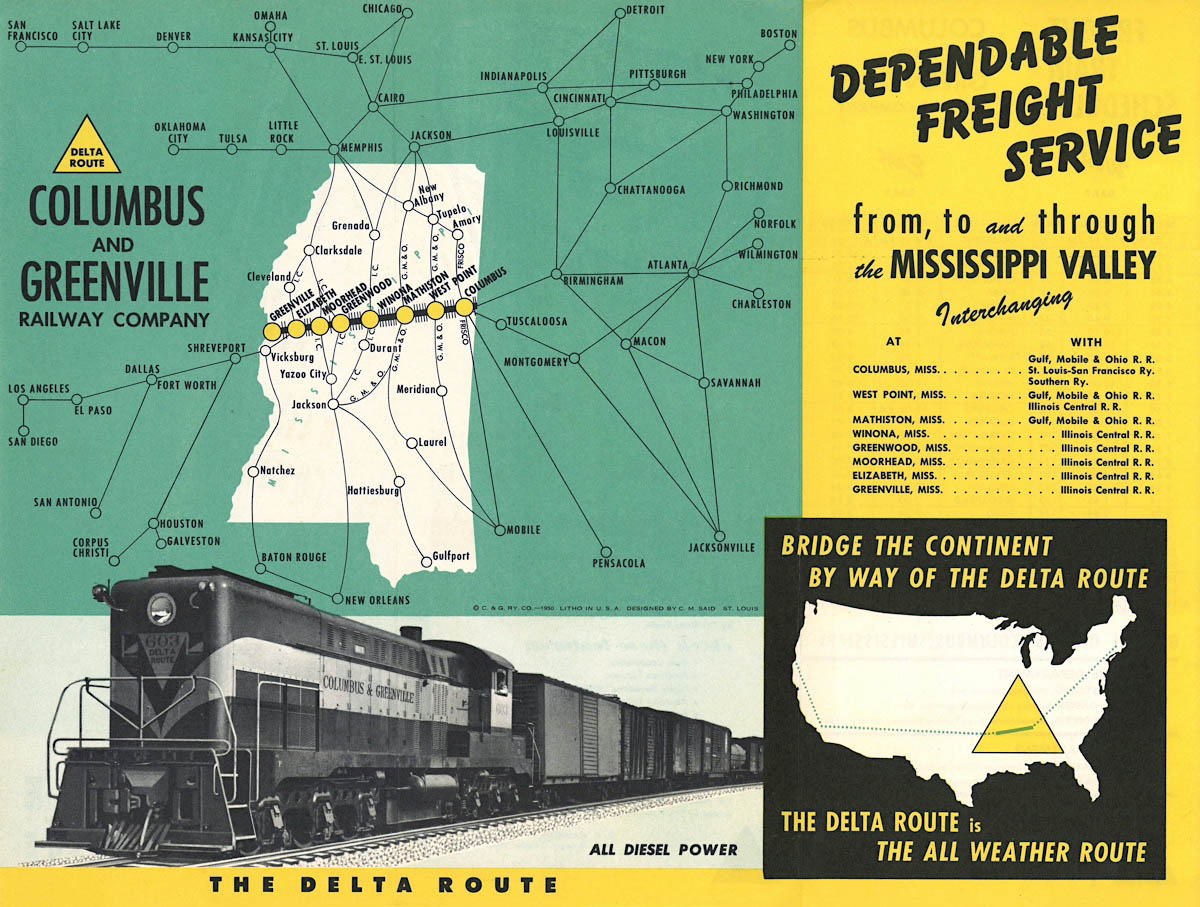
1951 timetable / collection
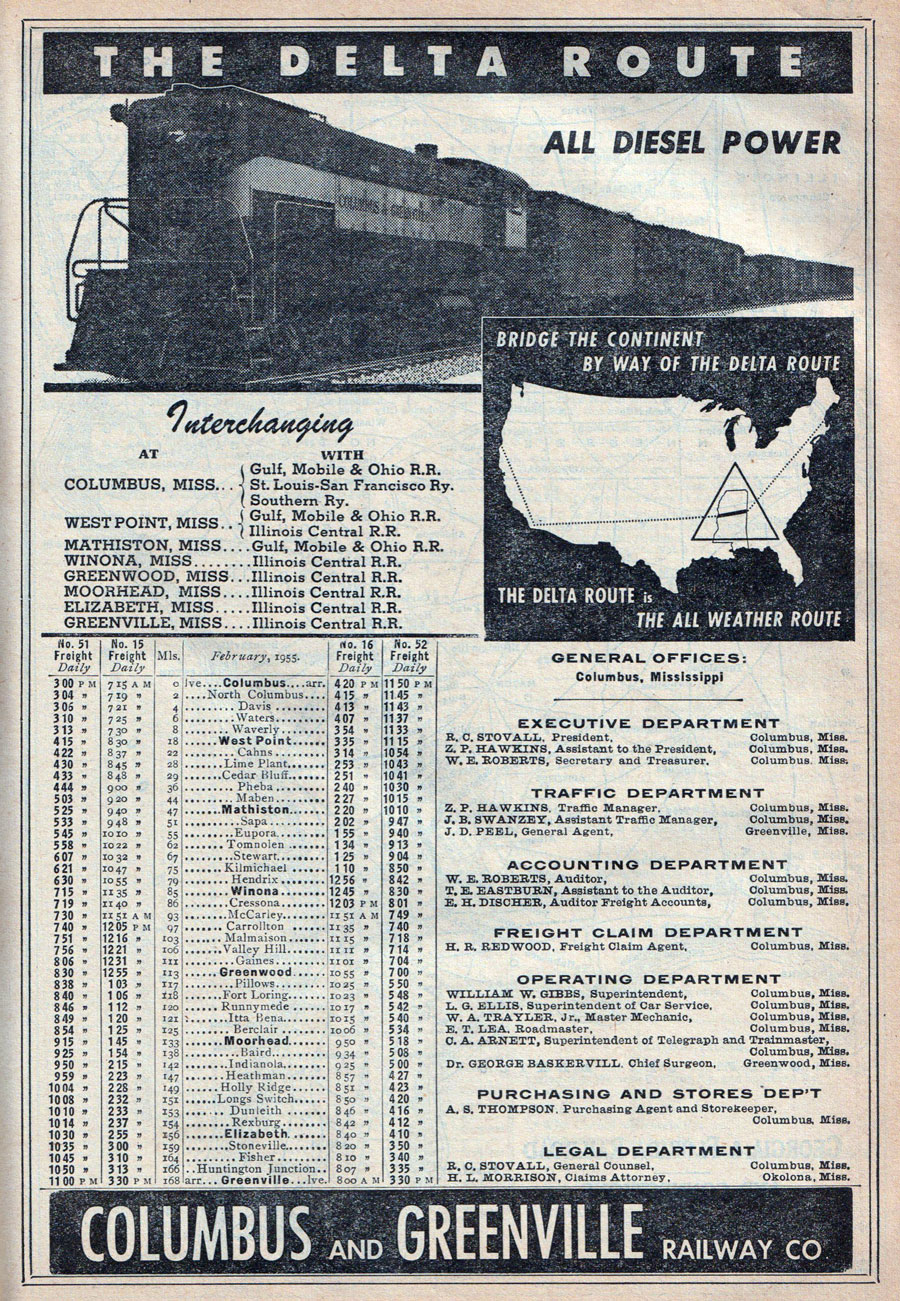
1955 Official Guide ad / collection

For more Official Guide ads see our Columbus & Greenville Publications page
#604
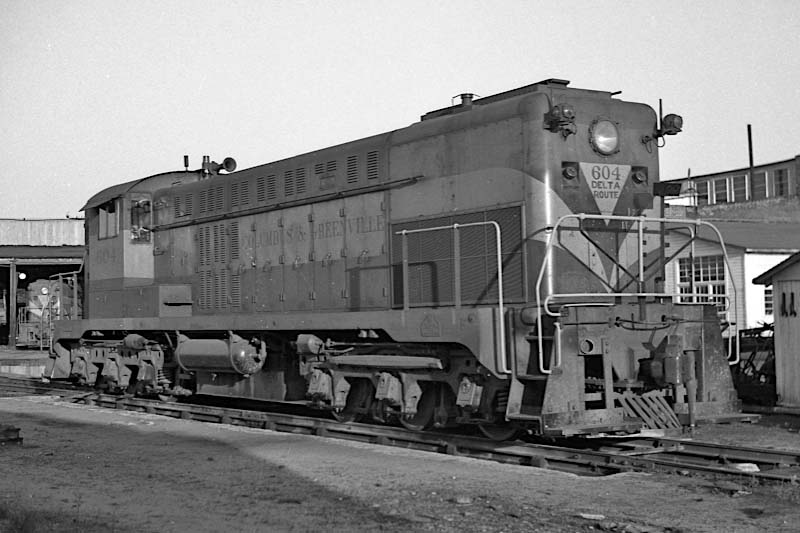
Columbus & Greenville #604
Columbus, Ms / Sep 1969 / JCH


Columbus & Greenville #604
retired by 1980, later scrapped

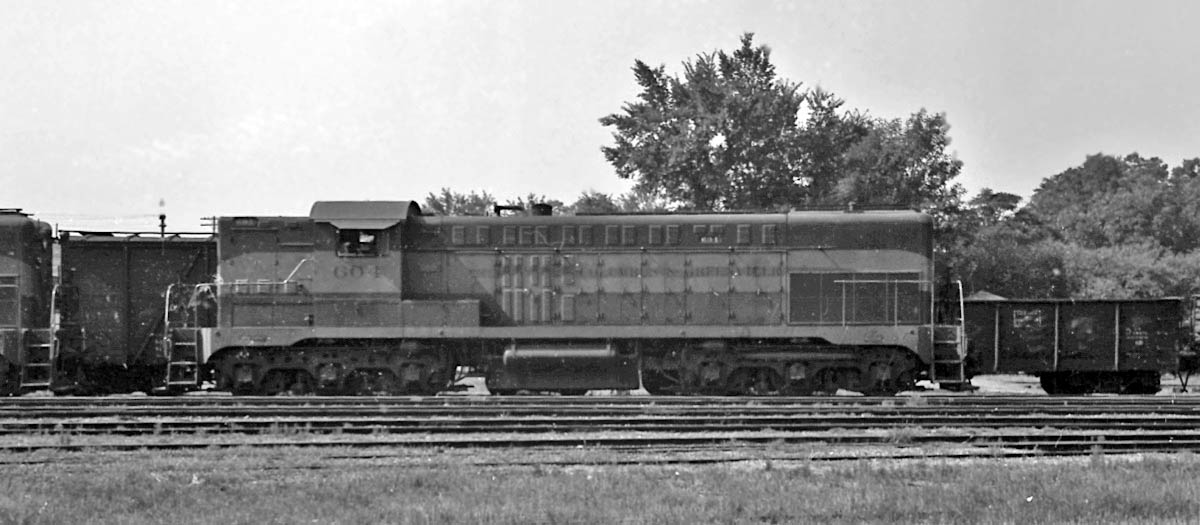
Columbus, Ms / May 1960 / JCH

Columbus, Ms / Sep 1969 / JCH

Columbus, Ms / 1970 / JCH
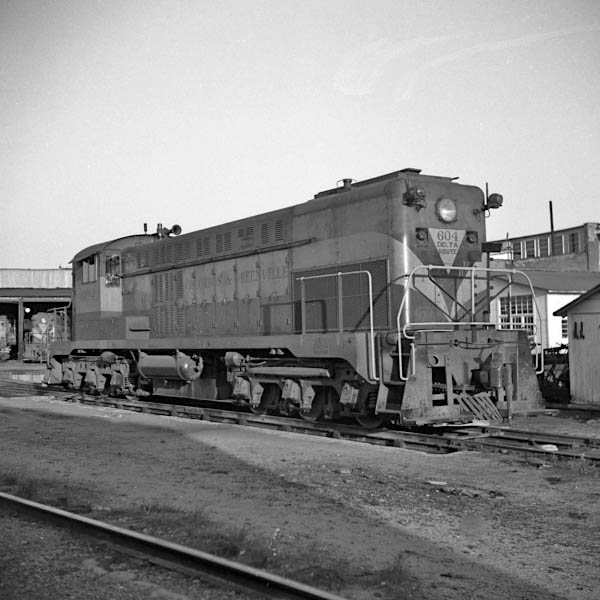
Columbus, Ms / 1970 / JCH

Columbus, Ms / Jun 1972 / JCH
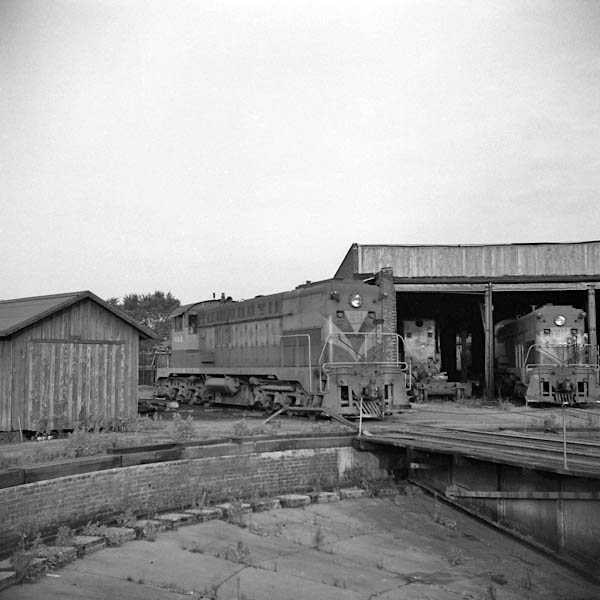
Columbus, Ms / Jun 1972 / JCH
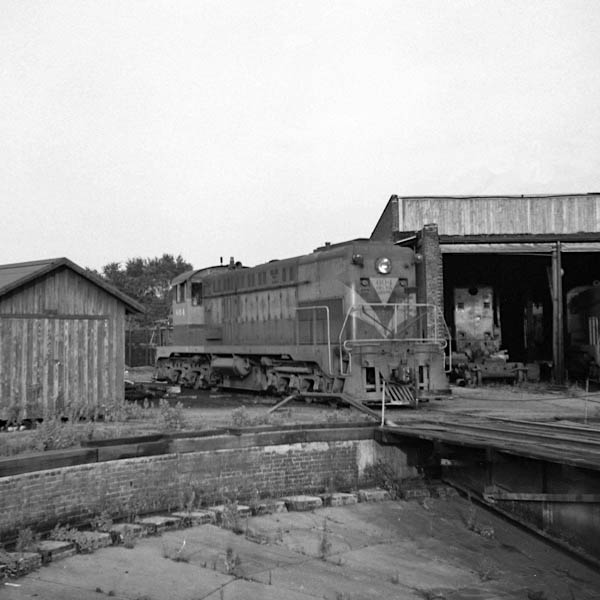
Columbus, Ms / Jun 1972 / JCH

Columbus, Ms / Jul 1972 / JCH
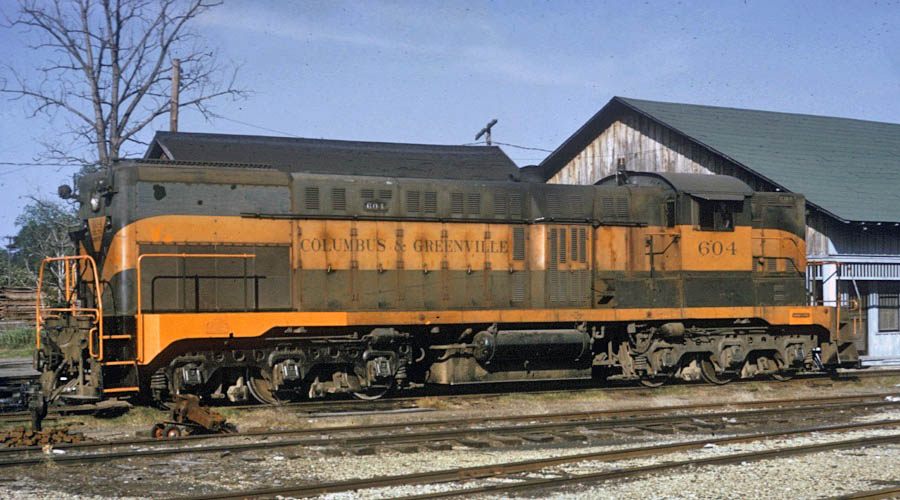
Greenville, Ms / 1970 / collection
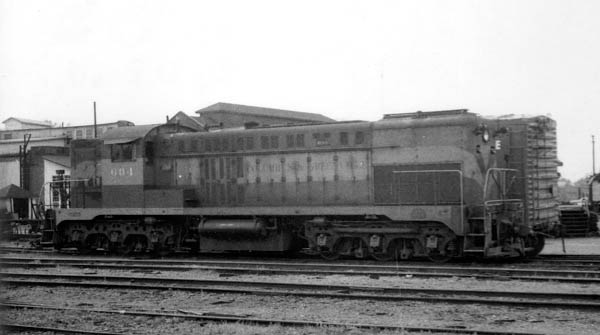
Columbus, Ms / Mar 1973 / collection

Columbus, Ms / 1969 / collection
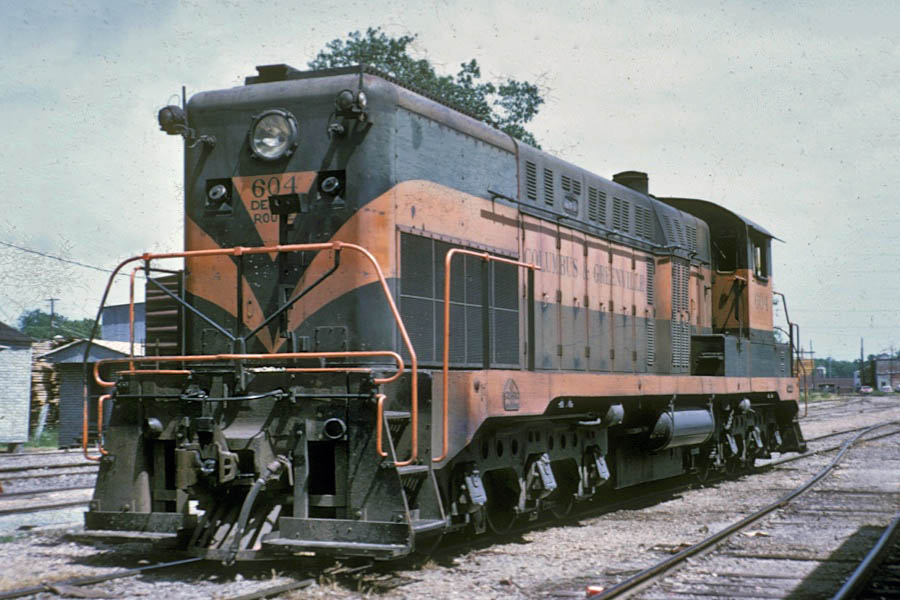
Columbus, Ms / collection

Columbus, Ms / Jun 1974 / Doug Leffler
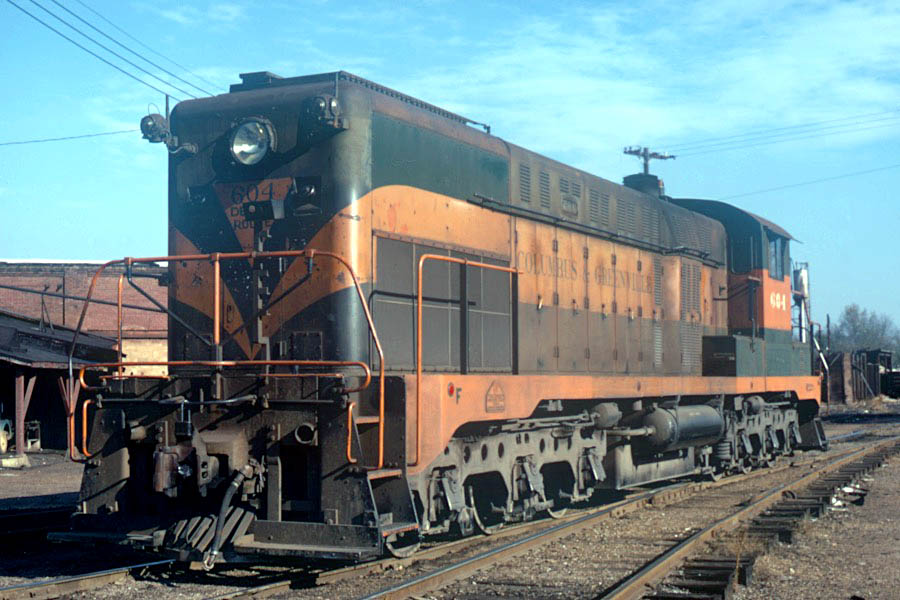
Columbus, Ms / Nov 1974 / collection
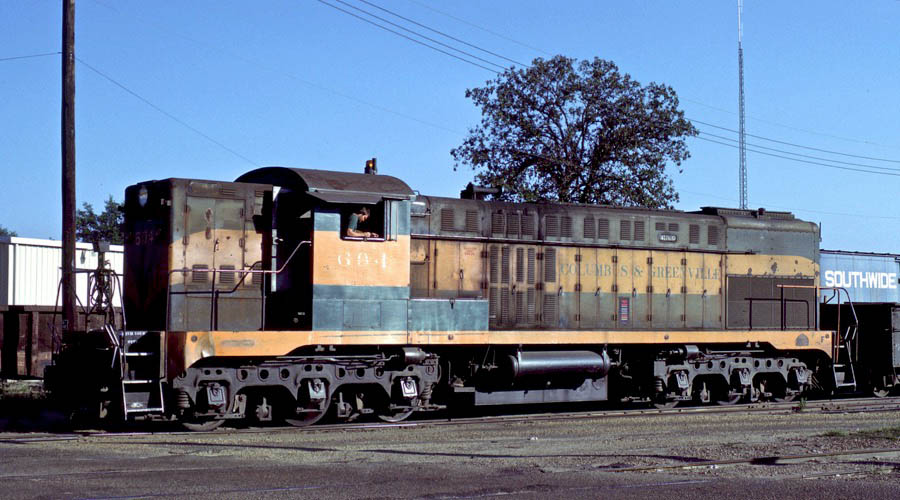
Columbus, Ms / Sep 1979 / Gerhard Anderson
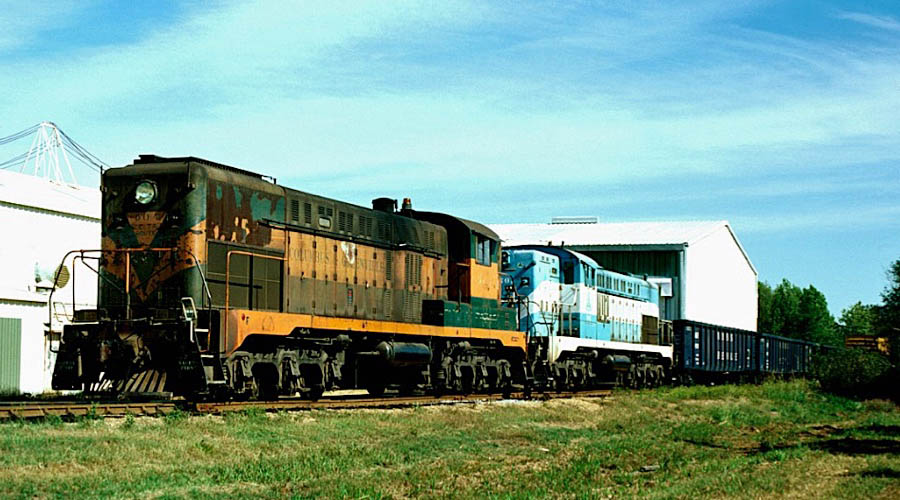
Columbus, Ms / Oct 1980 / Michael Palmieri
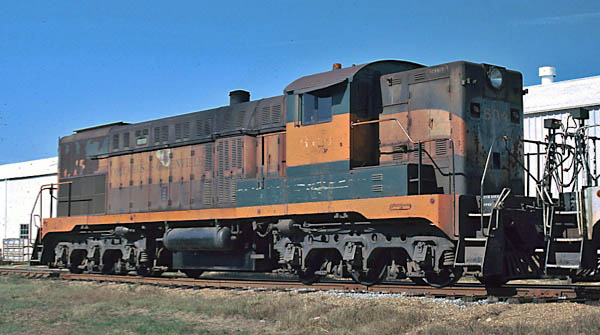
Columbus, Ms / Oct 1980 / Michael Palmieri

Columbus, Ms / Oct 1980 / Michael Palmieri
#605
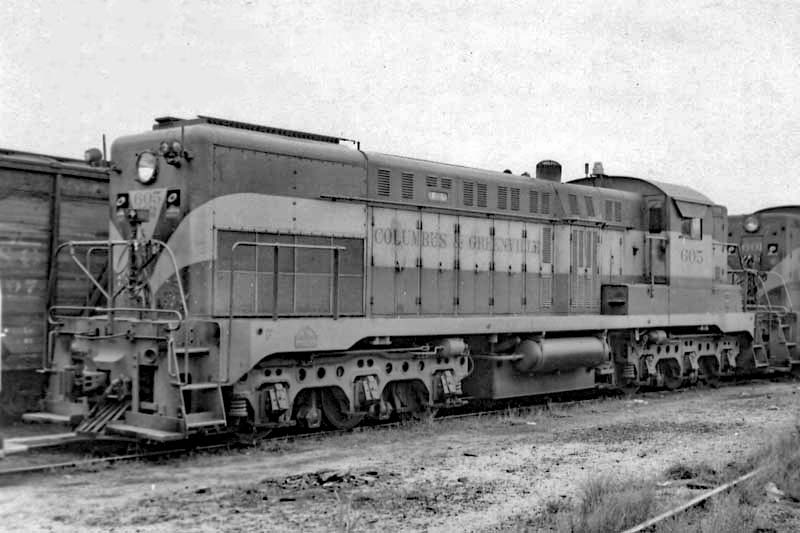
Columbus & Greenville #605
Columbus, Ms / Sep 1967 / collection


Columbus & Greenville #605
retired by 1980, later scrapped

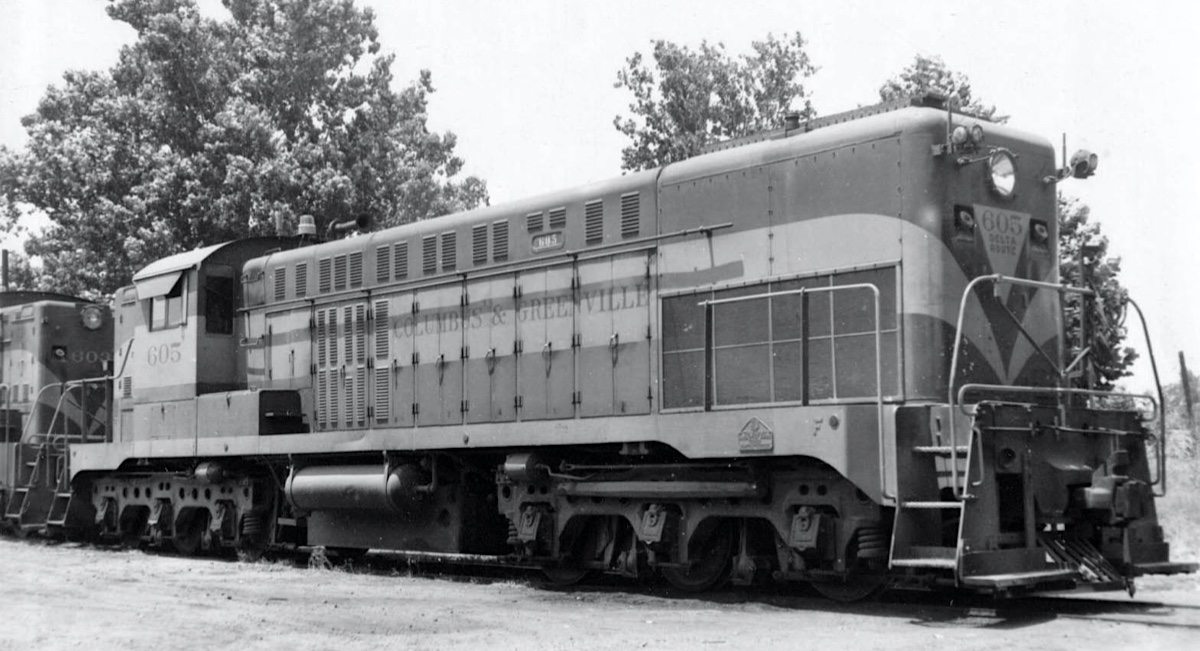
Greenville, Ms / collection
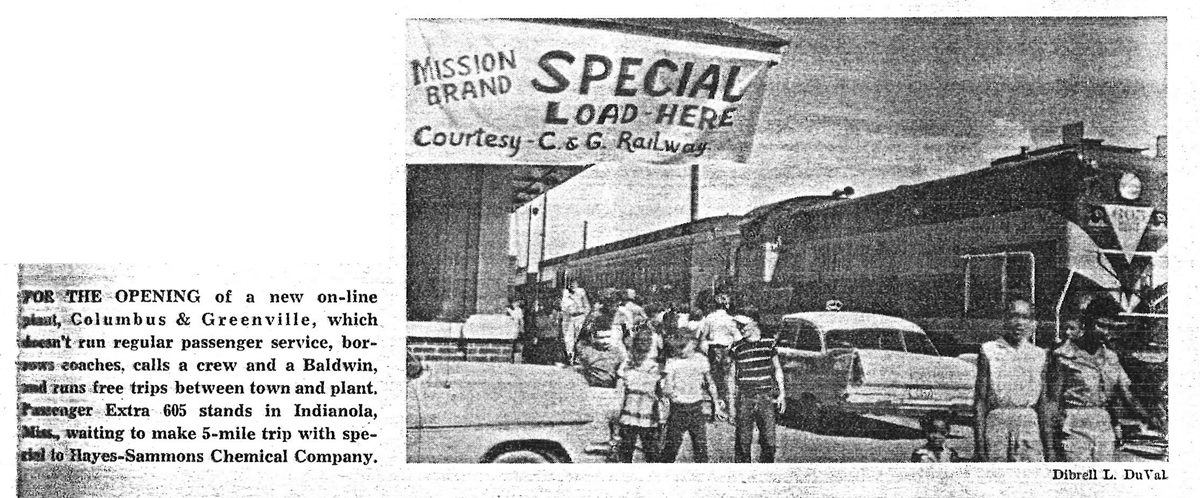
TRAINS magazine - Oct 1957 / collection
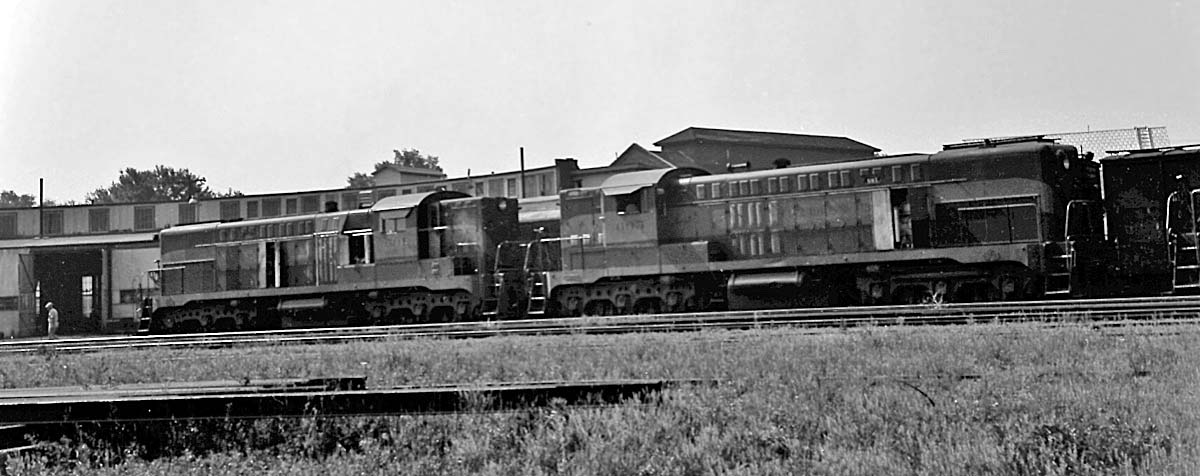
Columbus, Ms / May 1960 / JCH
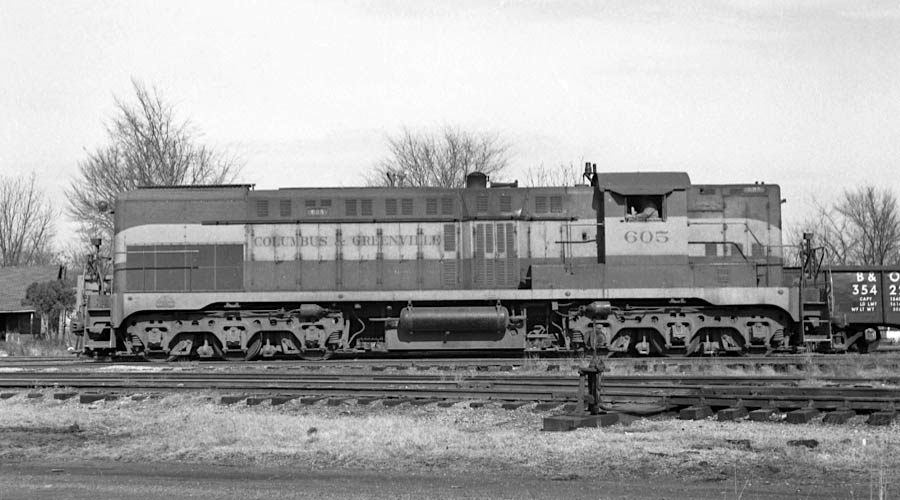
Columbus, Ms / Dec 1969 / JCH
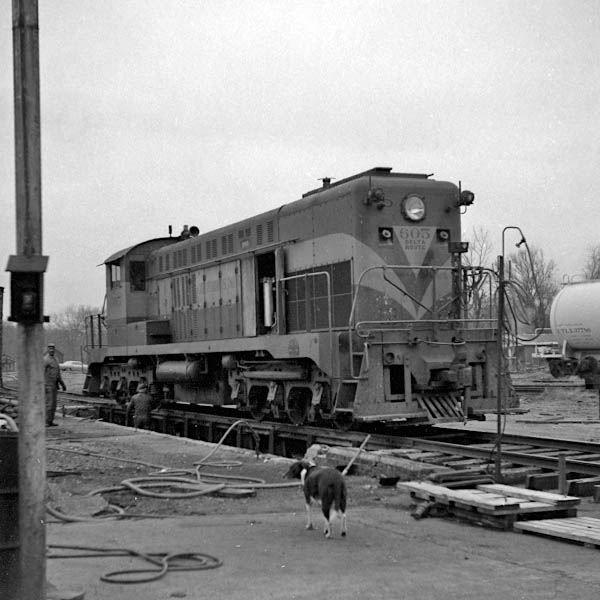
Columbus, Ms / Dec 1970 / JCH
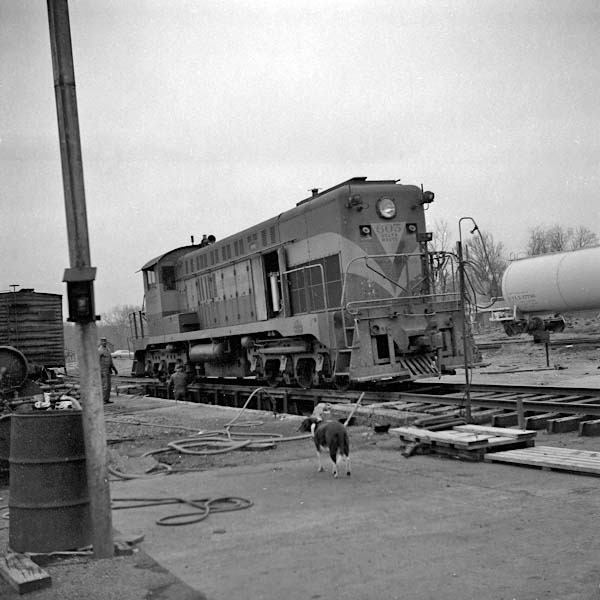
Columbus, Ms / Dec 1970 / JCH
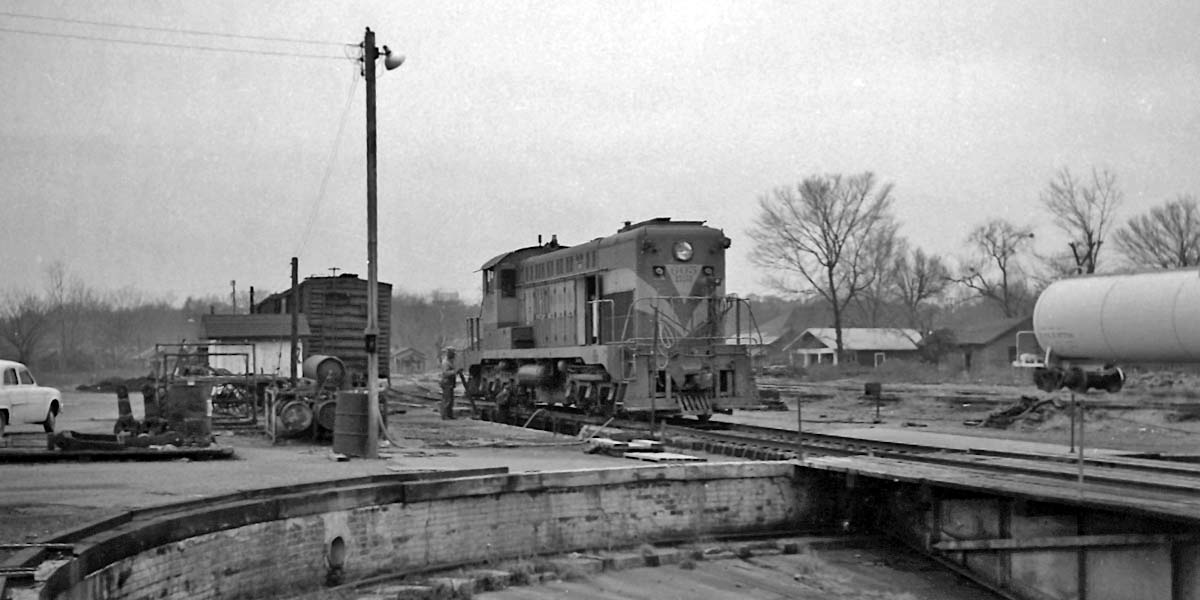
Columbus, Ms / Dec 1970 / JCH
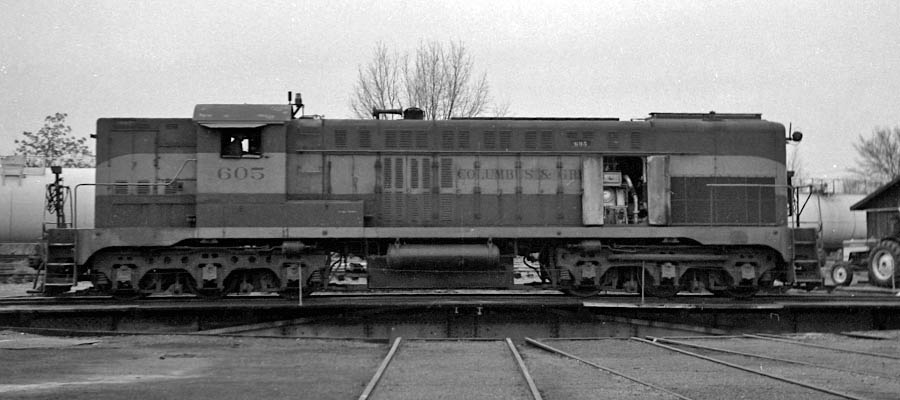
Columbus, Ms / Dec 1970 / JCH

Columbus, Ms / Dec 1969 / JCH

Greenville, Ms / Sep 1972 / collection
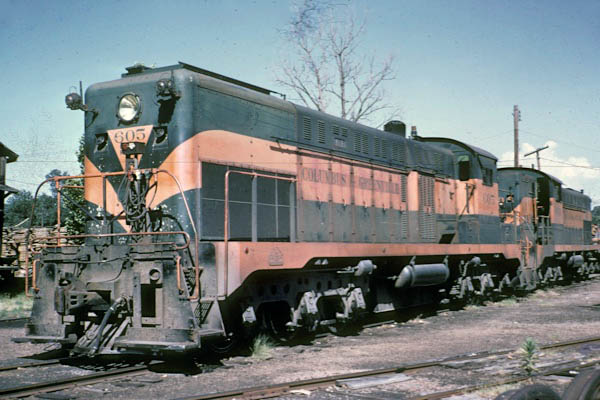
Columbus, Ms / 1973 / collection
 Ditch Lights
Ditch Lights
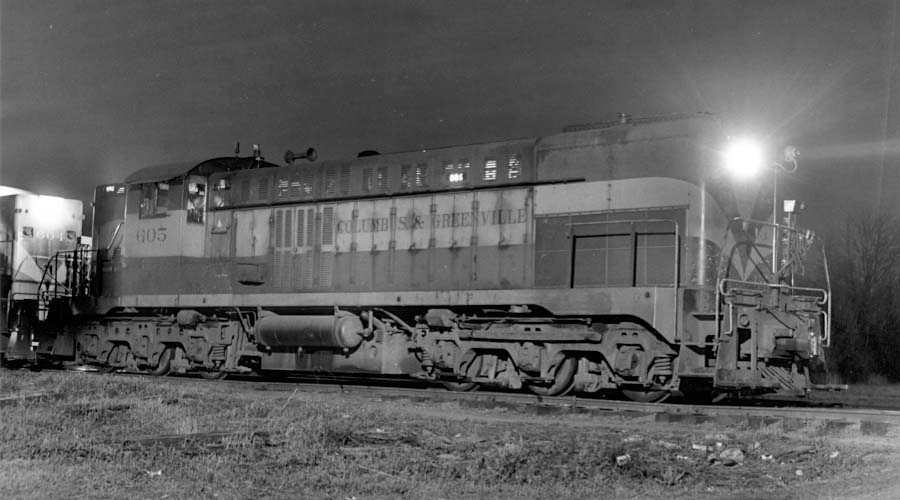
Columbus, Ms / Mar 1972 / Louis Saillard

On Thursday, December 2, 1971, the Columbus & Greenville's two most modern locomotives, SD28's 701 and 702, struck a gravel truck at the highway 413 road crossing at Kilmichael, Mississippi. The trailing 701 stayed on the right of way, but lead unit 702 took out a large pecan tree and landed in a back yard, at a 90-degree angle to the track. While the cab of the gravel truck was badly crushed, the driver was only slightly injured.
With the IC / GM&O merger long delayed, the locomotives were re-railed and stored in Columbus. They would ultimately be sent to the Illinois Central shop a Paducah, KY for repair.
Unaware of this, I arrived in Columbus on March 24, 1972, for what turned out to be my last visit to the old C&G. That evening, through freight No. 51 was made up for its trip to Greenville with Baldwins No. 605 and 604 on the point. This seemed certainly worthy of a photo, but neither my traveling buddy or I had thought to bring any flash gear for night photos.
Not to be outdone, we backed the rear wheels of his 1963 Rambler station wagon into a ditch to elevate the headlights and illuminate the lead Baldwin. We asked the engineer to turn on the 605's headlights and placed my Rollei squarely on the roof of the Rambler. An exposure of 1-second (with Tri-X film) miraculously yielded what turned out to be my favorite C&G photo.
The next morning a shop worker told us that one of the SD's was repaired and on its way home from Paducah. The days of the Baldwins on through freights No. 51 and 52 were numbered. As it turned out, the C&G itself had only six months to live.
Louis Saillard
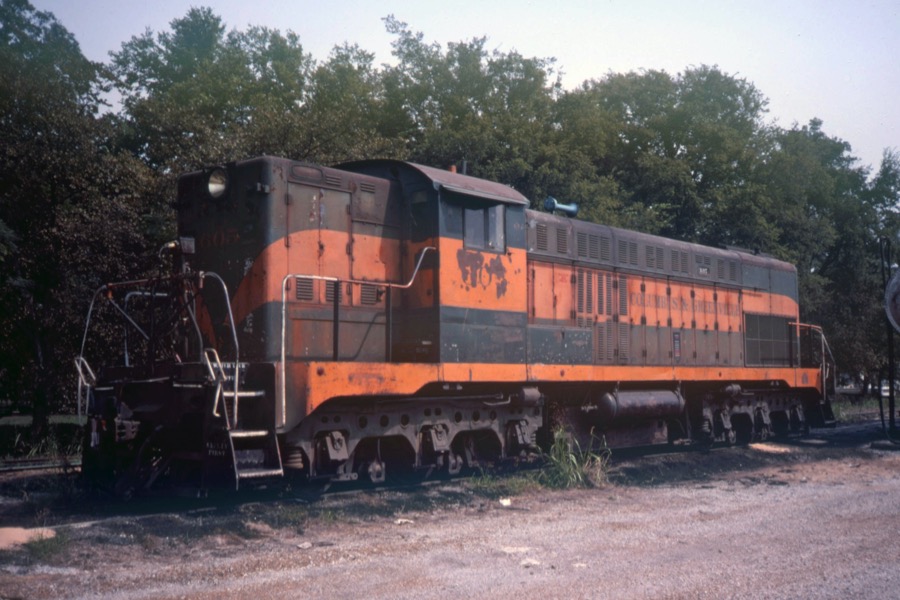
Greenwood, Ms / Oct 1978 / collection
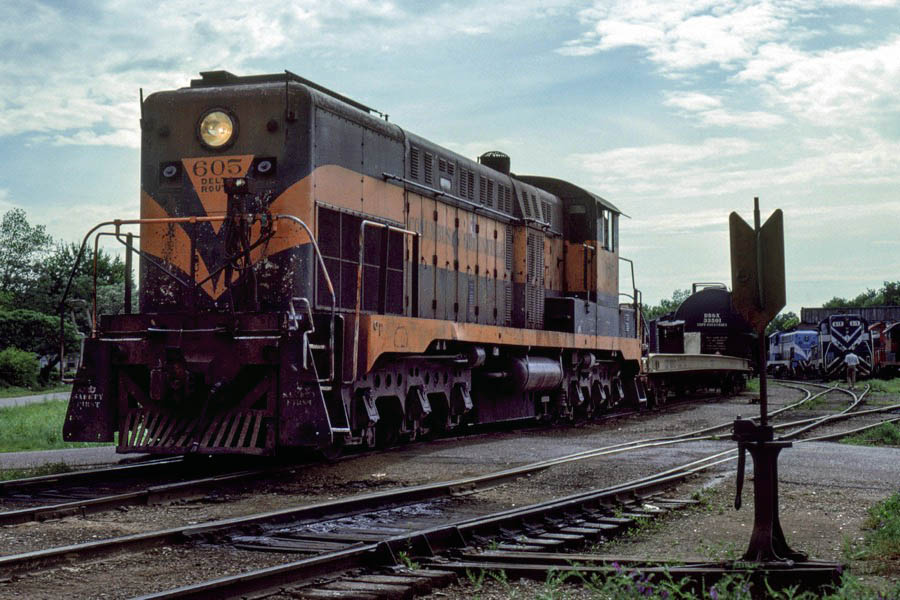
Columbus, Ms / Apr 1981 / Gerhard Anderson
#606

from Diesel Spotter's Guide
- Jerry Pinkepank - 1967 / collection
By 1950, Columbus & Greenville mechanical forces determined that a sixth road switcher was desired, similar to Nos. 601-605, to round out the post-steam power roster. By this time, however, the DRS 6-4-15 was no longer in production; as such, #606 was produced in a batch of 21 model AS-416s. These successor units were similar to the original DRS series, but featured internal mechanical improvements, streamlined external features, and improved trucks. Only the original Norfolk Southern and the Savannah & Atlanta joined the C&G as AS-416 customers. The AS-616, with 6 powered axles, proved a better seller.
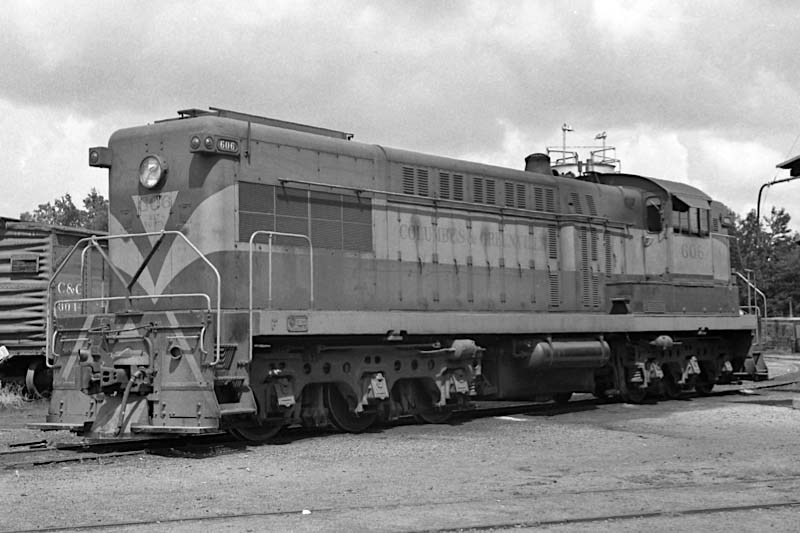
Columbus & Greenville #606
Columbus, Ms / Sep 1969 / JCH


Columbus & Greenville #606
retired 1984, stored
to Illinois Railway Museum

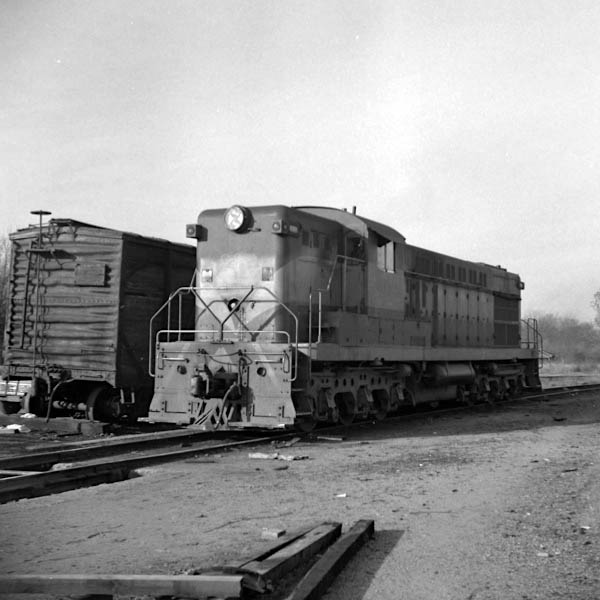
Columbus, Ms / Dec 1971 / JCH
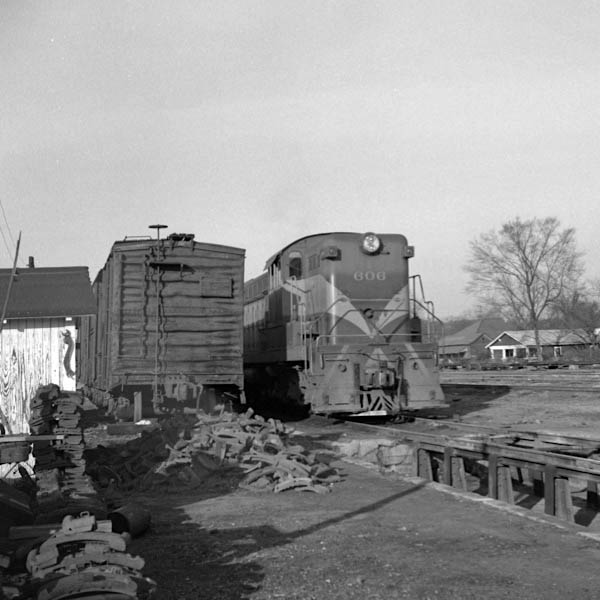
Columbus, Ms / Dec 1971 / JCH

Columbus, Ms / May 1964 / collection
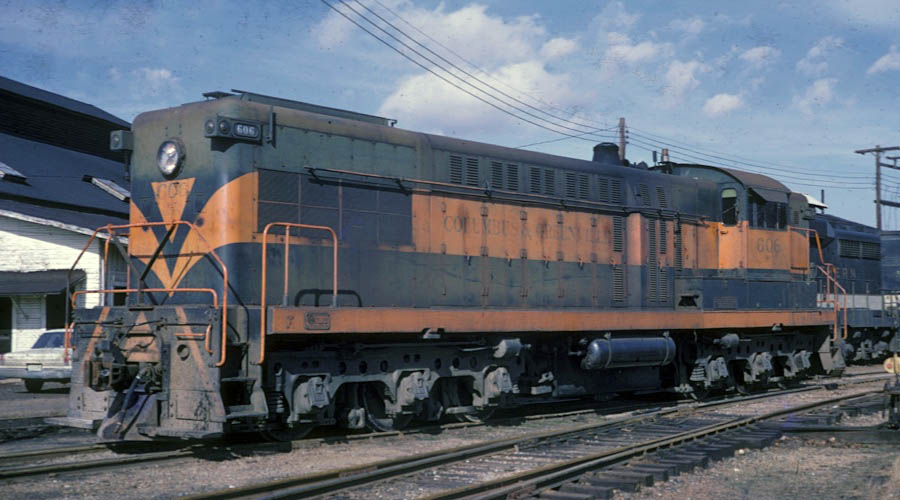
Columbus, Ms / 1972 / collection
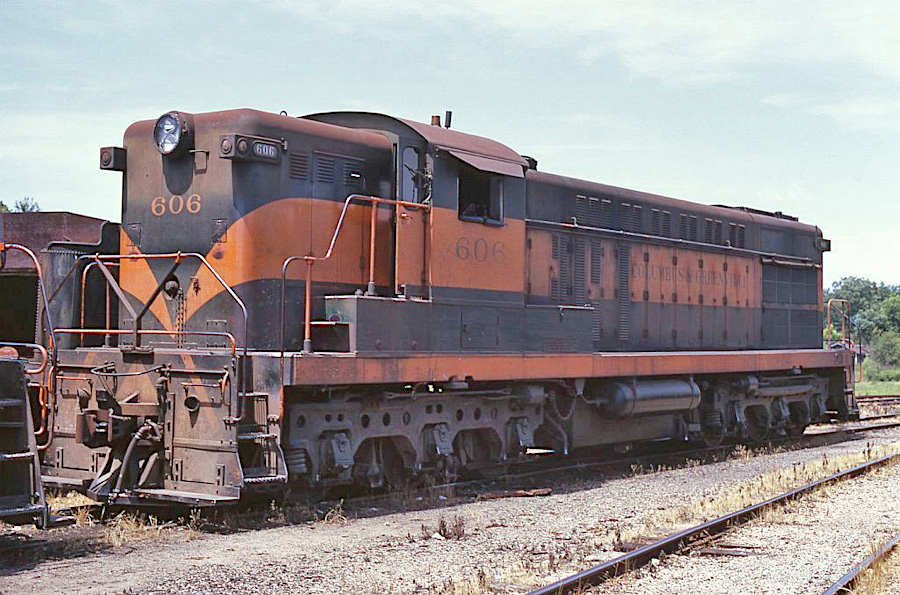
Columbus, Ms / Jun 1974 / Doug Leffler

Columbus, Ms / Jun 1974 / Doug Leffler
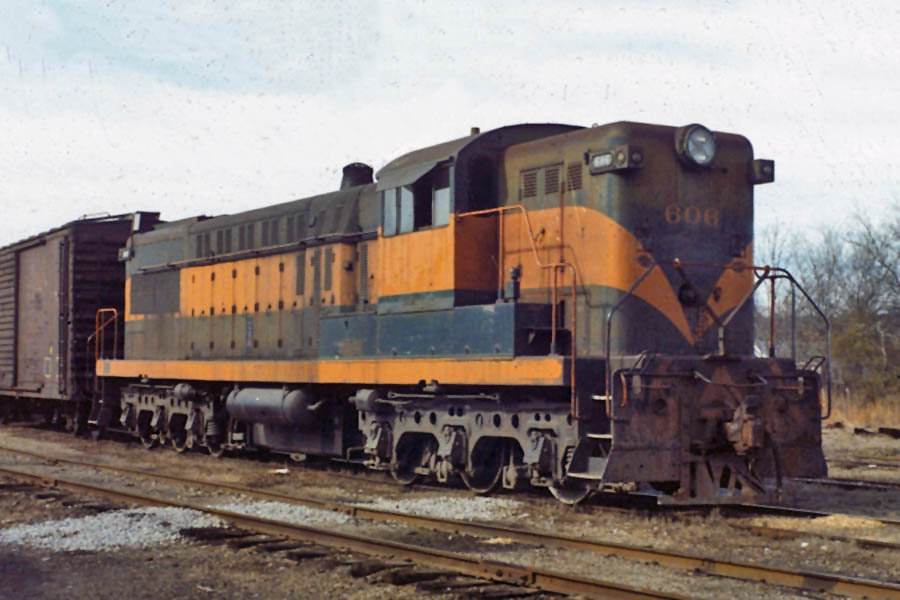
Columbus, Ms / 1979 / collection
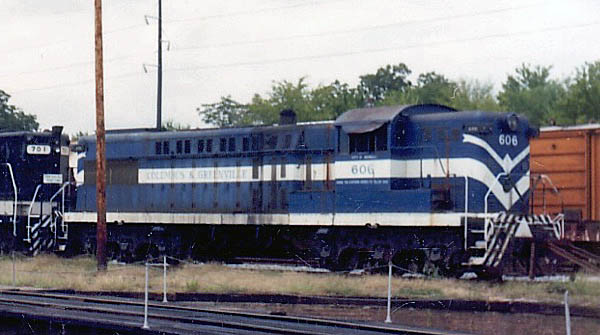
Columbus, Ms / Sep 1986 / RWH
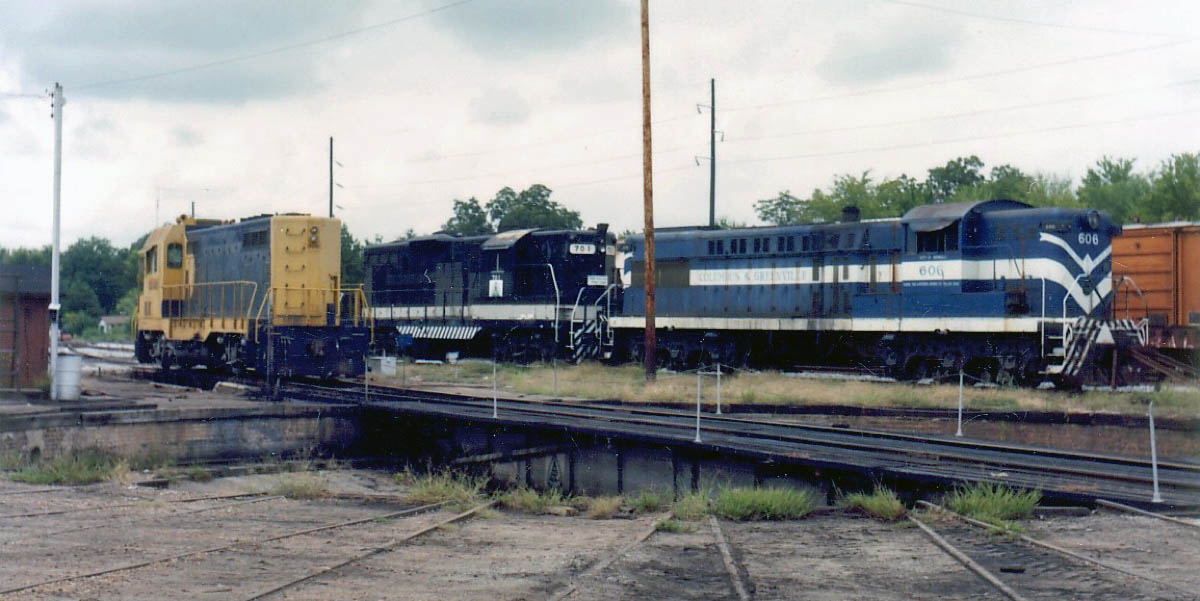
Columbus, Ms / Sep 1986 / RWH
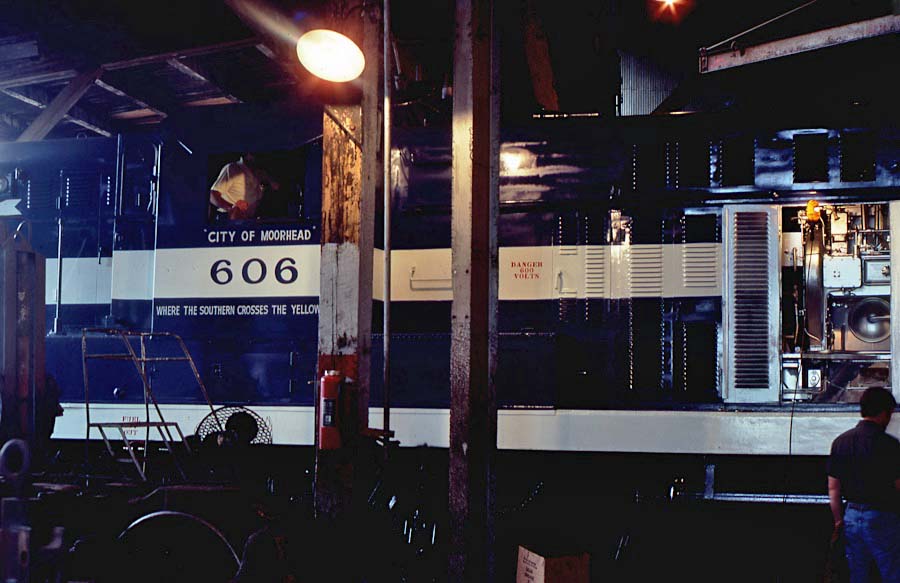
Columbus, Ms / Aug 1979 / David Hurt

Greenwood, Ms / Dec 1982 / collection

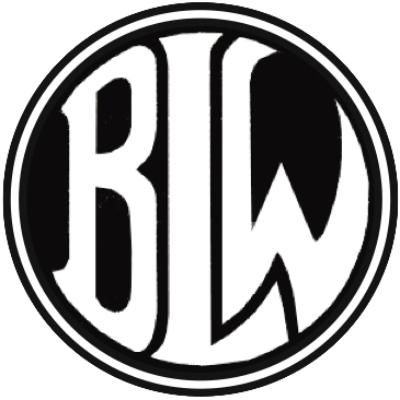 The heritage of Baldwin remains. Over 1800 switchers from that company entered service on American rails in the 20 years that Baldwin made diesel locomotives. Most of these are extant. Of the over 500 road-switchers and more than 250 freight cab units, there are fewer survivors because trade-in has been made so attractive by the remaining builders. But wherever Baldwins are still in service or the memory is fresh, men will say a good word for their rugged nature, and tell you that they need no apologist. They took the worst the railroads had to offer, and they did the job.
The heritage of Baldwin remains. Over 1800 switchers from that company entered service on American rails in the 20 years that Baldwin made diesel locomotives. Most of these are extant. Of the over 500 road-switchers and more than 250 freight cab units, there are fewer survivors because trade-in has been made so attractive by the remaining builders. But wherever Baldwins are still in service or the memory is fresh, men will say a good word for their rugged nature, and tell you that they need no apologist. They took the worst the railroads had to offer, and they did the job.
Jerry Pinkepank — "On Behalf of Baldwin" — TRAINS, December 1967
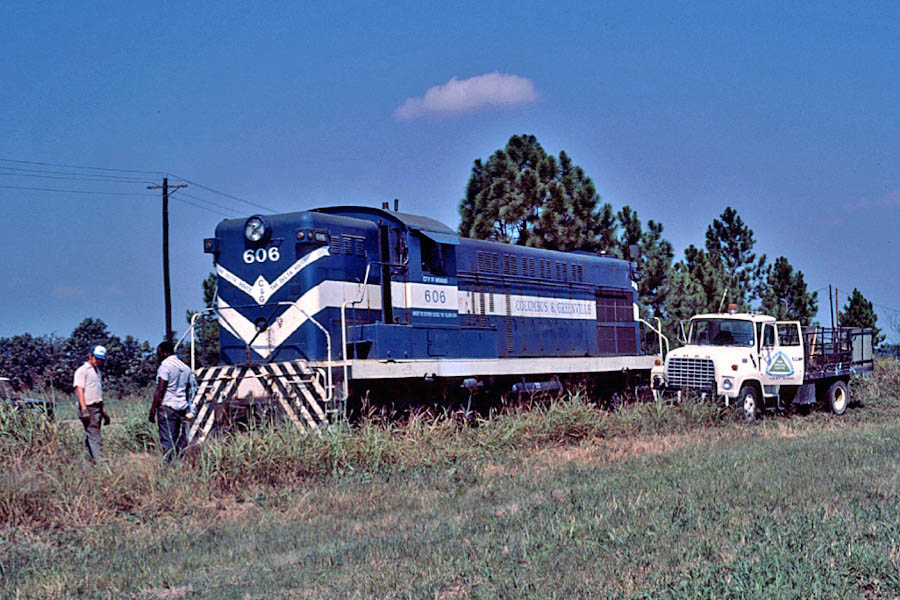
Indianola, Ms / Oct 1982 / Louis Saillard
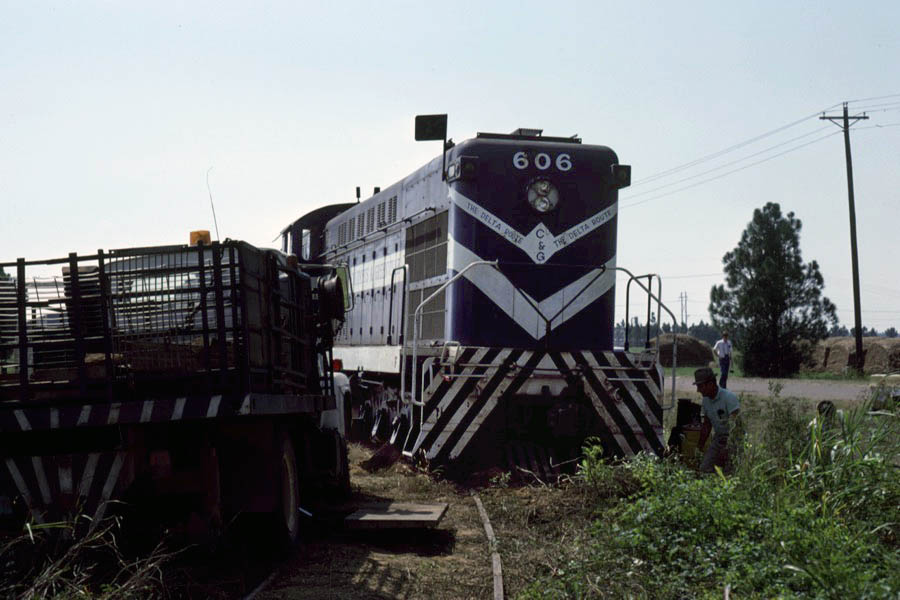
Indianola, Ms / Oct 1982 / Gerhard Anderson

See also Spotlight: Baldwin #606 in our Greenville, Mississippi scrapbook
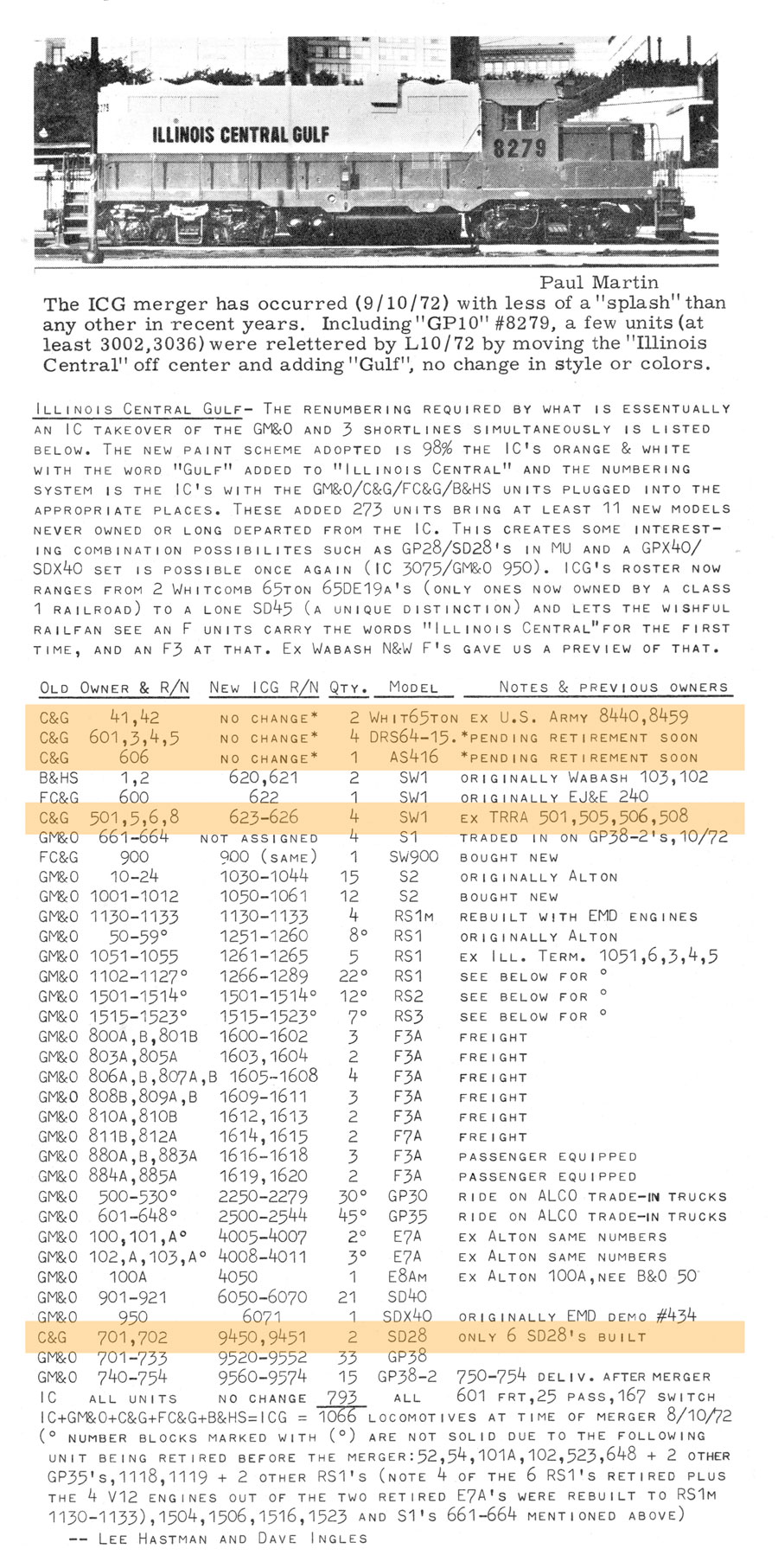
from EXTRA 2200 South
magazine - Sep 1972 / collection
 Article
Article
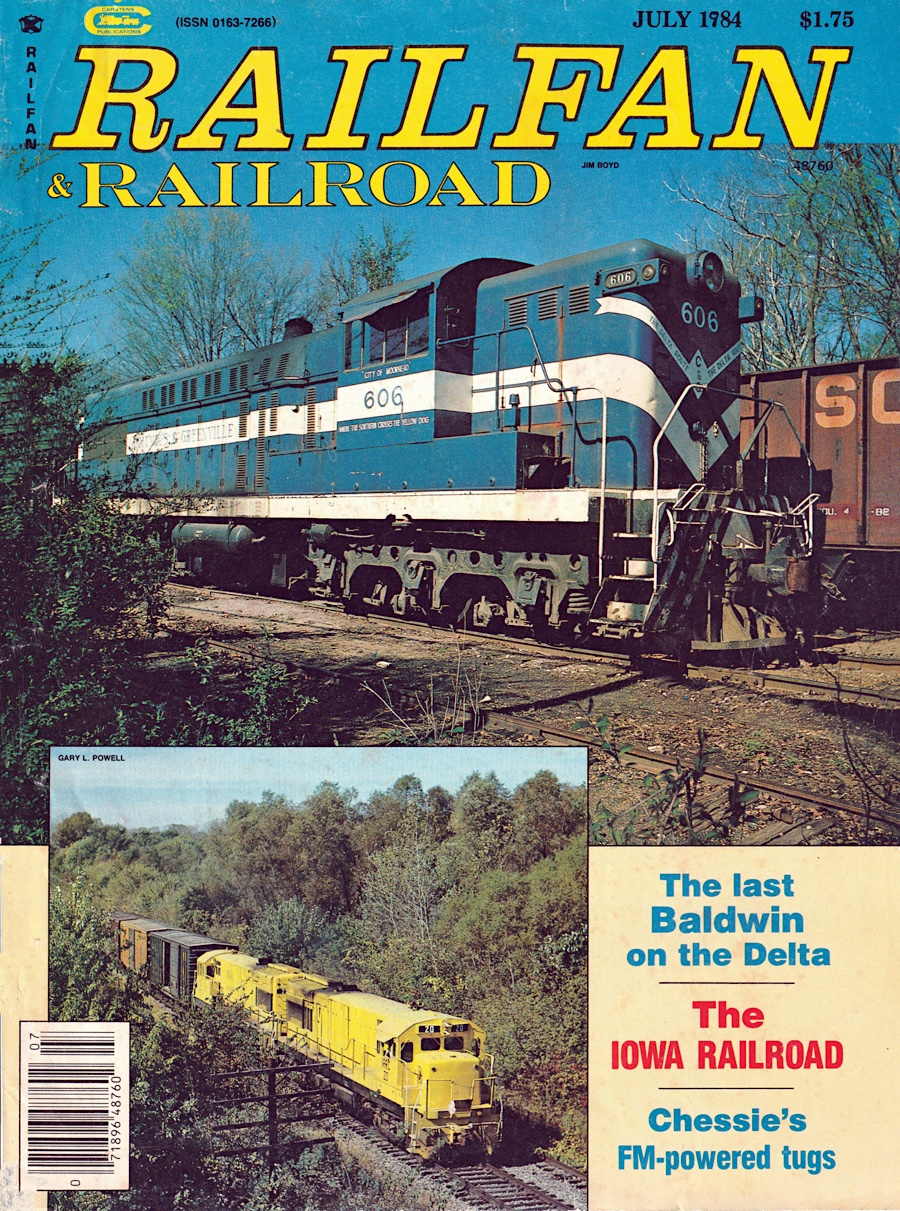
collection


from Railfan & Railroad
magazine - Jul 1984 / collection
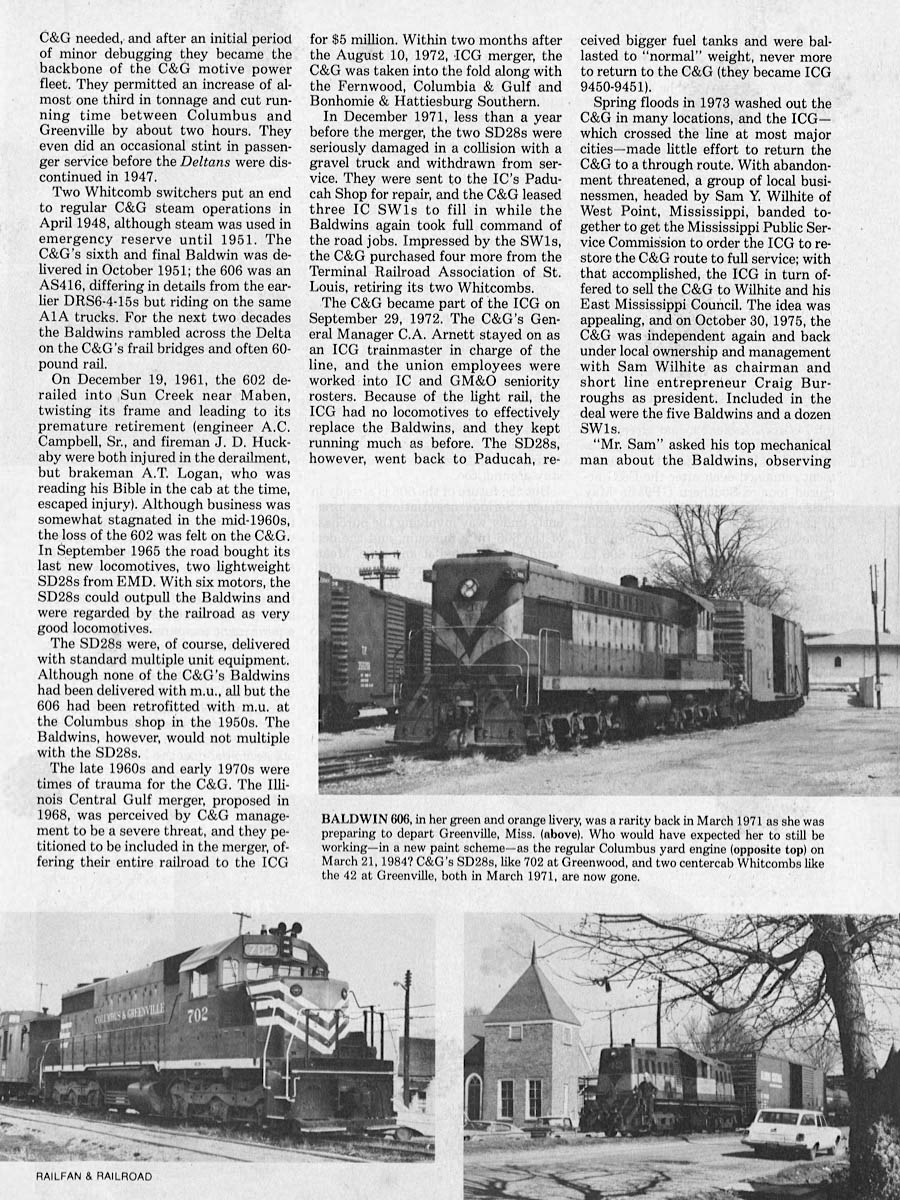
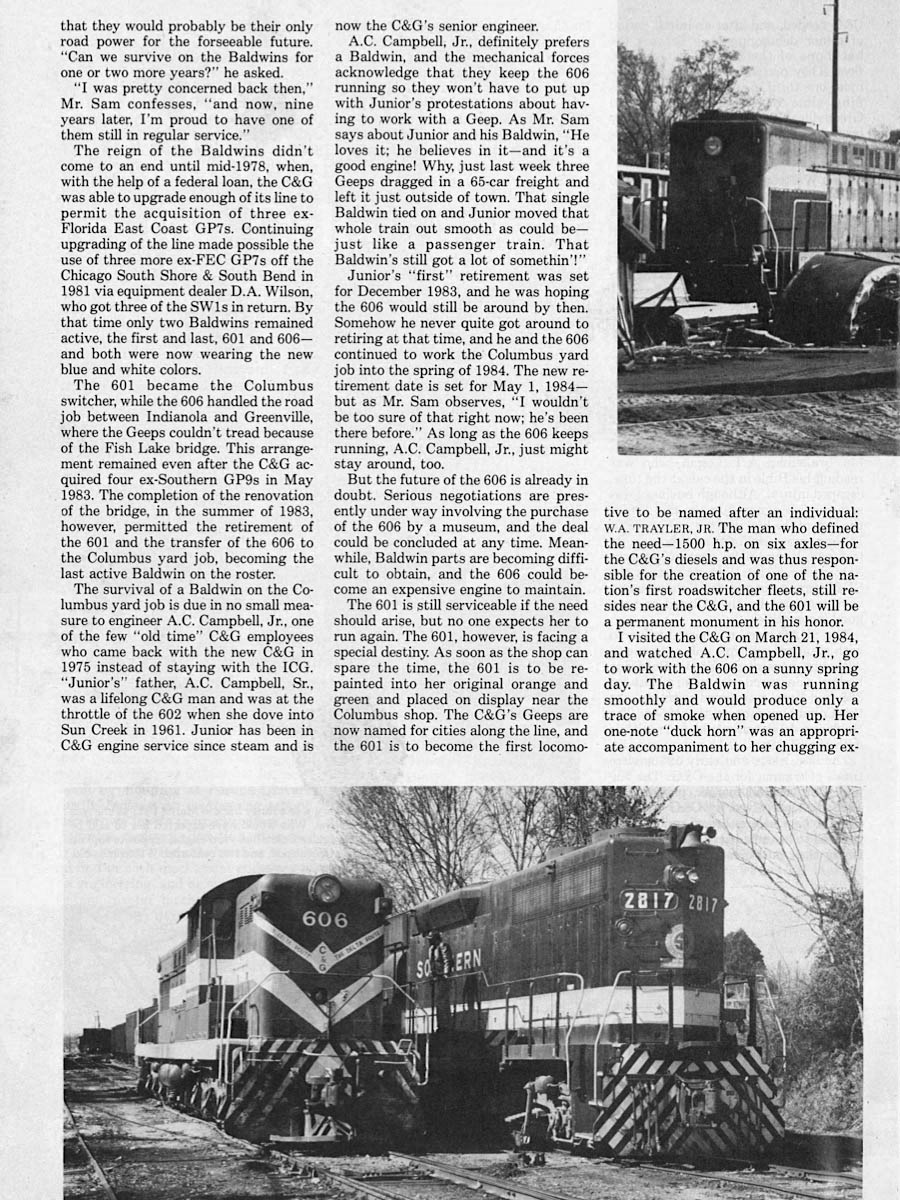
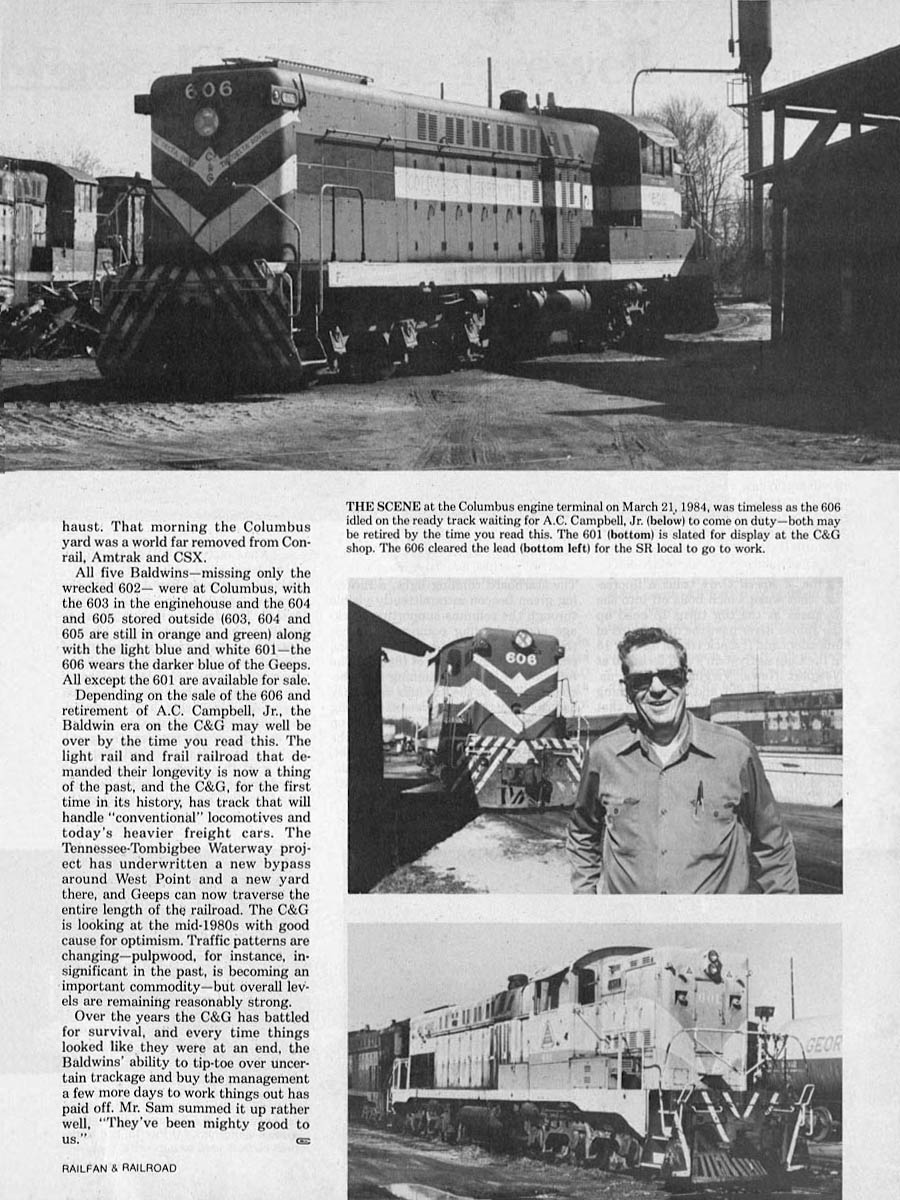
 Baldwin #606 Preserved
Baldwin #606 Preserved

 In the fall of 2009, my family traveled to Chicago to visit close friends. This was my first visit to Chicagoland by car, so I set aside a day in the schedule to visit the impressive Illinois Railway Museum. For years it was a goal of mine to see their massive collection, but in truth it was two Deep South locomotives on the site that most drew me on a must-see pilgrimage: T.R. Miller Mill's diminutive kettle #101 and, of course, Columbus & Greenville #606. The IRM is a massive museum, covering acres of land, so it took me the better part of the day to find our beloved Baldwin hood unit hidden away in a series of display tracks (see below). It had been 20 years since I last laid eyes on the locomotive — finding her in 1989 tucked in the weeds of a scrapper's siding in Greenville, Ms — so I was not certain what to expect at IRM. Streaked in rust, the carbody certainly bears the marks of two decades in the elements. Her cab windows are boarded over, the underbody fuel tank is missing, and the strange gash in the long hood near the generator — first discovered in Greenville in '89 — still remains. Otherwise, the old Baldwin is holding her own in retirement up north. Still marked "City of Moorhead," I chuckled at the oddity of this Mississippi machine rusting away on the outskirts of Chicago. Parked next to Burlington Northern F-units and in the shadow of Union Pacific's massive gas turbine set, #606 seems like an odd choice for a midwestern museum. Even so, I'm not complaining. A little eccentricity beats the scrapper's torch any day. (I wonder: Does anyone in Illinois even know about the Yellow Dog diamond?)
In the fall of 2009, my family traveled to Chicago to visit close friends. This was my first visit to Chicagoland by car, so I set aside a day in the schedule to visit the impressive Illinois Railway Museum. For years it was a goal of mine to see their massive collection, but in truth it was two Deep South locomotives on the site that most drew me on a must-see pilgrimage: T.R. Miller Mill's diminutive kettle #101 and, of course, Columbus & Greenville #606. The IRM is a massive museum, covering acres of land, so it took me the better part of the day to find our beloved Baldwin hood unit hidden away in a series of display tracks (see below). It had been 20 years since I last laid eyes on the locomotive — finding her in 1989 tucked in the weeds of a scrapper's siding in Greenville, Ms — so I was not certain what to expect at IRM. Streaked in rust, the carbody certainly bears the marks of two decades in the elements. Her cab windows are boarded over, the underbody fuel tank is missing, and the strange gash in the long hood near the generator — first discovered in Greenville in '89 — still remains. Otherwise, the old Baldwin is holding her own in retirement up north. Still marked "City of Moorhead," I chuckled at the oddity of this Mississippi machine rusting away on the outskirts of Chicago. Parked next to Burlington Northern F-units and in the shadow of Union Pacific's massive gas turbine set, #606 seems like an odd choice for a midwestern museum. Even so, I'm not complaining. A little eccentricity beats the scrapper's torch any day. (I wonder: Does anyone in Illinois even know about the Yellow Dog diamond?)

Columbus & Greenville #606
Union, Il / Sep 2009 / RWH
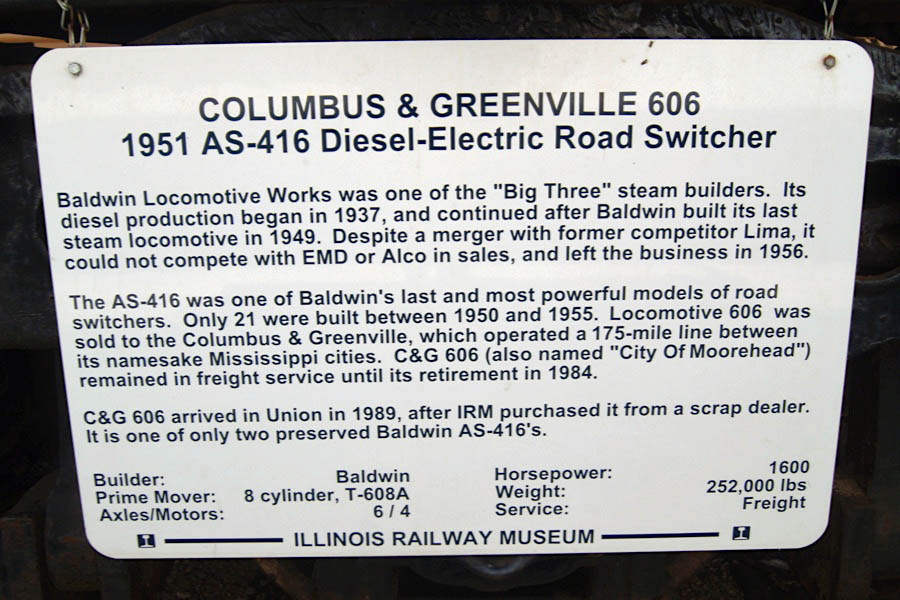
Sep 2009 / RWH

As for the 606 at the Illinois Railway Museum, the C&G sold 603, 604, 605 and 606 and the two Whitcombs to the Friedman Metals scrap yard in Greenville. I photographed the 605 there soon to be cut up in August of 1984. The IRM purchased the loco from Friedman. When it was shipped out (by then carrying IRM's own set of railroad reporting marks) the C&G also donated all the remaining BLW parts and sent them along (including a new BLW crankshaft).
Louis Saillard

Union, Il / Sep 2009 / RWH
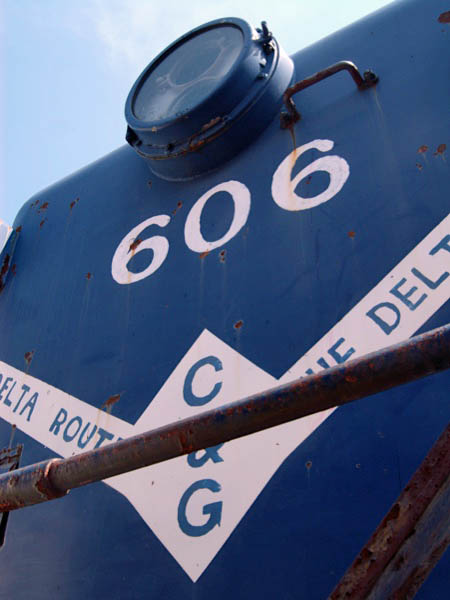
Sep 2009 / RWH
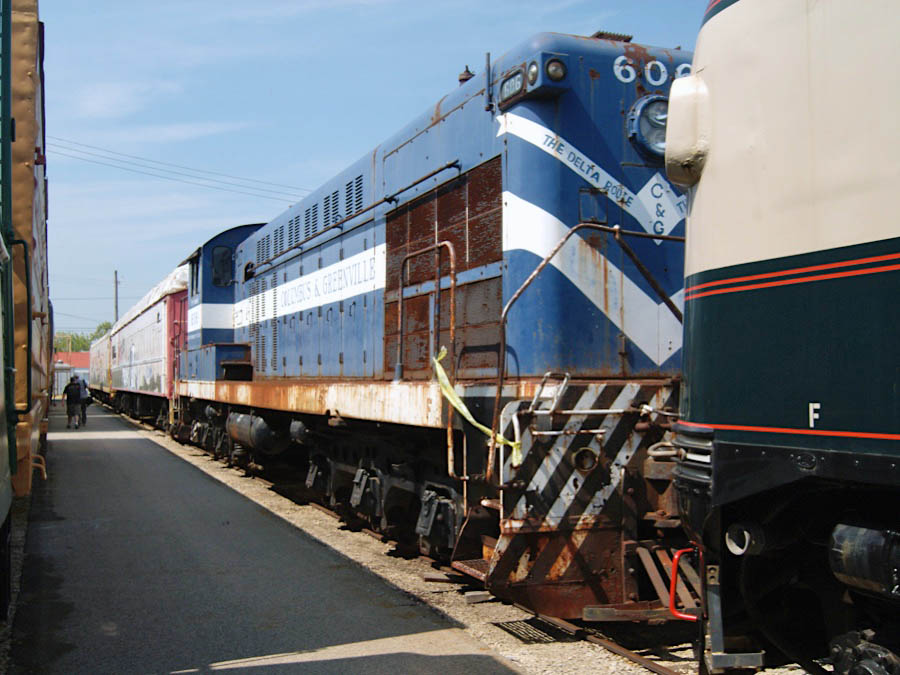
Union, Il / Sep 2009 / RWH

See also our complete Illinois Railway Museum scrapbook in Preservation
 Article
Article
Diesels on the "Delta Route"
by W. A. TRAYLER, JR. — Master Mechanic, Columbus & Greenville Railway Company
The Columbus & Greenville Railway Company — popularly known as the "Delta Route"— operates a modern 168-mile railroad in the State of Mississippi. Although its track mileage is short, its relative importance is great, as it provides dependable freight service through the Mississippi Valley, and interchanges freight with several important trunk line railroads. Interchange is made with the Southern Railway and the St. Louis-San Francisco Railway at Columbus; with the Gulf, Mobile & Ohio Railroad at Columbus, West Point and Mathiston; and with the Illinois Central Railroad at West Point, Winona, Greenwood, Moorhead, Elizabeth, Stoneville and Greenville.
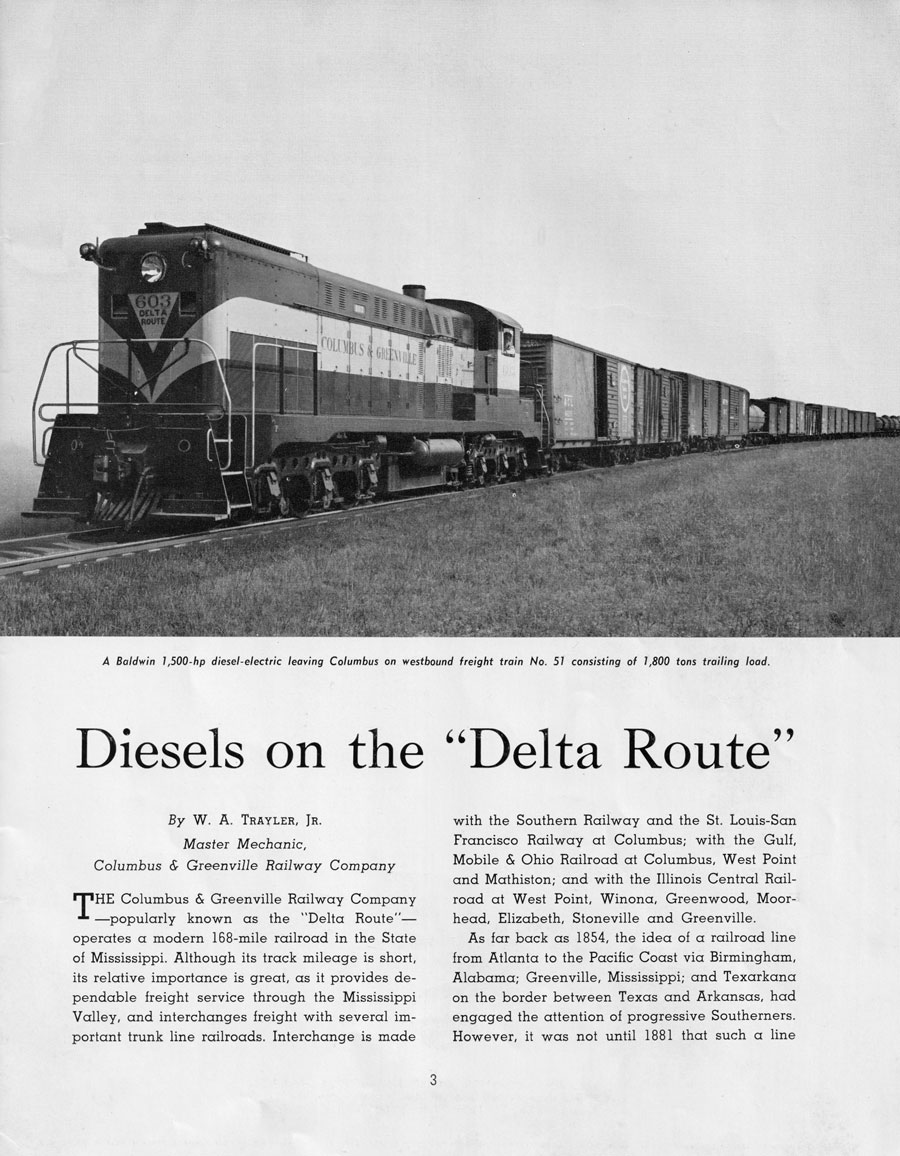 As far back as 1854, the idea of a railroad line from Atlanta to the Pacific Coast via Birmingham, Alabama; Greenville, Mississippi; and Texarkana on the border between Texas and Arkansas, had engaged the attention of progressive Southerners. However, it was not until 1881 that such a line started to take shape in the form of the Georgia Pacific Railroad Company, promoted by General John B. Gordon, a former Confederate Army officer.
As far back as 1854, the idea of a railroad line from Atlanta to the Pacific Coast via Birmingham, Alabama; Greenville, Mississippi; and Texarkana on the border between Texas and Arkansas, had engaged the attention of progressive Southerners. However, it was not until 1881 that such a line started to take shape in the form of the Georgia Pacific Railroad Company, promoted by General John B. Gordon, a former Confederate Army officer.
One of the lines absorbed by the new company was the Greenville, Columbus and Birmingham, a narrow gauge line that had its beginning in 1878 and which had already laid track from Greenville to Greenwood, a distance of some fifty-five miles. In 1889, the first through passenger train covered the distance between Columbus and Greenville and the present road was established in fact, if not in name. The line passed through many hands, including those of the United States Government during World War I, and it was not until November 6, 1920, that its charter was amended to provide for its independent existence as the Columbus & Greenville Railroad Company. After passing through receivership, from which it emerged in 1923, the road went ahead rapidly, improving its rolling stock and equipment to enable it to offer the best possible service to the communities along its lines.
In line with this progressive policy, the management of the road first turned to diesel locomotives in October, 1946, when the first of five Baldwin-Westinghouse, 1,500hp diesel-electric locomotives went into service. The last of the five was delivered in January, 1947, and two rebuilt 566-hp Whitcomb switchers were added in April,1948. This completed the dieselization of the line with all-Baldwin equipment.
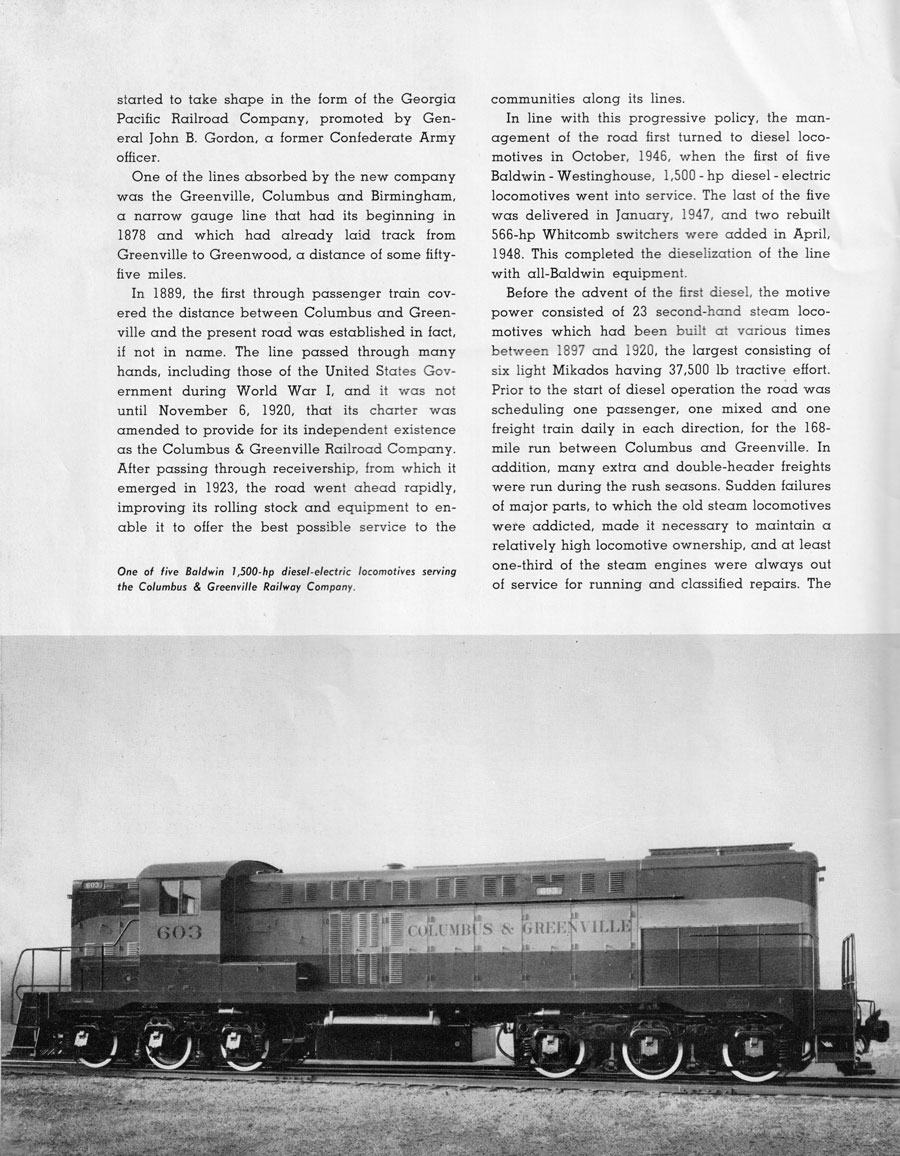 Before the advent of the first diesel, the motive power consisted of 23 second-hand steam locomotives which had been built at various times between 1897 and 1920, the largest consisting of six light Mikados having 37,500 lb tractive effort. Prior to the start of diesel operation the road was scheduling one passenger, one mixed and one freight train daily in each direction, for the 168-mile run between Columbus and Greenville. In addition, many extra and double-header freights were run during the rush seasons. Sudden failures of major parts, to which the old steam locomotives were addicted, made it necessary to maintain a relatively high locomotive ownership, and at least one-third of the steam engines were always out of service for running and classified repairs. The diesels, because of their high availability, offered the natural solution for this difficulty.
Before the advent of the first diesel, the motive power consisted of 23 second-hand steam locomotives which had been built at various times between 1897 and 1920, the largest consisting of six light Mikados having 37,500 lb tractive effort. Prior to the start of diesel operation the road was scheduling one passenger, one mixed and one freight train daily in each direction, for the 168-mile run between Columbus and Greenville. In addition, many extra and double-header freights were run during the rush seasons. Sudden failures of major parts, to which the old steam locomotives were addicted, made it necessary to maintain a relatively high locomotive ownership, and at least one-third of the steam engines were always out of service for running and classified repairs. The diesels, because of their high availability, offered the natural solution for this difficulty.
Under diesel operation, one freight train which carries an express car, and one ordinary freight train are scheduled daily in each direction. There are no "through" freight trains in the ordinary sense of the word. Rather, all locomotives assigned to trains handle local and transfer work except at the few points where yard engines are assigned. One Whitcomb is assigned to Columbus yard for two shifts, the other to Greenwood yard for a single shift. The Baldwin diesels handle the switching assignments at Greenville during their layover periods.
Present operation does not include any regular assignments for steam power and all but two of the old steam locomotives have been dismantled. One light 4-6-0 type is kept at Greenville for emergency use. In addition, one heavy 4-6-0 type is stored at Columbus. These two locomotives will probably be retired at their flue expiration date.
 Four Baldwin diesels are required to operate the two freight trains now scheduled daily in each direction. This leaves only one Baldwin to be held for heavy repairs, or to protect the other six locomotives. Fuel consumption of the Baldwin diesels averages about 750 gallons for a round trip, consisting of 336 miles on the main line, 10 to 16 hours road switching enroute, and 8 hours yard switching at Greenville. The Whitcombs use about 50 gallons of fuel per 8-hour shift. These figures represent a substantial fuel saving as compared with the former steam operation.
Four Baldwin diesels are required to operate the two freight trains now scheduled daily in each direction. This leaves only one Baldwin to be held for heavy repairs, or to protect the other six locomotives. Fuel consumption of the Baldwin diesels averages about 750 gallons for a round trip, consisting of 336 miles on the main line, 10 to 16 hours road switching enroute, and 8 hours yard switching at Greenville. The Whitcombs use about 50 gallons of fuel per 8-hour shift. These figures represent a substantial fuel saving as compared with the former steam operation.
The greatest savings effected by the diesels, of course, are in train operation and fall into several groups:
1. No time lost cleaning fires, dumping ashpans, or taking coal and water.
2. About one-third less time required for making the same moves in road switching at way stations, transfers and making up trains.
3. Only half the former distance and time required in getting trains up to running speed after slow-downs and stops.
4. Minimum speed on ruling grades now 10 mph instead of "each exhaust may be the last one."
5. The Baldwins handle 331 percent more tonnage on ruling grades than was possible with the largest steam locomotives.
One or two concrete examples will illustrate how these savings are made. With the diesel power, three freight trains (one westbound and two eastbound or vice versa) can handle a total of 100 revenue loads along with the average number of Company deadheads and empties, with an average time of 13 hours from terminal to terminal. With steam locomotives, four trains were required, and the average time was 15 hours.
 Four trains pulled by diesels have handled as high as 150 revenue loads with Company cars and empties added. This business would have required five steam trains plus double-heading on two out of the five, and the time consumed would have been close to 16 hours.
Four trains pulled by diesels have handled as high as 150 revenue loads with Company cars and empties added. This business would have required five steam trains plus double-heading on two out of the five, and the time consumed would have been close to 16 hours.
The Baldwins handle 1,600 tons trailing load on the road's steepest grade of 1.6 per cent, at the continuous rating speed of 10 mph. The Whitcombs handle 1,200 tons in yard and transfer service.
The character of the repair and maintenance work required by diesel locomotives is, of course, radically different from that required to maintain steam power. To provide for diesel servicing, four stalls adjacent to the machine shop were parti- tioned off and double doors provided at each track entrance.
Tracks 1 and 2 are served by an old Y-head, air-hydraulic drop pit jack and an overhead, hand- operated, 16-ton traveling crane for lifting traction motors, driving wheels, etc., from trucks after they are released from the locomotive. The Bald-wins have six-wheel trucks with the center pair of wheels acting as idlers. The truck wheelbase is long enough to span the bridge rails, and when it is necessary to drop the center pair of wheels for turning, the idlers are wedged up, spring rigging blocked, and the idlers are lowered on the Y-head jack in less than one-half hour.
Track 3 has inspection platforms on both sides at running-board level, and an upper deck at top-of-hood level on one side only. Tracks 2 and 3 are served by a swinging-boom, electric, two-ton hoist, used to handle cylinder heads, sleeves, pis- tons, connecting rods, turbochargers, etc. Track 4 is equipped with an inspection pit and is used mainly for repairs on roadway equipment.
This specialized diesel shop is rapidly paying off in savings, as the roundhouse expense has been reduced about 50 per cent, even though service is provided for several steam locomotives per day under a joint arrangement with another road.
BALDWIN company magazine (Volume 6, Numbers 1 and 2 — First and Second Quarter 1950) / collection
 Scrapbook
Scrapbook
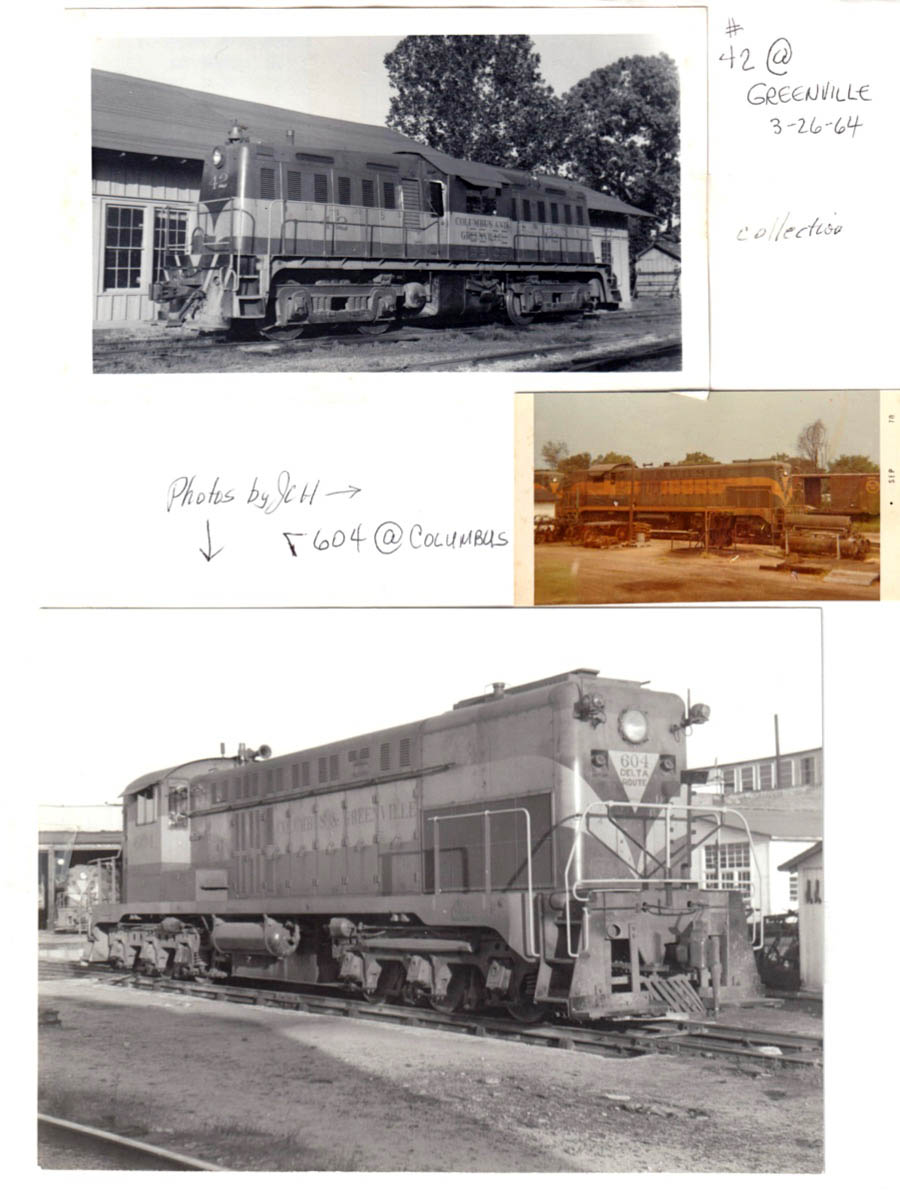
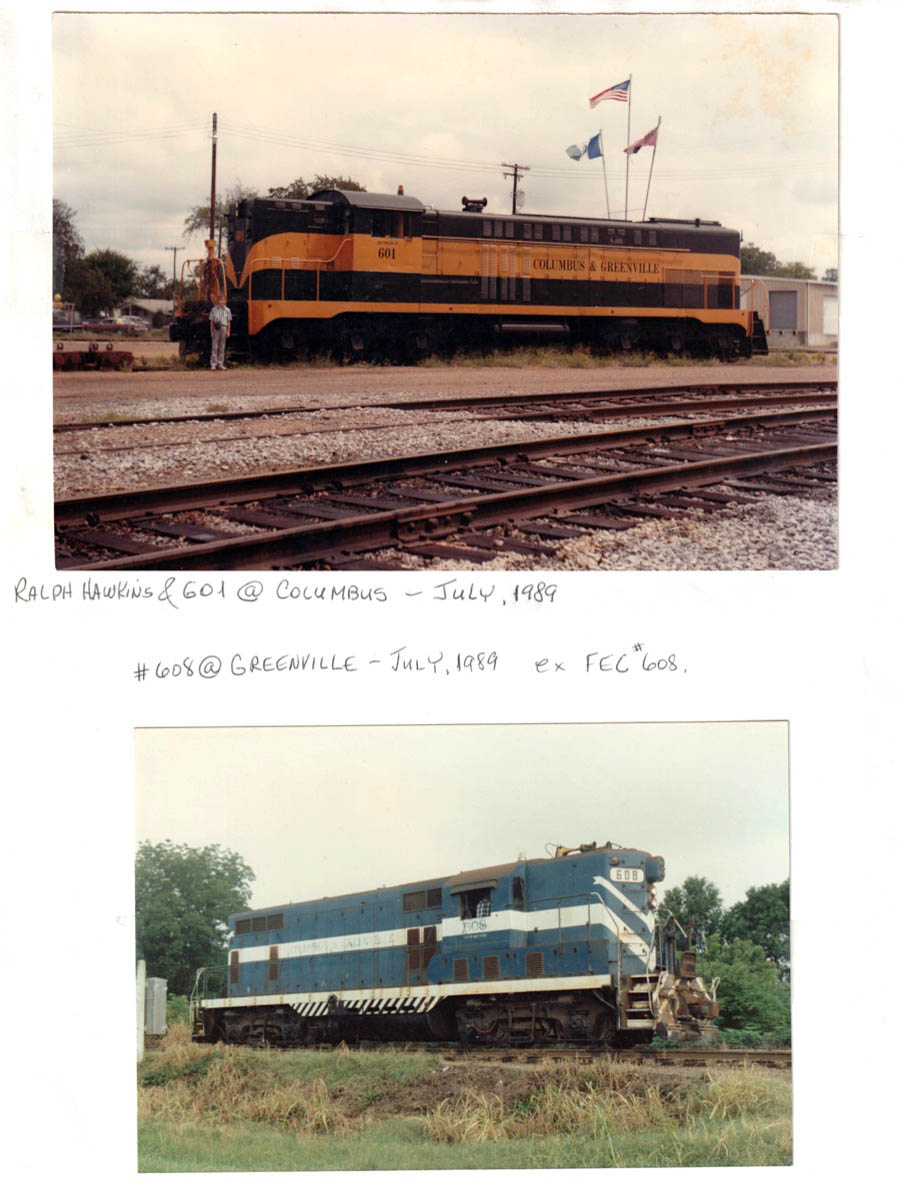


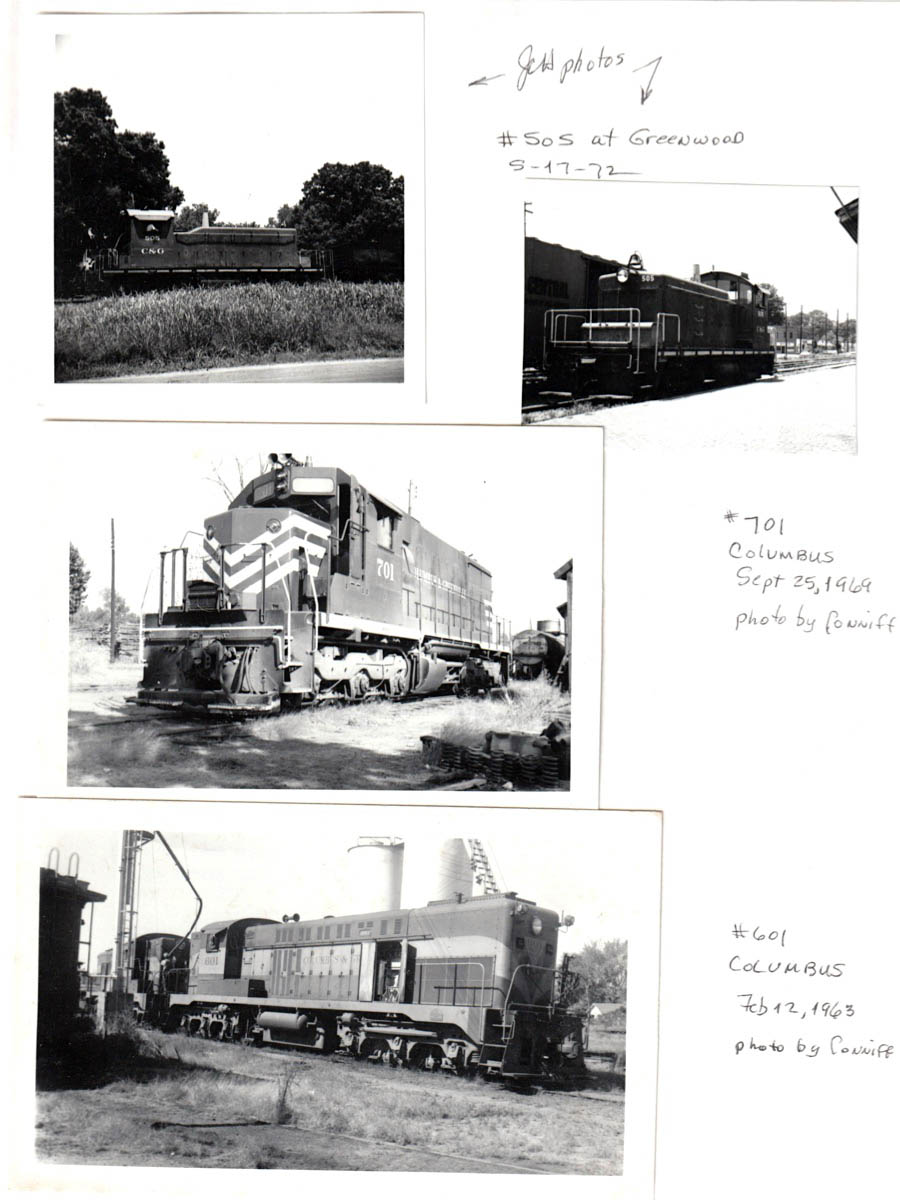
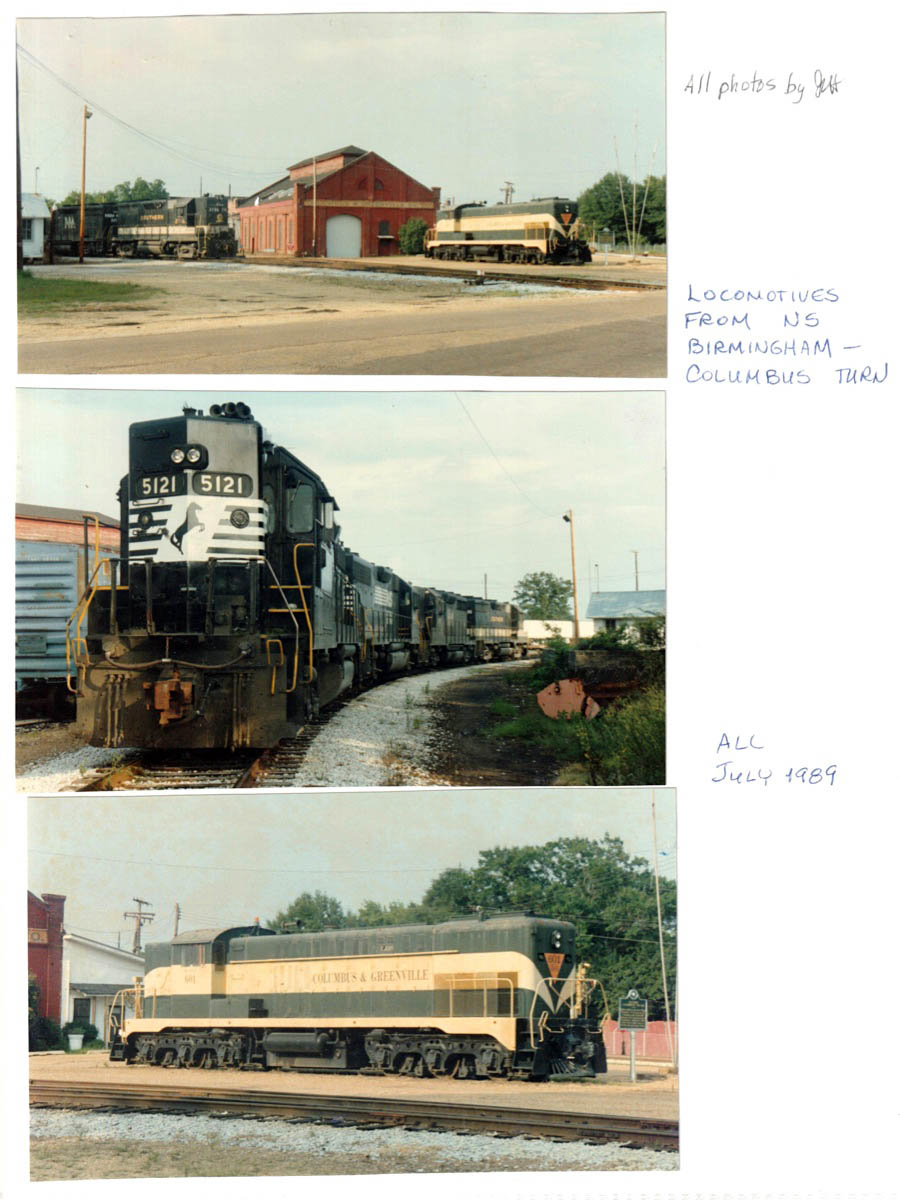
all pages from Columbus & Greenville scrapbook / JCH
Modeling
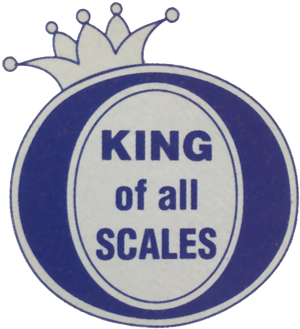
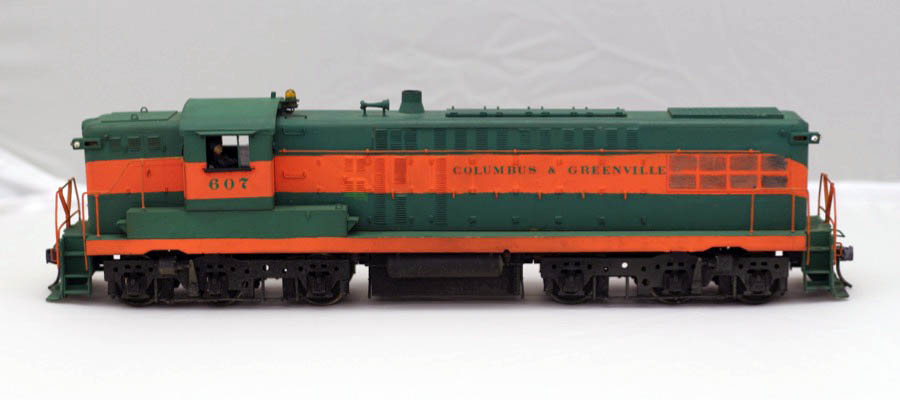
Columbus & Greenville #607
customized Overland Models brass locomotive / Jul 2020 / RWH
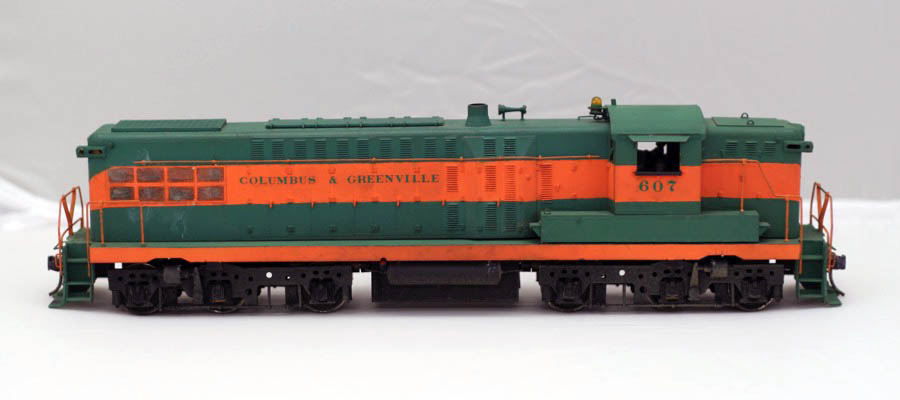
Jul 2020 / RWH
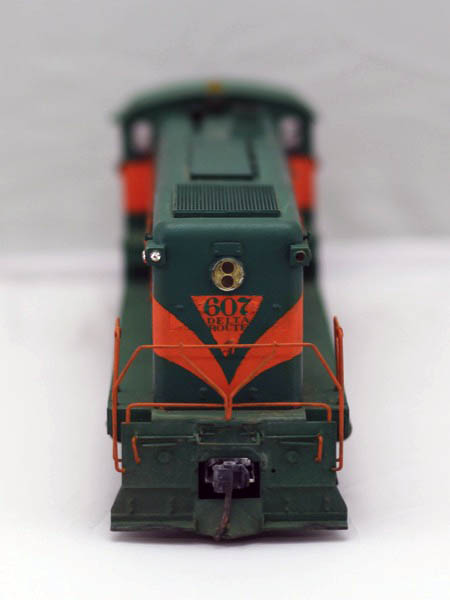
Jul 2020 / RWH
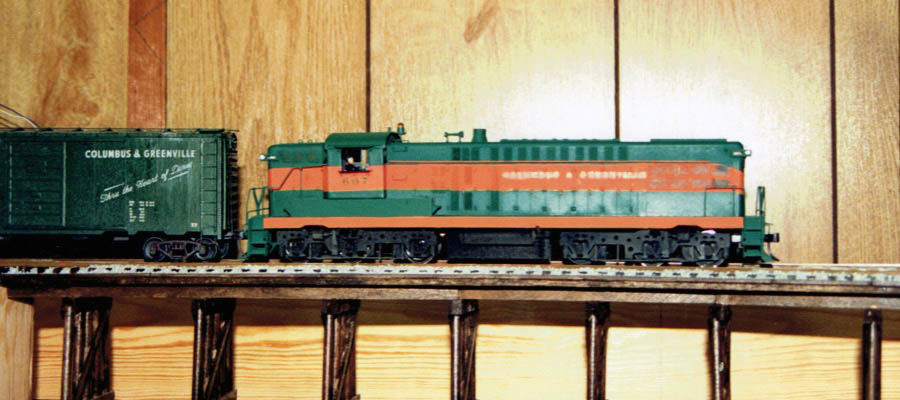
Covington, La / 1986 / JCH
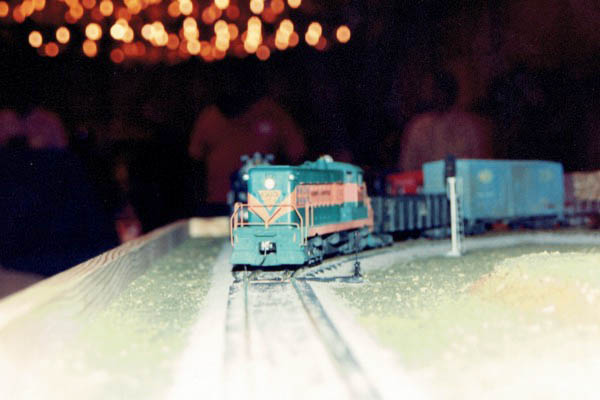
San Antonio, Tx / Jul 1988 / RWH
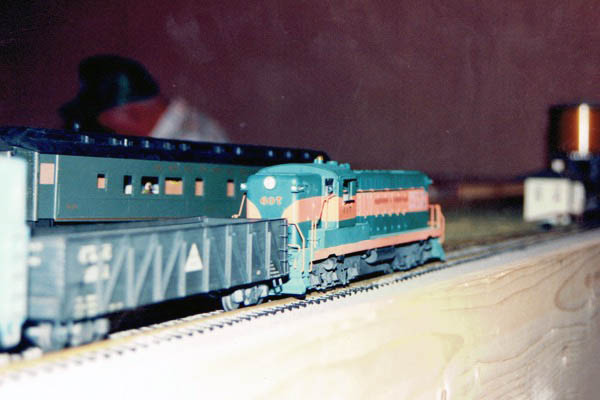
San Antonio, Tx / Jul 1988 / RWH

See also our Columbus & Greenville O Scale Modeling scrapbook
Links / Sources
- Louis R. Saillard, Delta Route: A History of the Columbus & Greenville Railway (1981) 104
- Jerry Pinkepank, The Diesel Spotter's Guide (Kalmbach, 1967) BLW 23-24
- Gary Dolzall and Stephen Dolzall, Diesels from Eddystone: The Story of Baldwin Diesel Locomotives (Kalmbach, 1984)
- Diesel Shop roster for Columbus & Greenville
- Railroad Picture Archives Columbus & Greenville Baldwin roster
- Wikipedia article for Baldwin Locomotive Works
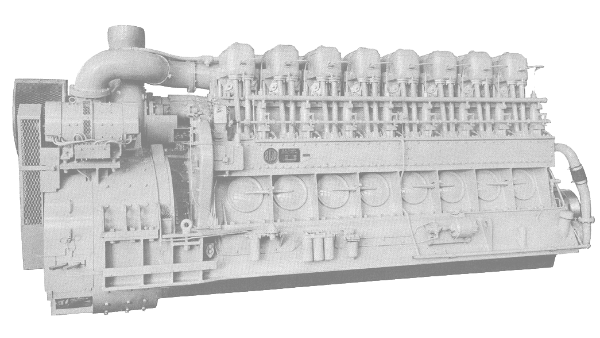
 Complete Columbus & Greenville Baldwin locomotive roster
Complete Columbus & Greenville Baldwin locomotive roster
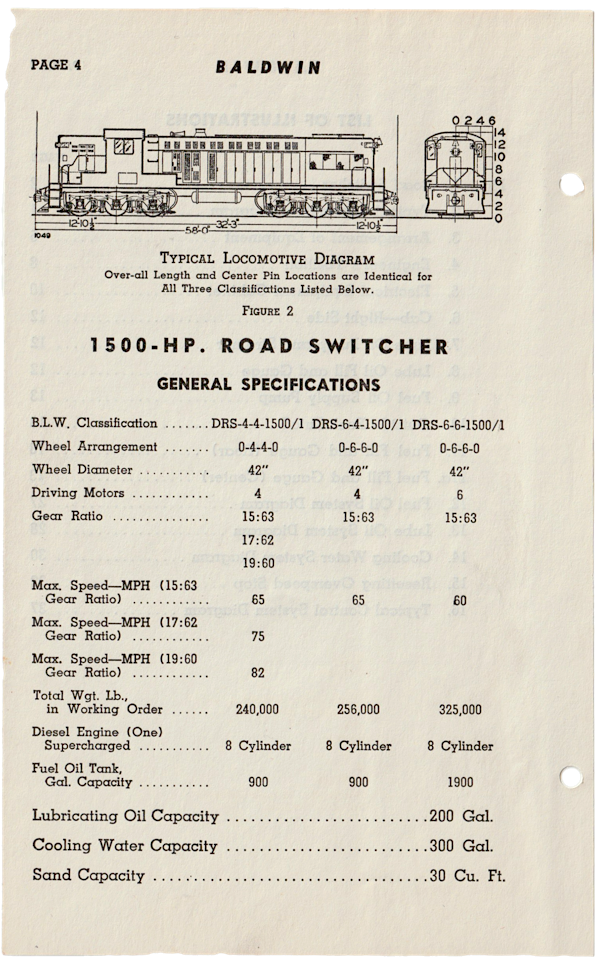

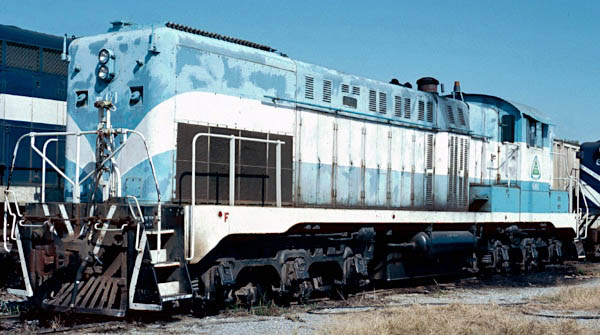

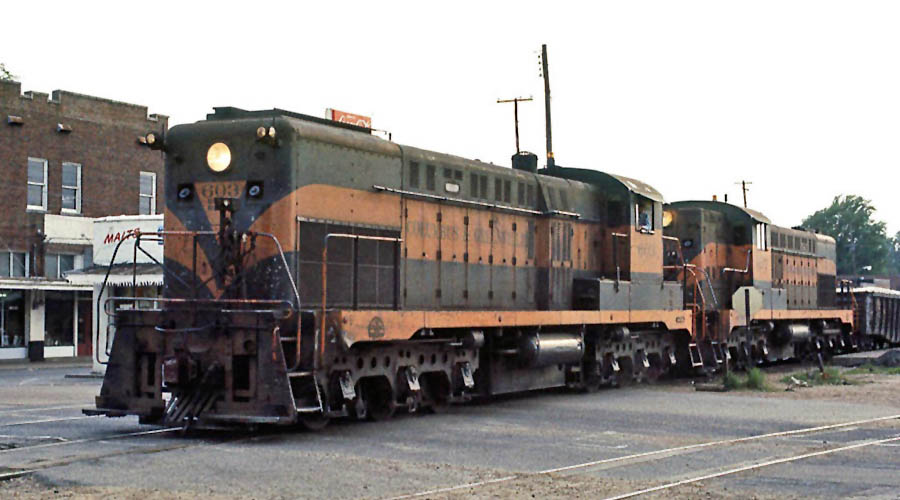

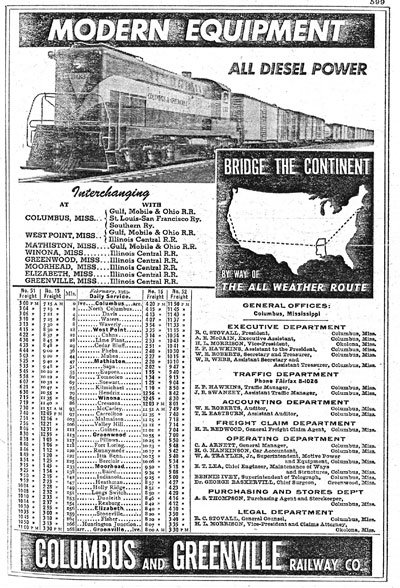

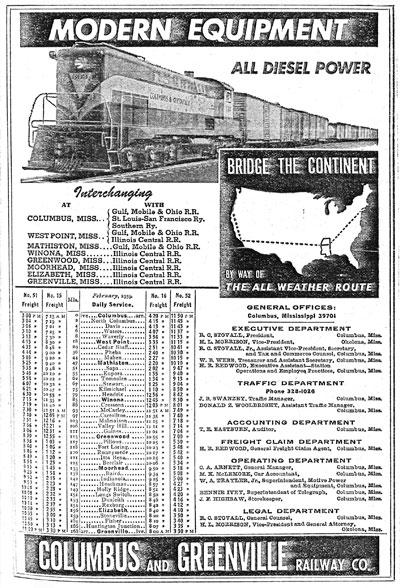
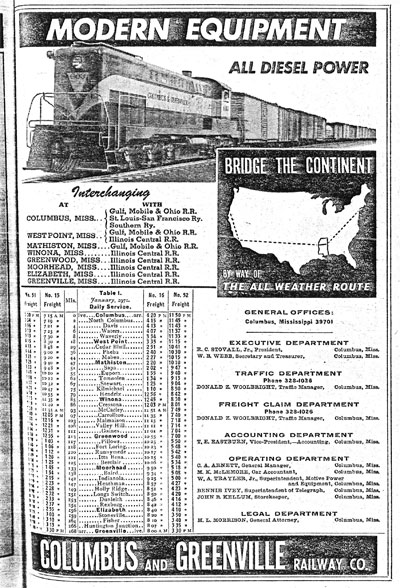
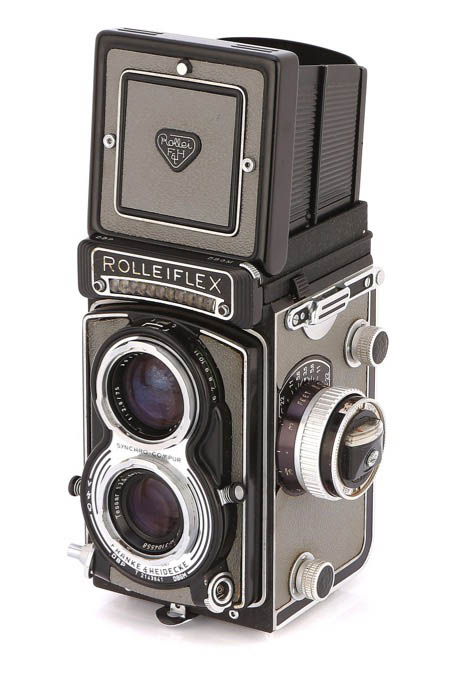 With the IC / GM&O merger long delayed, the locomotives were re-railed and stored in Columbus. They would ultimately be sent to the Illinois Central shop a Paducah, KY for repair.
With the IC / GM&O merger long delayed, the locomotives were re-railed and stored in Columbus. They would ultimately be sent to the Illinois Central shop a Paducah, KY for repair.

